WatchGuard Technologies MF16S32E9W Firebox X Edge User Manual WatchGuard Firebox X Edge User Guide
WatchGuard Technologies, Inc. Firebox X Edge WatchGuard Firebox X Edge User Guide
Users Manual

WatchGuard®
Firebox® X Edge
User Guide
Firebox X Edge - Firmware Version 7.1

ii WatchGuard Firebox X Edge
Certifications and Notices
FCC Certification
This appliance has been tested and found to comply with limits
for a Class A digital appliance, pursuant to Part 15 of the FCC
Rules. Operation is subject to the following two conditions:
- This appliance may not cause harmful interference.
- This appliance must accept any interference received, including
interference that may cause undesired operation.
Changes or modifications not expressly approved by the party
responsible for compliance could void the user's authority to
operate the equipment.
This equipment has been tested and found to comply with the
limits for a Class A digital device, pursuant to Part 15 of the FCC
Rules. These limits are designed to provide reasonable
protection against harmful interference when the equipment is
operated in a commercial environment. This equipment
generates, uses, and can radiate radio frequency energy and, if
not installed and used in accordance with the instruction
manual, may cause harmful interference to radio
communications. Operation of this equipment in a residential
area is likely to cause harmful interference in which case the
user will be required to correct the interference at his own
expense.
CE Notice
The CE symbol on your WatchGuard Technologies equipment
indicates that it is in compliance with the Electromagnetic
Compatibility (EMC) directive and the Low Voltage Directive
(LVD) of the European Union (EU).
Industry Canada
This Class A digital apparatus meets all requirements of the
Canadian Interference-Causing Equipment Regulations.
Cet appareil numerique de la classe A respecte toutes les
exigences du Reglement sur le materiel broulleur du Canada.

Certifications and Notices
User Guide iii
CANADA RSS-210
The term “IC:” before the radio certification number only
signifies that Industry of Canada technical specifications were
met.
Operation is subject to the following two conditions: (1) this
device may not cause interference, and (2) this device must
accept any interference, including interference that may cause
undesired operation of the device.
VCCI Notice Class A ITE
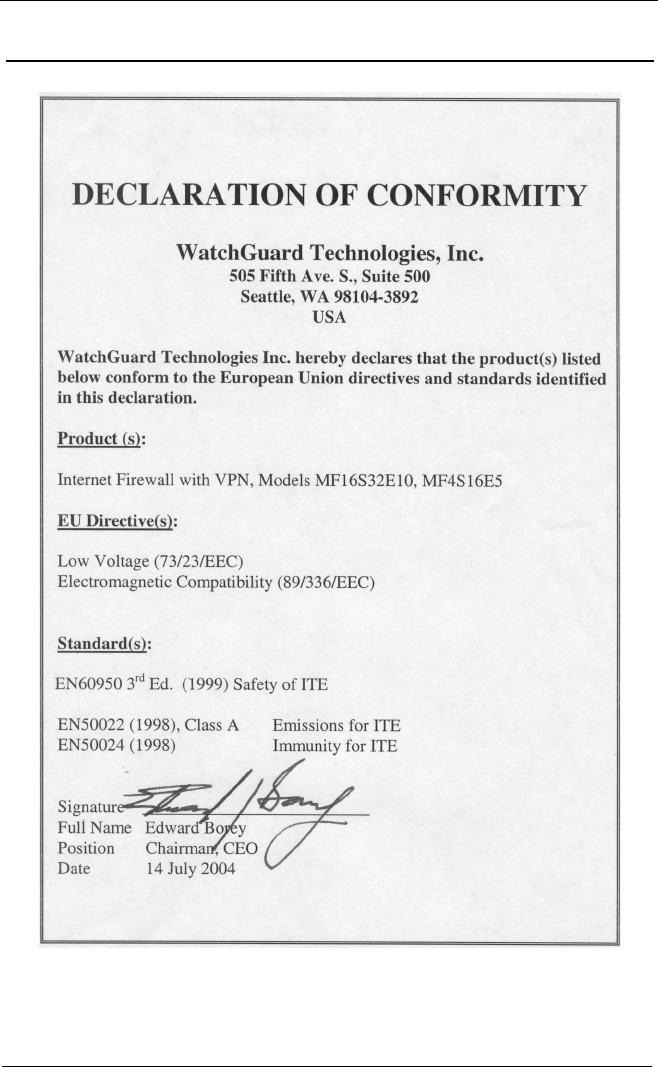
iv WatchGuard Firebox X Edge
Declaration of Conformity

Notice to Users
User Guide v
Notice to Users
Information in this guide is subject to change without notice. Companies, names, and data used in
examples herein are fictitious unless otherwise noted. No part of this guide may be reproduced or
transmitted in any form or by any means, electronic or mechanical, for any purpose, without the express
written permission of WatchGuard Technologies, Inc.
WatchGuard Firebox Software
End-User License Agreement
IMPORTANT - READ CAREFULLY BEFORE ACCESSING WATCHGUARD SOFTWARE:
This Firebox Software End-User License Agreement (“AGREEMENT”) is a legal agreement between you
(either an individual or a single entity) and WatchGuard Technologies, Inc. (“WATCHGUARD”) for the
WATCHGUARD Firebox software product, which includes computer software components (whether
installed separately on a computer workstation or on the WATCHGUARD hardware product or included on
the WATCHGUARD hardware product) and may include associated media, printed materials, and on-line or
electronic documentation, and any updates or modifications thereto, including those received through the
WatchGuard LiveSecurity Service (or its equivalent), (the “SOFTWARE PRODUCT”). WATCHGUARD is willing
to license the SOFTWARE PRODUCT to you only on the condition that you accept all of the terms contained
in this Agreement. Please read this Agreement carefully. By installing or using the SOFTWARE PRODUCT
you agree to be bound by the terms of this Agreement. If you do not agree to the terms of this
AGREEMENT, WATCHGUARD will not license the SOFTWARE PRODUCT to you, and you will not have any
rights in the SOFTWARE PRODUCT. In that case, promptly return the SOFTWARE PRODUCT, along with
proof of payment, to the authorized dealer from whom you obtained the SOFTWARE PRODUCT for a full
refund of the price you paid. The WATCHGUARD hardware product is subject to a separate agreement and
limited hardware warranty included with the WATCHGUARD hardware product packaging and/or in the
associated user documentation.
1. Ownership and License. The SOFTWARE PRODUCT is protected by copyright laws and international
copyright treaties, as well as other intellectual property laws and treaties. This is a license agreement and
NOT an agreement for sale. All title and copyrights in and to the SOFTWARE PRODUCT (including but not
limited to any images, photographs, animations, video, audio, music, text, and applets incorporated into
the SOFTWARE PRODUCT), the accompanying printed materials, and any copies of the SOFTWARE
PRODUCT are owned by WATCHGUARD or its licensors. Your rights to use the SOFTWARE PRODUCT are as
specified in this AGREEMENT, and WATCHGUARD retains all rights not expressly granted to you in this
AGREEMENT. Nothing in this AGREEMENT constitutes a waiver of our rights under U.S. copyright law or
any other law or treaty.
2. Permitted Uses. You are granted the following rights to the SOFTWARE PRODUCT:
(A) You may install and use the SOFTWARE PRODUCT on any single WATCHGUARD hardware product at
any single location and may install and use the SOFTWARE PRODUCT on multiple workstation computers.
(B) To use the SOFTWARE PRODUCT on more than one WATCHGUARD hardware product at once, you
must purchase an additional copy of the SOFTWARE PRODUCT for each additional WATCHGUARD
hardware product on which you want to use it. To the extent that you install copies of the SOFTWARE
PRODUCT on additional WATCHGUARD hardware products in accordance with the prior sentence without
installing the additional copies of the SOFTWARE PRODUCT included with such WATCHGUARD hardware
products, you agree that use of any software provided with or included on the additional WATCHGUARD
hardware products that does not require installation will be subject to the terms and conditions of this
AGREEMENT. You must also maintain a current subscription to the WatchGuard LiveSecurity Service (or its
equivalent) for each additional WATCHGUARD hardware product on which you will use a copy of an
updated or modified version of the SOFTWARE PRODUCT received through the WatchGuard LiveSecurity
Service (or its equivalent).

vi WatchGuard Firebox X Edge
(C) In addition to the copies described in Section 2(A), you may make a single copy of the SOFTWARE
PRODUCT for backup or archival purposes only.
3. Prohibited Uses. You may not, without express written permission from WATCHGUARD:
(A) Use, copy, modify, merge or transfer copies of the SOFTWARE PRODUCT or printed materials except
as provided in this AGREEMENT;
(B) Use any backup or archival copy of the SOFTWARE PRODUCT (or allow someone else to use such a
copy) for any purpose other than to replace the original copy in the event it is destroyed or becomes
defective;
(C) Sublicense, lend, lease or rent the SOFTWARE PRODUCT;
(D) Transfer this license to another party unless
(i) the transfer is permanent,
(ii) the third party recipient agrees to the terms of this AGREEMENT, and
(iii) you do not retain any copies of the SOFTWARE PRODUCT; or
(E) Reverse engineer, disassemble or decompile the SOFTWARE PRODUCT.
4. Limited Warranty. WATCHGUARD makes the following limited warranties for a period of ninety (90) days
from the date you obtained the SOFTWARE PRODUCT from WATCHGUARD or an authorized dealer:
(A) Media. The disks and documentation will be free from defects in materials and workmanship under
normal use. If the disks or documentation fail to conform to this warranty, you may, as your sole and
exclusive remedy, obtain a replacement free of charge if you return the defective disk or documentation to
WATCHGUARD with a dated proof of purchase.
(B) SOFTWARE PRODUCT. The SOFTWARE PRODUCT will materially conform to the documentation that
accompanies it. If the SOFTWARE PRODUCT fails to operate in accordance with this warranty, you may, as
your sole and exclusive remedy, return all of the SOFTWARE PRODUCT and the documentation to the
authorized dealer from whom you obtained it, along with a dated proof of purchase, specifying the
problems, and they will provide you with a new version of the SOFTWARE PRODUCT or a full refund, at their
election.
Disclaimer and Release. THE WARRANTIES, OBLIGATIONS AND LIABILITIES OF WATCHGUARD, AND YOUR
REMEDIES, SET FORTH IN PARAGRAPHS 4, 4(A) AND 4(B) ABOVE ARE EXCLUSIVE AND IN SUBSTITUTION
FOR, AND YOU HEREBY WAIVE, DISCLAIM AND RELEASE ANY AND ALL OTHER WARRANTIES, OBLIGATIONS
AND LIABILITIES OF WATCHGUARD AND ITS LICENSORS AND ALL OTHER RIGHTS, CLAIMS AND REMEDIES
YOU MAY HAVE AGAINST WATCHGUARD AND ITS LICENSORS, EXPRESS OR IMPLIED, ARISING BY LAW OR
OTHERWISE, WITH RESPECT TO ANY NONCONFORMANCE OR DEFECT IN THE SOFTWARE PRODUCT
(INCLUDING, BUT NOT LIMITED TO, ANY IMPLIED WARRANTY OF MERCHANTABILITY OR FITNESS FOR A
PARTICULAR PURPOSE, ANY IMPLIED WARRANTY ARISING FROM COURSE OF PERFORMANCE, COURSE OF
DEALING, OR USAGE OF TRADE, ANY WARRANTY OF NONINFRINGEMENT, ANY WARRANTY THAT THE
SOFTWARE PRODUCT WILL MEET YOUR REQUIREMENTS, ANY WARRANTY OF UNINTERRUPTED OR ERROR-
FREE OPERATION, ANY OBLIGATION, LIABILITY, RIGHT, CLAIM OR REMEDY IN TORT, WHETHER OR NOT
ARISING FROM THE NEGLIGENCE (WHETHER ACTIVE, PASSIVE OR IMPUTED) OR FAULT OF WATCHGUARD
AND ITS LICENSORS AND ANY OBLIGATION, LIABILITY, RIGHT, CLAIM OR REMEDY FOR LOSS OR DAMAGE TO,
OR CAUSED BY OR CONTRIBUTED TO BY, THE SOFTWARE PRODUCT).
Limitation of Liability. WATCHGUARD'S LIABILITY (WHETHER IN CONTRACT, TORT, OR OTHERWISE; AND
NOTWITHSTANDING ANY FAULT, NEGLIGENCE, STRICT LIABILITY OR PRODUCT LIABILITY) WITH REGARD TO
THE SOFTWARE PRODUCT WILL IN NO EVENT EXCEED THE PURCHASE PRICE PAID BY YOU FOR SUCH
PRODUCT. THIS SHALL BE TRUE EVEN IN THE EVENT OF THE FAILURE OF AN AGREED REMEDY. IN NO EVENT
WILL WATCHGUARD BE LIABLE TO YOU OR ANY THIRD PARTY, WHETHER ARISING IN CONTRACT
(INCLUDING WARRANTY), TORT (INCLUDING ACTIVE, PASSIVE OR IMPUTED NEGLIGENCE AND STRICT
LIABILITY AND FAULT), FOR ANY INDIRECT, SPECIAL, INCIDENTAL, OR CONSEQUENTIAL DAMAGES
(INCLUDING WITHOUT LIMITATION LOSS OF BUSINESS PROFITS, BUSINESS INTERRUPTION, OR LOSS OF
BUSINESS INFORMATION) ARISING OUT OF OR IN CONNECTION WITH THIS WARRANTY OR THE USE OF OR

Copyright, Trademark, and Patent Information
User Guide vii
INABILITY TO USE THE SOFTWARE PRODUCT, EVEN IF WATCHGUARD HAS BEEN ADVISED OF THE
POSSIBILITY OF SUCH DAMAGES. THIS SHALL BE TRUE EVEN IN THE EVENT OF THE FAILURE OF AN AGREED
REMEDY.
5. United States Government Restricted Rights. The SOFTWARE PRODUCT is provided with Restricted
Rights. Use, duplication or disclosure by the U.S. Government or any agency or instrumentality thereof is
subject to restrictions as set forth in subdivision (c)(1)(ii) of the Rights in Technical Data and Computer
Software clause at DFARS 252.227-7013, or in subdivision (c)(1) and (2) of the Commercial Computer
Software -- Restricted Rights Clause at 48 C.F.R. 52.227-19, as applicable. Manufacturer is WatchGuard
Technologies, Inc., 505 5th Ave. South, Suite 500, Seattle, WA 98104.
6. Export Controls. You agree not to directly or indirectly transfer the SOFTWARE PRODUCT or
documentation to any country to which such transfer would be prohibited by the U.S. Export
Administration Act and the regulations issued thereunder.
7. Termination. This license and your right to use the SOFTWARE PRODUCT will automatically terminate if
you fail to comply with any provisions of this AGREEMENT, destroy all copies of the SOFTWARE PRODUCT
in your possession, or voluntarily return the SOFTWARE PRODUCT to WATCHGUARD. Upon termination
you will destroy all copies of the SOFTWARE PRODUCT and documentation remaining in your control or
possession.
8. Miscellaneous Provisions. This AGREEMENT will be governed by and construed in accordance with the
substantive laws of Washington excluding the 1980 United National Convention on Contracts for the
International Sale of Goods, as amended. This is the entire AGREEMENT between us relating to the
SOFTWARE PRODUCT, and supersedes any prior purchase order, communications, advertising or
representations concerning the SOFTWARE PRODUCT AND BY USING THE SOFTWARE PRODUCT YOU AGREE
TO THESE TERMS. IF THE SOFTWARE PRODUCT IS BEING USED BY AN ENTITY, THE INDIVIDUAL INDICATING
AGREEMENT TO THESE TERMS REPRESENTS AND WARRANTS THAT (A) SUCH INDIVIDUAL IS DULY
AUTHORIZED TO ACCEPT THIS AGREEMENT ON BEHALF OF THE ENTITY AND TO BIND THE ENTITY TO THE
TERMS OF THIS AGREEMENT; (B) THE ENTITY HAS THE FULL POWER, CORPORATE OR OTHERWISE, TO ENTER
INTO THIS AGREEMENT AND PERFORM ITS OBLIGATIONS UNDER THIS AGREEMENT AND; (C) THIS
AGREEMENT AND THE PERFORMANCE OF THE ENTITY’S OBLIGATIONS UNDER THIS AGREEMENT DO NOT
VIOLATE ANY THIRD-PARTY AGREEMENT TO WHICH THE ENTITY IS A PARTY. No change or modification of
this AGREEMENT will be valid unless it is in writing and is signed by WATCHGUARD.
Version: 040226
Copyright, Trademark, and Patent Information
Copyright© 1998 - 2004 WatchGuard Technologies, Inc. All rights reserved.
WatchGuard, the WatchGuard logo, Firebox, LiveSecurity, and any other mark listed as a trademark in the
“Terms of Use” portion of the WatchGuard Web site that is used herein are either registered trademarks or
trademarks of WatchGuard Technologies, Inc. and/or its subsidiaries in the United States and/or other
countries. All other trademarks are the property of their respective owners.
Printed in the United States of America.
© Hi/fn, Inc. 1993, including one or more U.S. Patents: 4701745, 5016009, 5126739, and 5146221 and other
patents pending.
Microsoft®, Internet Explorer®, Windows® 95, Windows® 98, Windows NT®, Windows® 2000 and Windows
XP are either registered trademarks or trademarks of Microsoft Corporation in the United States and/or
other countries.
Netscape and Netscape Navigator are registered trademarks of Netscape Communications Corporation in
the United States and other countries.

viii WatchGuard Firebox X Edge
RealNetworks, RealAudio, and RealVideo are either a registered trademark or trademark of RealNetworks,
Inc. in the United States and/or other countries.
Java and all Java-based marks are trademarks or registered trademarks of Sun Microsystems, Inc. in the
United States and other countries. All right reserved.
© 1995-1998 Eric Young (eay@cryptsoft). All rights reserved.
© 1998-2003 The OpenSSL Project. All rights reserved. Redistribution and use in source and binary forms,
with or without modification, are permitted provided that the following conditions are met:
1. Redistributions of source code must retain the above copyright notice, this list of conditions and the
following disclaimer.
2. Redistributions in binary form must reproduce the above copyright notice, this list of conditions and the
following disclaimer in the documentation and/or other materials provided with the distribution.
3. All advertising materials mentioning features or use of this software must display the following
acknowledgment: "This product includes software developed by the OpenSSL Project for use in the
OpenSSL Toolkit. (http://www.openssl.org/)"
4. The names "OpenSSL Toolkit" and "OpenSSL Project" must not be used to endorse or promote products
derived from this software without prior written permission. For written permission, please contact
openssl-core@openssl.org.
5. Products derived from this software may not be called "OpenSSL" nor may "OpenSSL" appear in their
names without prior written permission of the OpenSSL Project.
6. Redistributions of any form whatsoever must retain the following acknowledgment: "This product
includes software developed by the OpenSSL Project for use in the OpenSSL Toolkit (http://
www.openssl.org/)"
THIS SOFTWARE IS PROVIDED BY THE OpenSSL PROJECT ``AS IS'' AND ANY EXPRESSED OR IMPLIED
WARRANTIES, INCLUDING, BUT NOT LIMITED TO, THE IMPLIED WARRANTIES OF MERCHANTABILITY AND
FITNESS FOR A PARTICULAR PURPOSE ARE DISCLAIMED. IN NO EVENT SHALL THE OpenSSL PROJECT OR ITS
CONTRIBUTORS BE LIABLE FOR ANY DIRECT, INDIRECT, INCIDENTAL, SPECIAL, EXEMPLARY, OR
CONSEQUENTIAL DAMAGES (INCLUDING, BUT NOT LIMITED TO, PROCUREMENT OF SUBSTITUTE GOODS OR
SERVICES; LOSS OF USE, DATA, OR PROFITS; OR BUSINESS INTERRUPTION) HOWEVER CAUSED AND ON ANY
THEORY OF LIABILITY, WHETHER IN CONTRACT, STRICT LIABILITY, OR TORT (INCLUDING NEGLIGENCE OR
OTHERWISE) ARISING IN ANY WAY OUT OF THE USE OF THIS SOFTWARE, EVEN IF ADVISED OF THE
POSSIBILITY OF SUCH DAMAGE.
This product includes cryptographic software written by Eric Young (eay@cryptsoft.com). This product
includes software written by Tim Hudson (tjh@cryptsoft.com).
© 1995-2003 Eric Young (eay@cryptsoft.com)
All rights reserved.
This package is an SSL implementation written by Eric Young (eay@cryptsoft.com).
The implementation was written so as to conform with Netscapes’ SSL.
This library is free for commercial and non-commercial use as long as the following conditions are adhered
to. The following conditions apply to all code found in this distribution, be it the RC4, RSA, lhash, DES, etc.,
code; not just the SSL code. The SSL documentation included with this distribution is covered by the same
copyright terms except that the holder is Tim Hudson (tjh@cryptsoft.com).
Copyright remains Eric Young's, and as such any Copyright notices in the code are not to be removed. If
this package is used in a product, Eric Young should be given attribution as the author of the parts of the
library used. This can be in the form of a textual message at program startup or in documentation (online
or textual) provided with the package. Redistribution and use in source and binary forms, with or without
modification, are permitted provided that the following conditions are met:

Copyright, Trademark, and Patent Information
User Guide ix
1. Redistributions of source code must retain the copyright notice, this list of conditions and the following
disclaimer.
2. Redistributions in binary form must reproduce the above copyright notice, this list of conditions and the
following disclaimer in the documentation and/or other materials provided with the distribution.
3. All advertising materials mentioning features or use of this software must display the following
acknowledgement: "This product includes cryptographic software written by Eric Young
(eay@cryptsoft.com)" The word 'cryptographic' can be left out if the routines from the library being used
are not cryptographic related.
4. If you include any Windows specific code (or a derivative thereof) from the apps directory (application
code) you must include an acknowledgement: "This product includes software written by Tim Hudson
(tjh@cryptsoft.com)"
THIS SOFTWARE IS PROVIDED BY ERIC YOUNG ``AS IS'' AND ANY EXPRESS OR IMPLIED WARRANTIES,
INCLUDING, BUT NOT LIMITED TO, THE IMPLIED WARRANTIES OF MERCHANTABILITY AND FITNESS FOR A
PARTICULAR PURPOSE ARE DISCLAIMED. IN NO EVENT SHALL THE AUTHOR OR CONTRIBUTORS BE LIABLE
FOR ANY DIRECT, INDIRECT, INCIDENTAL, SPECIAL, EXEMPLARY, OR CONSEQUENTIAL DAMAGES
(INCLUDING, BUT NOT LIMITED TO, PROCUREMENT OF SUBSTITUTE GOODS OR SERVICES; LOSS OF USE,
DATA, OR PROFITS; OR BUSINESS INTERRUPTION) HOWEVER CAUSED AND ON ANY THEORY OF LIABILITY,
WHETHER IN CONTRACT, STRICT LIABILITY, OR TORT (INCLUDING NEGLIGENCE OR OTHERWISE) ARISING IN
ANY WAY OUT OF THE USE OF THIS SOFTWARE, EVEN IF ADVISED OF THE POSSIBILITY OF SUCH DAMAGE.
The license and distribution terms for any publicly available version or derivative of this code cannot be
changed. i.e. this code cannot simply be copied and put under another distribution license [including the
GNU Public License.]
The mod_ssl package falls under the Open-Source Software label because it's distributed under a BSD-style
license. The detailed license information follows.
Copyright (c) 1998-2003 Ralf S. Engelschall. All rights reserved.
Redistribution and use in source and binary forms, with or without modification, are permitted provided
that the following conditions are met:
1. Redistributions of source code must retain the above copyright notice, this list of conditions and the
following disclaimer.
2. Redistributions in binary form must reproduce the above copyright notice, this list of conditions and the
following disclaimer in the documentation and/or other materials provided with the distribution.
3. All advertising materials mentioning features or use of this software must display the following
acknowledgment:
This product includes software developed by Ralf S. Engelschall <rse@engelschall.com> for use in the
mod_ssl project (http://www.modssl.org/)."
4. The names "mod_ssl" must not be used to endorse or promote products derived from this software
without prior written permission. For written permission, please contact rse@engelschall.com.
5. Products derived from this software may not be called "mod_ssl" nor may "mod_ssl" appear in their
names without prior written permission of Ralf S. Engelschall.
6. Redistributions of any form whatsoever must retain the following acknowledgment: "This product
includes software developed by Ralf S. Engelschall <rse@engelschall.com> for use in the mod_ssl project
(http://www.modssl.org/)."
THIS SOFTWARE IS PROVIDED BY RALF S. ENGELSCHALL ``AS IS'' AND ANY EXPRESSED OR IMPLIED
WARRANTIES, INCLUDING, BUT NOT LIMITED TO, THE IMPLIED WARRANTIES OF MERCHANTABILITY AND
FITNESS FOR A PARTICULAR PURPOSE ARE DISCLAIMED. IN NO EVENT SHALL RALF S. ENGELSCHALL OR HIS
CONTRIBUTORS BE LIABLE FOR ANY DIRECT, INDIRECT, INCIDENTAL, SPECIAL, EXEMPLARY, OR
CONSEQUENTIAL DAMAGES (INCLUDING, BUT NOT LIMITED TO, PROCUREMENT OF SUBSTITUTE GOODS OR
SERVICES; LOSS OF USE, DATA, OR PROFITS; OR BUSINESS INTERRUPTION) HOWEVER CAUSED AND ON ANY

x WatchGuard Firebox X Edge
THEORY OF LIABILITY, WHETHER IN CONTRACT, STRICT LIABILITY, OR TORT (INCLUDING NEGLIGENCE OR
OTHERWISE) ARISING IN ANY WAY OUT OF THE USE OF THIS SOFTWARE, EVEN IF ADVISED OF THE
POSSIBILITY OF SUCH DAMAGE.
The Apache Software License, Version 1.1
Copyright (c) 2000-2004 The Apache Software Foundation. All rights reserved.
Redistribution and use in source and binary forms, with or without modification, are permitted provided
that the following conditions are met:
1. Redistributions of source code must retain the above copyright notice, this list of conditions and the
following disclaimer.
2. Redistributions in binary form must reproduce the above copyright notice, this list of conditions and the
following disclaimer in the documentation and/or other materials provided with the distribution.
3. The end-user documentation included with the redistribution, if any, must include the following
acknowledgment:
"This product includes software developed by the Apache Software Foundation (http://www.apache.org/)."
Alternately, this acknowledgment may appear in the software itself, if and wherever such third-party
acknowledgments normally appear.
4. The names "Apache" and "Apache Software Foundation" must not be used to endorse or promote
products derived from this software without prior written permission. For written permission, please
contact apache@apache.org.
5. Products derived from this software may not be called "Apache", nor may "Apache" appear in their name,
without prior written permission of the Apache Software Foundation.
THIS SOFTWARE IS PROVIDED ``AS IS'' AND ANY EXPRESSED OR IMPLIED WARRANTIES, INCLUDING, BUT
NOT LIMITED TO, THE IMPLIED WARRANTIES OF MERCHANTABILITY AND FITNESS FOR A PARTICULAR
PURPOSE ARE DISCLAIMED. IN NO EVENT SHALL THE APACHE SOFTWARE FOUNDATION OR ITS
CONTRIBUTORS BE LIABLE FOR ANY DIRECT, INDIRECT, INCIDENTAL, SPECIAL, EXEMPLARY, OR
CONSEQUENTIAL DAMAGES (INCLUDING, BUT NOT LIMITED TO, PROCUREMENT OF SUBSTITUTE GOODS OR
SERVICES; LOSS OF USE, DATA, OR PROFITS; OR BUSINESS INTERRUPTION) HOWEVER CAUSED AND ON ANY
THEORY OF LIABILITY, WHETHER IN CONTRACT, STRICT LIABILITY, OR TORT (INCLUDING NEGLIGENCE OR
OTHERWISE) ARISING IN ANY WAY OUT OF THE USE OF THIS SOFTWARE, EVEN IF ADVISED OF THE
POSSIBILITY OF SUCH DAMAGE.
This software consists of voluntary contributions made by many individuals on behalf of the Apache
Software Foundation. For more information on the Apache Software Foundation, please see <http://
www.apache.org/>.
Portions of this software are based upon public domain software originally written at the National Center
for Supercomputing Applications, University of Illinois, Urbana-Champaign.
PCRE LICENSE
------------
PCRE is a library of functions to support regular expressions whose syntax and semantics are as close as
possible to those of the Perl 5 language.
Written by: Philip Hazel <ph10@cam.ac.uk>
University of Cambridge Computing Service,
Cambridge, England. Phone: +44 1223 334714.
Copyright (c) 1997-2003 University of Cambridge
Permission is granted to anyone to use this software for any purpose on any computer system, and to
redistribute it freely, subject to the following restrictions:

Copyright, Trademark, and Patent Information
User Guide xi
1. This software is distributed in the hope that it will be useful, but WITHOUT ANY WARRANTY; without
even the implied warranty of MERCHANTABILITY or FITNESS FOR A PARTICULAR PURPOSE.
2. The origin of this software must not be misrepresented, either by explicit claim or by omission. In
practice, this means that if you use PCRE in software that you distribute to others, commercially or
otherwise, you must put a sentence like this:
Regular expression support is provided by the PCRE library package, which is open source software, written
by Philip Hazel, and copyright by the University of Cambridge, England.
somewhere reasonably visible in your documentation and in any relevant files or online help data or
similar. A reference to the ftp site for the source, that is, to:
ftp://ftp.csx.cam.ac.uk/pub/software/programming/pcre/
should also be given in the documentation. However, this condition is not intended to apply to whole
chains of software. If package A includes
PCRE, it must acknowledge it, but if package B is software that includes
package A, the condition is not imposed on package B (unless it uses
PCRE independently).
3. Altered versions must be plainly marked as such, and must not be misrepresented as being the original
software.
4. If PCRE is embedded in any software that is released under the GNU General Purpose License (GPL), or
Lesser General Purpose License (LGPL), then the terms of that license shall supersede any condition above
with which it is incompatible.
The documentation for PCRE, supplied in the "doc" directory, is distributed under the same terms as the
software itself.
PLEASE NOTE: Some components of the WatchGuard WFS software incorporate source code covered
under the GNU Lesser General Public License (LGPL). To obtain the source code covered under the LGPL,
please contact WatchGuard Technical Support at:
877.232.3531 in the United States and Canada
+1.360.482.1083 from all other countries
This source code is free to download. There is a $35 charge to ship the CD.
This product includes software covered by the LGPL.
GNU LESSER GENERAL PUBLIC LICENSE
Version 2.1, February 1999
Copyright (C) 1991, 1999 Free Software Foundation, Inc.59 Temple Place, Suite 330, Boston, MA 02111-
1307 USA
Everyone is permitted to copy and distribute verbatim copies of this license document, but changing it is
not allowed.
[This is the first released version of the Lesser GPL. It also counts as the successor of the GNU Library
Public License, version 2, hence the version number 2.1.]
Preamble
The licenses for most software are designed to take away your freedom to share and change it. By
contrast, the GNU General Public Licenses are intended to guarantee your freedom to share and change
free software--to make sure the software is free for all its users.
This license, the Lesser General Public License, applies to some specially designated software packages--
typically libraries--of the Free Software Foundation and other authors who decide to use it. You can use it

xii WatchGuard Firebox X Edge
too, but we suggest you first think carefully about whether this license or the ordinary General Public
License is the better strategy to use in any particular case, based on the explanations below.
When we speak of free software, we are referring to freedom of use, not price. Our General Public Licenses
are designed to make sure that you have the freedom to distribute copies of free software (and charge for
this service if you wish); that you receive source code or can get it if you want it; that you can change the
software and use pieces of
it in new free programs; and that you are informed that you can do these things.
To protect your rights, we need to make restrictions that forbid distributors to deny you these rights or to
ask you to surrender these rights. These restrictions translate to certain responsibilities for you if you
distribute copies of the library or if you modify it.
For example, if you distribute copies of the library, whether gratis or for a fee, you must give the recipients
all the rights that we gave you. You must make sure that they, too, receive or can get the source code. If
you link other code with the library, you must provide complete object files to the recipients, so that they
can relink them with the library after making changes to the library and recompiling it. And you must
show them these terms so they know their rights.
We protect your rights with a two-step method: (1) we copyright the library, and (2) we offer you this
license, which gives you legal permission to copy, distribute and/or modify the library.
To protect each distributor, we want to make it very clear that there is no warranty for the free library.
Also, if the library is modified by someone else and passed on, the recipients should know that what they
have is not the original version, so that the original author's reputation will not be affected by problems
that might be introduced by others.
Finally, software patents pose a constant threat to the existence of any free program. We wish to make
sure that a company cannot effectively restrict the users of a free program by obtaining a restrictive license
from a patent holder. Therefore, we insist that any patent license obtained for a version of the library must
be consistent with the full freedom of use specified in this license.
Most GNU software, including some libraries, is covered by the ordinary GNU General Public License. This
license, the GNU Lesser General Public License, applies to certain designated libraries, and is quite different
from the ordinary General Public License. We use this license for certain libraries in order to permit linking
those libraries into non-free programs.
When a program is linked with a library, whether statically or using a shared library, the combination of the
two is legally speaking a combined work, a derivative of the original library. The ordinary General Public
License therefore permits such linking only if the entire combination fits its criteria of freedom. The Lesser
General Public License permits more lax criteria for linking other code with the library.
We call this license the "Lesser" General Public License because it does Less to protect the user's freedom
than the ordinary General Public License. It also provides other free software developers Less of an
advantage over competing non-free programs. These disadvantages are the reason we use the ordinary
General Public License for many libraries. However, the Lesser license provides advantages in certain
special circumstances.
For example, on rare occasions, there may be a special need to encourage the widest possible use of a
certain library, so that it becomes a de-facto standard. To achieve this, non-free programs must be allowed
to use the library. A more frequent case is that a free library does the same job as widely used non-free
libraries. In this case, there is little to gain by limiting the free library to free software only, so we use the
Lesser General Public License.
In other cases, permission to use a particular library in non-free programs enables a greater number of
people to use a large body of free software. For example, permission to use the GNU C Library in non-free
programs enables many more people to use the whole GNU operating system, as well as its variant, the
GNU/Linux operating system.
Although the Lesser General Public License is Less protective of the users' freedom, it does ensure that the
user of a program that is linked with the Library has the freedom and the wherewithal to run that program
using a modified version of the Library.

Copyright, Trademark, and Patent Information
User Guide xiii
The precise terms and conditions for copying, distribution and modification follow. Pay close attention to
the difference between a "work based on the library" and a "work that uses the library". The former
contains code derived from the library, whereas the latter must be combined with the library in order to
run.
GNU LESSER GENERAL PUBLIC LICENSE
TERMS AND CONDITIONS FOR COPYING, DISTRIBUTION AND MODIFICATION
0. This License Agreement applies to any software library or other program which contains a notice placed
by the copyright holder or other authorized party saying it may be distributed under the terms of this
Lesser General Public License (also called "this License"). Each licensee is addressed as "you".
A "library" means a collection of software functions and/or data prepared so as to be conveniently linked
with application programs (which use some of those functions and data) to form executables.
The "Library", below, refers to any such software library or work which has been distributed under these
terms. A "work based on the Library" means either the Library or any derivative work under copyright law:
that is to say, a work containing the Library or a portion of it, either verbatim or with modifications and/or
translated straightforwardly into another language. (Hereinafter, translation is included without limitation
in the term "modification".)
"Source code" for a work means the preferred form of the work for making modifications to it. For a
library, complete source code means all the source code for all modules it contains, plus any associated
interface definition files, plus the scripts used to control compilation and installation of the library.
Activities other than copying, distribution and modification are not covered by this License; they are
outside its scope. The act of running a program using the Library is not restricted, and output from such a
program is covered only if its contents constitute a work based on the Library (independent of the use of
the Library in a tool for writing it). Whether that is true depends on what the Library does and what the
program that uses the Library does.
1. You may copy and distribute verbatim copies of the Library's complete source code as you receive it, in
any medium, provided that you conspicuously and appropriately publish on each copy an appropriate
copyright notice and disclaimer of warranty; keep intact all the notices that refer to this License and to the
absence of any warranty; and distribute a copy of this License along with the Library.
You may charge a fee for the physical act of transferring a copy, and you may at your option offer
warranty protection in exchange for a fee.
2. You may modify your copy or copies of the Library or any portion of it, thus forming a work based on the
Library, and copy and distribute such modifications or work under the terms of Section 1 above, provided
that you also meet all of these conditions:
a) The modified work must itself be a software library.
b) You must cause the files modified to carry prominent notices stating that you changed the files and the
date of any change.
c) You must cause the whole of the work to be licensed at no charge to all third parties under the terms of
this License.
d) If a facility in the modified Library refers to a function or a table of data to be supplied by an application
program that uses the facility, other than as an argument passed when the facility is invoked, then you
must make a good faith effort to ensure that, in the event an application does not supply such function or
table, the facility still operates, and performs whatever part of its purpose remains meaningful.
(For example, a function in a library to compute square roots has a purpose that is entirely well-defined
independent of the application. Therefore, Subsection 2d requires that any application-supplied function
or table used by this function must be optional: if the application does not supply it, the square root
function must still compute square roots.)
These requirements apply to the modified work as a whole. If identifiable sections of that work are not
derived from the Library, and can be reasonably considered independent and separate works in themselves,

xiv WatchGuard Firebox X Edge
then this License, and its terms, do not apply to those sections when you distribute them as separate works.
But when you distribute the same sections as part of a whole which is a work based on the Library, the
distribution of the whole must be on the terms of this License, whose permissions for other licensees
extend to the entire whole, and thus to each and every part regardless of who wrote it.
Thus, it is not the intent of this section to claim rights or contest your rights to work written entirely by
you; rather, the intent is to exercise the right to control the distribution of derivative or collective works
based on the Library.
In addition, mere aggregation of another work not based on the Library with the Library (or with a work
based on the Library) on a volume of a storage or distribution medium does not bring the other work under
the scope of this License.
3. You may opt to apply the terms of the ordinary GNU General Public License instead of this License to a
given copy of the Library. To do this, you must alter all the notices that refer to this License, so that they
refer to the ordinary GNU General Public License, version 2, instead of to this License. (If a newer version
than version 2 of the ordinary GNU General Public License has appeared, then you can specify that version
instead if you wish.) Do not make any other change in these notices.
Once this change is made in a given copy, it is irreversible for that copy, so the ordinary GNU General Public
License applies to all subsequent copies and derivative works made from that copy.
This option is useful when you wish to copy part of the code of the Library into a program that is not a
library.
4. You may copy and distribute the Library (or a portion or derivative of it, under Section 2) in object code
or executable form under the terms of Sections 1 and 2 above provided that you accompany it with the
complete corresponding machine-readable source code, which must be distributed under the terms of
Sections 1 and 2 above on a medium customarily used for software interchange.
If distribution of object code is made by offering access to copy from a designated place, then offering
equivalent access to copy the source code from the same place satisfies the requirement to distribute the
source code, even though third parties are not compelled to copy the source along with the object code.
5. A program that contains no derivative of any portion of the Library, but is designed to work with the
Library by being compiled or linked with it, is called a "work that uses the Library". Such a work, in
isolation, is not a derivative work of the Library, and therefore falls outside the scope of this License.
However, linking a "work that uses the Library" with the Library creates an executable that is a derivative of
the Library (because it contains portions of the Library), rather than a "work that uses the library". The
executable is therefore covered by this License. Section 6 states terms for distribution of such executables.
When a "work that uses the Library" uses material from a header file that is part of the Library, the object
code for the work may be a derivative work of the Library even though the source code is not. Whether this
is true is especially significant if the work can be linked without the Library, or if the work is itself a library.
The threshold for this to be true is not precisely defined by law.
If such an object file uses only numerical parameters, data structure layouts and accessors, and small
macros and small inline functions (ten lines or less in length), then the use of the object file is unrestricted,
regardless of whether it is legally a derivative work. (Executables containing this object code plus portions
of the Library will still fall under Section 6.)
Otherwise, if the work is a derivative of the Library, you may distribute the object code for the work under
the terms of Section 6. Any executables containing that work also fall under Section 6, whether or not they
are linked directly with the Library itself.
6. As an exception to the Sections above, you may also combine or link a "work that uses the Library" with
the Library to produce a work containing portions of the Library, and distribute that work under terms of
your choice, provided that the terms permit modification of the work for the customer's own use and
reverse engineering for debugging such modifications.
You must give prominent notice with each copy of the work that the Library is used in it and that the
Library and its use are covered by this License. You must supply a copy of this License. If the work during

Copyright, Trademark, and Patent Information
User Guide xv
execution displays copyright notices, you must include the copyright notice for the Library among them, as
well as a reference directing the user to the copy of this License. Also, you must do one of these things:
a) Accompany the work with the complete corresponding machine-readable source code for the Library
including whatever changes were used in the work (which must be distributed under Sections 1 and 2
above); and, if the work is an executable linked with the Library, with the complete machine-readable
"work that uses the Library", as object code and/or source code, so that the user can modify the Library and
then relink to produce a modified executable containing the modified Library. (It is understood that the
user who changes the contents of definitions files in the Library will not necessarily be able to recompile
the application to use the modified definitions.)
b) Use a suitable shared library mechanism for linking with the Library. A suitable mechanism is one that
(1) uses at run time a copy of the library already present on the user's computer system rather than
copying library functions into the executable, and (2) operate properly with a modified version of the
library, if the user installs one, as long as the modified version is interface-compatible with the version that
the work was made with.
c) Accompany the work with a written offer, valid for at least three years, to give the same user the
materials specified in Subsection 6a, above, for a charge no more than the cost of performing this
distribution.
d) If distribution of the work is made by offering access to copy from a designated place, offer equivalent
access to copy the above specified materials from the same place.
e) Verify that the user has already received a copy of these materials or that you have already sent this user
a copy.
For an executable, the required form of the "work that uses the Library" must include any data and utility
programs needed for reproducing the executable from it. However, as a special exception, the materials to
be distributed need not include anything that is normally distributed (in either source or binary form) with
the major components (compiler, kernel, and so on) of the operating system on which the executable runs,
unless that component itself accompanies the executable.
It may happen that this requirement contradicts the license restrictions of other proprietary libraries that
do not normally accompany the operating system. Such a contradiction means you cannot use both them
and the Library together in an executable that you distribute.
7. You may place library facilities that are a work based on the Library side-by-side in a single library
together with other library facilities not covered by this License, and distribute such a combined library,
provided that the separate distribution of the work based on the Library and of the other library facilities is
otherwise permitted, and provided that you do these two things:
a) Accompany the combined library with a copy of the same work based on the Library, uncombined with
any other library facilities. This must be distributed under the terms of the Sections above.
b) Give prominent notice with the combined library of the fact that part of it is a work based on the Library,
and explaining where to find the accompanying uncombined form of the same work.
8. You may not copy, modify, sublicense, link with, or distribute the Library except as expressly provided
under this License. Any attempt otherwise to copy, modify, sublicense, link with, or distribute the Library is
void, and will automatically terminate your rights under this License. However, parties who have received
copies, or rights, from you under this License will not have their licenses terminated so long as such parties
remain in full compliance.
9. You are not required to accept this License, since you have not signed it. However, nothing else grants
you permission to modify or distribute the Library or its derivative works. These actions are prohibited by
law if you do not accept this License. Therefore, by modifying or distributing the Library (or any work based
on the Library), you indicate your acceptance of this License to do so, and all its terms and conditions for
copying, distributing or modifying the Library or works based on it.
10. Each time you redistribute the Library (or any work based on the Library), the recipient automatically
receives a license from the original licensor to copy, distribute, link with or modify the Library subject to

xvi WatchGuard Firebox X Edge
these terms and conditions. You may not impose any further restrictions on the recipients' exercise of the
rights granted herein. You are not responsible for enforcing compliance by third parties with this License.
11. If, as a consequence of a court judgment or allegation of patent infringement or for any other reason
(not limited to patent issues), conditions are imposed on you (whether by court order, agreement or
otherwise) that contradict the conditions of this License, they do not excuse you from the conditions of
this License. If you cannot distribute so as to satisfy simultaneously your obligations under this License
and any other pertinent obligations, then as a consequence you may not distribute the Library at all. For
example, if a patent license would not permit royalty-free redistribution of the Library by all those who
receive copies directly or indirectly through you, then the only way you could satisfy both it and this
License would be to refrain entirely from distribution of the Library.
If any portion of this section is held invalid or unenforceable under any particular circumstance, the
balance of the section is intended to apply, and the section as a whole is intended to apply in other
circumstances.
It is not the purpose of this section to induce you to infringe any patents or other property right claims or
to contest validity of any such claims; this section has the sole purpose of protecting the integrity of the
free software distribution system which is implemented by public license practices. Many people have
made generous contributions to the wide range of software distributed through that system in reliance on
consistent application of that system; it is up to the author/donor to decide if he or she is willing to
distribute software through any other system and a licensee cannot impose that choice.
This section is intended to make thoroughly clear what is believed to be a consequence of the rest of this
License.
12. If the distribution and/or use of the Library is restricted in certain countries either by patents or by
copyrighted interfaces, the original copyright holder who places the Library under this License may add an
explicit geographical distribution limitation excluding those countries, so that distribution is permitted
only in or among countries not thus excluded. In such case, this License incorporates the limitation as if
written in the body of this License.
13. The Free Software Foundation may publish revised and/or new versions of the Lesser General Public
License from time to time. Such new versions will be similar in spirit to the present version, but may differ
in detail to address new problems or concerns.
Each version is given a distinguishing version number. If the Library specifies a version number of this
License which applies to it and "any later version", you have the option of following the terms and
conditions either of that version or of any later version published by the Free Software Foundation. If the
Library does not specify a license version number, you may choose any version ever published by the Free
Software Foundation.
14. If you wish to incorporate parts of the Library into other free programs whose distribution conditions
are incompatible with these, write to the author to ask for permission. For software which is copyrighted
by the Free Software Foundation, write to the Free Software Foundation; we sometimes make exceptions
for this. Our decision will be guided by the two goals of preserving the free status of all derivatives of our
free software and of promoting the sharing and reuse of software generally.
PLEASE NOTE: Some components of the WatchGuard WFS software incorporate source code covered under
the GNU General Public License (GPL). To obtain the source code covered under the GPL, please contact
WatchGuard Technical Support at:
877.232.3531 in the United States and Canada
+1.360.482.1083 from all other countries
This source code is free to download. There is a $35 charge to ship the CD.
This product includes software covered by the GPL.
GNU GENERAL PUBLIC LICENSE
Version 2, June 1991

Copyright, Trademark, and Patent Information
User Guide xvii
Copyright (C) 1989, 1991 Free Software Foundation, Inc.
59 Temple Place - Suite 330, Boston, MA 02111-1307, USA
Everyone is permitted to copy and distribute verbatim copies of this license document, but changing it is
not allowed.
Preamble
The licenses for most software are designed to take away your freedom to share and change it. By contrast,
the GNU General Public License is intended to guarantee your freedom to share and change free software-
-to make sure the software is free for all its users. This General Public License applies to most of the Free
Software Foundation's software and to any other program whose authors commit to using it. (Some other
Free Software Foundation software is covered by the GNU Library General Public License instead.) You can
apply it to your programs, too.
When we speak of free software, we are referring to freedom, not price. Our General Public Licenses are
designed to make sure that you have the freedom to distribute copies of free software (and charge for this
service if you wish), that you receive source code or can get it if you want it, that you can change the
software or use pieces of it in new free programs; and that you know you can do these things.
To protect your rights, we need to make restrictions that forbid anyone to deny you these rights or to ask
you to surrender the rights. These restrictions translate to certain responsibilities for you if you distribute
copies of the software, or if you modify it.
For example, if you distribute copies of such a program, whether gratis or for a fee, you must give the
recipients all the rights that you have. You must make sure that they, too, receive or can get the source
code. And you must show them these terms so they know their rights.
We protect your rights with two steps: (1) copyright the software, and (2) offer you this license which gives
you legal permission to copy, distribute and/or modify the software.
Also, for each author's protection and ours, we want to make certain that everyone understands that there
is no warranty for this free software. If the software is modified by someone else and passed on, we want
its recipients to know that what they have is not the original, so that any problems introduced by others
will not reflect on the original authors' reputations.
Finally, any free program is threatened constantly by software patents. We wish to avoid the danger that
redistributors of a free program will individually obtain patent licenses, in effect making the program
proprietary. To prevent this, we have made it clear that any patent must be licensed for everyone's free use
or not licensed at all.
The precise terms and conditions for copying, distribution and modification follow.
TERMS AND CONDITIONS FOR COPYING, DISTRIBUTION AND MODIFICATION
0. This License applies to any program or other work which contains a notice placed by the copyright
holder saying it may be distributed under the terms of this General Public License. The "Program", below,
refers to any such program or work, and a "work based on the Program" means either the Program or any
derivative work under copyright law: that is to say, a work containing the Program or a portion of it, either
verbatim or with modifications and/or translated into another language. (Hereinafter, translation is
included without limitation in the term "modification".) Each licensee is addressed as "you".
Activities other than copying, distribution and modification are not covered by this License; they are
outside its scope. The act of running the Program is not restricted, and the output from the Program is
covered only if its contents constitute a work based on the Program (independent of having been made by
running the Program). Whether that is true depends on what the Program does.
1. You may copy and distribute verbatim copies of the Program's source code as you receive it, in any
medium, provided that you conspicuously and appropriately publish on each copy an appropriate
copyright notice and disclaimer of warranty; keep intact all the notices that refer to this License and to the
absence of any warranty; and give any other recipients of the Program a copy of this License along with
the Program.

xviii WatchGuard Firebox X Edge
You may charge a fee for the physical act of transferring a copy, and you may at your option offer
warranty protection in exchange for a fee.
2. You may modify your copy or copies of the Program or any portion of it, thus forming a work based on
the Program, and copy and distribute such modifications or work under the terms of Section 1 above,
provided that you also meet all of these conditions:
a) You must cause the modified files to carry prominent notices stating that you changed the files and the
date of any change.
b) You must cause any work that you distribute or publish, that in whole or in part contains or is derived
from the Program or any part thereof, to be licensed as a whole at no charge to all third parties under the
terms of this License.
c) If the modified program normally reads commands interactively when run, you must cause it, when
started running for such interactive use in the most ordinary way, to print or display an announcement
including an appropriate copyright notice and a notice that there is no warranty (or else, saying that you
provide a warranty) and that users may redistribute the program under these conditions, and telling the
user how to view a copy of this License. (Exception: if the Program itself is interactive but does not
normally print such an announcement, your work based on the Program is not required to print an
announcement.)
These requirements apply to the modified work as a whole. If identifiable sections of that work are not
derived from the Program, and can be reasonably considered independent and separate works in
themselves, then this License, and its terms, do not apply to those sections when you distribute them as
separate works. But when you distribute the same sections as part of a whole which is a work based on the
Program, the distribution of the whole must be on the terms of this License, whose permissions for other
licensees extend to the entire whole, and thus to each and every part regardless of who wrote it.
Thus, it is not the intent of this section to claim rights or contest your rights to work written entirely by
you; rather, the intent is to exercise the right to control the distribution of derivative or collective works
based on the Program.
In addition, mere aggregation of another work not based on the Program with the Program (or with a work
based on the Program) on a volume of a storage or distribution medium does not bring the other work
under the scope of this License.
3. You may copy and distribute the Program (or a work based on it, under Section 2) in object code or
executable form under the terms of Sections 1 and 2 above provided that you also do one of the following:
a) Accompany it with the complete corresponding machine-readable source code, which must be
distributed under the terms of Sections 1 and 2 above on a medium customarily used for software
interchange; or,
b) Accompany it with a written offer, valid for at least three years, to give any third party, for a charge no
more than your cost of physically performing source distribution, a complete machine-readable copy of
the corresponding source code, to be distributed under the terms of Sections 1 and 2 above on a medium
customarily used for software interchange; or,
c) Accompany it with the information you received as to the offer to distribute corresponding source code.
(This alternative is allowed only for noncommercial distribution and only if you received the program in
object code or executable form with such an offer, in accord with Subsection b above.)
The source code for a work means the preferred form of the work for making modifications to it. For an
executable work, complete source code means all the source code for all modules it contains, plus any
associated interface definition files, plus the scripts used to control compilation and installation of the
executable. However, as a special exception, the source code distributed need not include anything that is
normally distributed (in either source or binary form) with the major components (compiler, kernel, and so
on) of the operating system on which the executable runs, unless that component itself accompanies the
executable.

Copyright, Trademark, and Patent Information
User Guide xix
If distribution of executable or object code is made by offering access to copy from a designated place,
then offering equivalent access to copy the source code from the same place counts as distribution of the
source code, even though third parties are not compelled to copy the source along with the object code.
4. You may not copy, modify, sublicense, or distribute the Program except as expressly provided under this
License. Any attempt otherwise to copy, modify, sublicense or distribute the Program is void, and will
automatically terminate your rights under this License. However, parties who have received copies, or
rights, from you under this License will not have their licenses terminated so long as such parties remain in
full compliance.
5. You are not required to accept this License, since you have not signed it. However, nothing else grants
you permission to modify or distribute the Program or its derivative works. These actions are prohibited by
law if you do not accept this License. Therefore, by modifying or distributing the Program (or any work
based on the Program), you indicate your acceptance of this License to do so, and all its terms and
conditions for copying, distributing or modifying the Program or works based on it.
6. Each time you redistribute the Program (or any work based on the Program), the recipient automatically
receives a license from the original licensor to copy, distribute or modify the Program subject to these
terms and conditions. You may not impose any further restrictions on the recipients' exercise of the rights
granted herein. You are not responsible for enforcing compliance by third parties to this License.
7. If, as a consequence of a court judgment or allegation of patent infringement or for any other reason
(not limited to patent issues), conditions are imposed on you (whether by court order, agreement or
otherwise) that contradict the conditions of this License, they do not excuse you from the conditions of
this License. If you cannot distribute so as to satisfy simultaneously your obligations under this License and
any other pertinent obligations, then as a consequence you may not distribute the Program at all. For
example, if a patent license would not permit royalty-free redistribution of the Program by all those who
receive copies directly or indirectly through you, then the only way you could satisfy both it and this
License would be to refrain entirely from distribution of the Program.
If any portion of this section is held invalid or unenforceable under any particular circumstance, the
balance of the section is intended to apply and the section as a whole is intended to apply in other
circumstances.
It is not the purpose of this section to induce you to infringe any patents or other property right claims or
to contest validity of any such claims; this section has the sole purpose of protecting the integrity of the
free software distribution system, which is implemented by public license practices. Many people have
made generous contributions to the wide range of software distributed through that system in reliance on
consistent application of that system; it is up to the author/donor to decide if he or she is willing to
distribute software through any other system and a licensee cannot impose that choice.
This section is intended to make thoroughly clear what is believed to be a consequence of the rest of this
License.
8. If the distribution and/or use of the Program is restricted in certain countries either by patents or by
copyrighted interfaces, the original copyright holder who places the Program under this License may add
an explicit geographical distribution limitation excluding those countries, so that distribution is permitted
only in or among countries not thus excluded. In such case, this License incorporates the limitation as if
written in the body of this License.
9. The Free Software Foundation may publish revised and/or new versions of the General Public License
from time to time. Such new versions will be similar in spirit to the present version, but may differ in detail
to address new problems or concerns.
Each version is given a distinguishing version number. If the Program specifies a version number of this
License which applies to it and "any later version", you have the option of following the terms and
conditions either of that version or of any later version published by the Free Software Foundation. If the
Program does not specify a version number of this License, you may choose any version ever published by
the Free Software Foundation.
10. If you wish to incorporate parts of the Program into other free programs whose distribution conditions
are different, write to the author to ask for permission. For software which is copyrighted by the Free
Software Foundation, write to the Free Software Foundation; we sometimes make exceptions for this. Our

xx WatchGuard Firebox X Edge
decision will be guided by the two goals of preserving the free status of all derivatives of our free software
and of promoting the sharing and reuse of software generally.
NO WARRANTY
11. BECAUSE THE PROGRAM IS LICENSED FREE OF CHARGE, THERE IS NO WARRANTY FOR THE PROGRAM,
TO THE EXTENT PERMITTED BY APPLICABLE LAW. EXCEPT WHEN OTHERWISE STATED IN WRITING THE
COPYRIGHT HOLDERS AND/OR OTHER PARTIES PROVIDE THE PROGRAM "AS IS" WITHOUT WARRANTY OF
ANY KIND, EITHER EXPRESSED OR IMPLIED, INCLUDING, BUT NOT LIMITED TO, THE IMPLIED WARRANTIES
OF MERCHANTABILITY AND FITNESS FOR A PARTICULAR PURPOSE. THE ENTIRE RISK AS TO THE QUALITY
AND PERFORMANCE OF THE PROGRAM IS WITH YOU. SHOULD THE PROGRAM PROVE DEFECTIVE, YOU
ASSUME THE COST OF ALL NECESSARY SERVICING, REPAIR OR CORRECTION.
12. IN NO EVENT UNLESS REQUIRED BY APPLICABLE LAW OR AGREED TO IN WRITING WILL ANY COPYRIGHT
HOLDER, OR ANY OTHER PARTY WHO MAY MODIFY AND/OR REDISTRIBUTE THE PROGRAM AS PERMITTED
ABOVE, BE LIABLE TO YOU FOR DAMAGES, INCLUDING ANY GENERAL, SPECIAL, INCIDENTAL OR
CONSEQUENTIAL DAMAGES ARISING OUT OF THE USE OR INABILITY TO USE THE PROGRAM (INCLUDING
BUT NOT LIMITED TO LOSS OF DATA OR DATA BEING RENDERED INACCURATE OR LOSSES SUSTAINED BY
YOU OR THIRD PARTIES OR A FAILURE OF THE PROGRAM TO OPERATE WITH ANY OTHER PROGRAMS), EVEN
IF SUCH HOLDER OR OTHER PARTY HAS BEEN ADVISED OF THE POSSIBILITY OF SUCH DAMAGES.
END OF TERMS AND CONDITIONS
All other trademarks or trade names mentioned herein, if any, are the property of their respective owners.
Limited Hardware Warranty
This Limited Hardware Warranty (the "Warranty") applies to the enclosed Firebox hardware product, not
including any associated software which is licensed pursuant to a separate end-user license agreement and
warranty (the "Product"). BY USING THE PRODUCT, YOU (either an individual or a single entity) AGREE TO
THE TERMS HEREOF. If you do not agree to these terms, please return this package, along with proof of
purchase, to the authorized dealer from which you purchased it for a full refund. WatchGuard
Technologies, Inc. ("WatchGuard") and you agree as set forth below or on the reverse side of this card, as
applicable:
1. LIMITED WARRANTY. WatchGuard warrants that upon delivery and for one (1) year thereafter (the
"Warranty Period"): (a) the Product will be free from material defects in materials and workmanship, and (b)
the Product, when properly installed and used for its intended purpose and in its intended operating
environment, will perform substantially in accordance with WatchGuard applicable specifications.
This warranty does not apply to any Product that has been: (i) altered, repaired or modified by any party
other than WatchGuard except for the replacement or inclusion of specified components authorized in and
performed in strict accordance with documentation provided by WatchGuard; or (ii) damaged or destroyed
by accidents, power spikes or similar events or by any intentional, reckless or negligent acts or omissions of
any party. You may have additional warranties with respect to the Product from the manufacturers of
Product components. However, you agree not to look to WatchGuard for, and hereby release WatchGuard
from any liability for, performance of, enforcement of, or damages or other relief on account of, any such
warranties or any breach thereof.
2. REMEDIES. If any Product does not comply with the WatchGuard warranties set forth in Section 1 above,
WatchGuard will, following receipt of the product you claim is defective and at its option, either (a) repair
the Product, or (b) replace the Product; provided, that you will be responsible for returning the Product and
for all costs of shipping and handling. Repair or replacement of the Product shall not extend the Warranty
Period. Any Product, component, part or other item replaced by WatchGuard becomes the property of
WatchGuard. WatchGuard shall not be responsible for return of or damage to any software, firmware,
information or data contained in, stored on, or integrated with any returned Products.
3. DISCLAIMER AND RELEASE. THE WARRANTIES, OBLIGATIONS AND LIABILITIES OF WATCHGUARD, AND
YOUR REMEDIES, SET FORTH IN PARAGRAPHS 1 AND 2 ABOVE ARE EXCLUSIVE AND IN SUBSTITUTION FOR,

Limited Hardware Warranty
User Guide xxi
AND YOU HEREBY WAIVE, DISCLAIM AND RELEASE ANY AND ALL OTHER WARRANTIES, OBLIGATIONS AND
LIABILITIES OF WATCHGUARD AND ALL OTHER RIGHTS, CLAIMS AND REMEDIES YOU MAY HAVE AGAINST
WATCHGUARD, EXPRESS OR IMPLIED, ARISING BY LAW OR OTHERWISE, WITH RESPECT TO ANY
NONCONFORMANCE OR DEFECT IN THE PRODUCT (INCLUDING, BUT NOT LIMITED TO, ANY IMPLIED
WARRANTY OF MERCHANTABILITY OR FITNESS FOR A PARTICULAR PURPOSE, ANY IMPLIED WARRANTY
ARISING FROM COURSE OF PERFORMANCE, COURSE OF DEALING, OR USAGE OF TRADE, ANY WARRANTY
OF NONINFRINGEMENT, ANY WARRANTY OF UNINTERRUPTED OR ERROR-FREE OPERATION, ANY
OBLIGATION, LIABILITY, RIGHT, CLAIM OR REMEDY IN TORT, WHETHER OR NOT ARISING FROM THE
NEGLIGENCE (WHETHER ACTIVE, PASSIVE OR IMPUTED) OR FAULT OF WATCHGUARD OR FROM PRODUCT
LIABILITY, STRICT LIABILITY OR OTHER THEORY, AND ANY OBLIGATION, LIABILITY, RIGHT, CLAIM OR REMEDY
FOR LOSS OR DAMAGE TO, OR CAUSED BY OR CONTRIBUTED TO BY, THE PRODUCT).
4. LIMITATION AND LIABILITY. WATCHGUARD’S LIABILITY (WHETHER ARISING IN CONTRACT (INCLUDING
WARRANTY), TORT (INCLUDING ACTIVE, PASSIVE OR IMPUTED NEGLIGENCE AND STRICT LIABILITY AND
FAULT) OR OTHER THEORY) WITH REGARD TO ANY PRODUCT WILL IN NO EVENT EXCEED THE PURCHASE
PRICE PAID BY YOU FOR SUCH PRODUCT. THIS SHALL BE TRUE EVEN IN THE EVENT OF THE FAILURE OF ANY
AGREED REMEDY. IN NO EVENT WILL WATCHGUARD BE LIABLE TO YOU OR ANY THIRD PARTY (WHETHER
ARISING IN CONTRACT (INCLUDING WARRANTY), TORT (INCLUDING ACTIVE, PASSIVE OR IMPUTED
NEGLIGENCE AND STRICT LIABILITY AND FAULT) OR OTHER THEORY) FOR COST OF COVER OR FOR ANY
INDIRECT, SPECIAL, INCIDENTAL, OR CONSEQUENTIAL DAMAGES (INCLUDING WITHOUT LIMITATION LOSS
OF PROFITS, BUSINESS, OR DATA) ARISING OUT OF OR IN CONNECTION WITH THIS WARRANTY OR THE USE
OF OR INABILITY TO USE THE PRODUCT, EVEN IF WATCHGUARD HAS BEEN ADVISED OF THE POSSIBILITY OF
SUCH DAMAGES. THIS SHALL BE TRUE EVEN IN THE EVENT OF THE FAILURE OF ANY AGREED REMEDY.
5. MISCELLANEOUS PROVISIONS. This Warranty will be governed by the laws of the state of Washington,
U.S.A., without reference to its choice of law rules. The provisions of the 1980 United Nations Convention
on Contracts for the International Sales of Goods, as amended, shall not apply. You agree not to directly or
indirectly transfer the Product or associated documentation to any country to which such transfer would
be prohibited by the U.S. Export laws and regulations. If any provision of this Warranty is found to be
invalid or unenforceable, then the remainder shall have full force and effect and the invalid provision shall
be modified or partially enforced to the maximum extent permitted by law to effectuate the purpose of
this Warranty. This is the entire agreement between WatchGuard and you relating to the Product, and
supersedes any prior purchase order, communications, advertising or representations concerning the
Product AND BY USING THE PRODUCT YOU AGREE TO THESE TERMS. IF THE PRODUCT IS BEING USED BY AN
ENTITY, THE INDIVIDUAL INDICATING AGREEMENT TO THESE TERMS BY USING THE PRODUCT REPRESENTS
AND WARRANTS THAT (A) SUCH INDIVIDUAL IS DULY AUTHORIZED TO ACCEPT THE WARRANTY ON BEHALF
OF THE ENTITY AND TO BIND THE ENTITY TO THE TERMS OF THIS WARRANTY; (B) THE ENTITY HAS THE FULL
POWER, CORPORATE OR OTHERWISE, TO ENTER INTO THE WARRANTY AND PERFORM ITS OBLIGATIONS
UNDER THE WARRANTY AND; (C) THE WARRANTY AND THE PERFORMANCE OF THE ENTITY’S OBLIGATIONS
UNDER THE WARRANTY DO NOT VIOLATE ANY THIRD-PARTY AGREEMENT TO WHICH THE ENTITY IS A
PARTY. No change or modification of the Warranty will be valid unless it is in writing and is signed by
WatchGuard.
Firmware Version: 7.1
Part Number: 1776-0000
Guide Version: 7.1-beta1

xxii WatchGuard Firebox X Edge
Abbreviations Used in this Guide
3DES Triple Data Encryption Standard
BOVPN Branch Office Virtual Private Network
DES Data Encryption Standard
DNS Domain Name Service
DHCP Dynamic Host Configurationl Protocol
DSL Digital Subscriber Line
IP Internet Protocol
IPSec Internet Protocol Security
ISDN Integrated Services Digital Network
ISP Internet Service Provider
MAC Media Access Control
MUVPN Mobile User Virtual Private Network
NAT Network Address Translation
PPP Point-to-Point Protocol
PPPoE Point-to-Point Protocol over Ethernet
TCP Transfer Control Protocol
UDP User Datagram Protocol
URL Universal Resource Locator
VPN Virtual Private Network
WAN Wide Area Network
WSEP WatchGuard Security Event Processor

User Guide xxiii
Contents
CHAPTER 1 Introduction to Network Security ........................1
Network Security .....................................................................1
About Networks .......................................................................2
Clients and servers ...............................................................2
Connecting to the Internet .......................................................2
Protocols .................................................................................3
How Information Travels on the Internet ...................................3
IP Addresses ...........................................................................5
Network addressing ..............................................................5
About DHCP .........................................................................5
About PPPoE ........................................................................6
Domain Name Service (DNS) ...................................................6
Services ..................................................................................6
Ports .......................................................................................7
Firewalls ..................................................................................8
Firebox® X Edge and Your Network ..........................................9
CHAPTER 2 Installing the
Firebox® X Edge11
Package Contents .................................................................12
Installation Requirements ......................................................12
Identifying Your Network Settings ...........................................13
Finding your TCP/IP properties ............................................13

xxiv WatchGuard Firebox X Edge
Disabling the HTTP Proxy Setting ...........................................15
Connecting the Firebox X Edge ...............................................17
Cabling the Firebox X Edge for more than seven devices .........18
Connecting to the System Configuration Pages ......................20
Setting your computer to use DHCP ......................................20
Setting your computer with a static IP address ......................21
Browsing to the System Status page .....................................22
Configuring the External Interface ..........................................23
Setting the Edge to use DHCP ..............................................23
Setting a Static IP Address ..................................................24
Entering PPPoE settings ......................................................24
Registering Your Edge and Activating LiveSecurity Service ......26
CHAPTER 3 Configuration and Management Basics ............29
Navigating the Configuration Pages ........................................29
Using the navigation bar ......................................................31
Logging in and setting a password .......................................31
Configuration Overview ..........................................................32
Firebox System Status Page .................................................32
Network Page .....................................................................33
Firebox Users Page .............................................................34
Administration Page ............................................................35
Firewall Page .....................................................................36
Logging Page .....................................................................37
WebBlocker Page ................................................................38
VPN Page ..........................................................................39
Wizards Page .....................................................................39
Updating Firebox X Edge Software ..........................................40
Factory Default Settings ........................................................41
Resetting the Firebox to the factory default settings ...............42
Rebooting the Firebox ............................................................42
Local reboot ......................................................................43
Remote reboot ...................................................................43
CHAPTER 4 Changing Your Network Settings ......................45
Using the Network Setup Wizard ............................................45
Configuring the External Network ...........................................46
If your ISP uses DHCP .........................................................47
If your ISP uses static IP addresses ......................................48
If your ISP uses PPPoE ........................................................48
Configuring the Trusted Network ............................................50

User Guide xxv
Changing the IP address of the trusted network .....................51
Using DHCP on the trusted network ......................................51
Setting trusted network DHCP address reservations ...............53
Configuring the trusted network for DHCP relay .....................53
Using static IP addresses for trusted computers ....................54
Adding computers to the trusted network ..............................54
Configuring the Optional Network ...........................................55
Enabling the optional network ..............................................55
Changing the IP address of the optional network ...................55
Using DHCP on the optional network ....................................56
Setting optional network DHCP address reservations ..............58
Configuring the optional network for DHCP relay ....................58
Using static IP addresses for optional computers ...................59
Adding computers to the optional network ............................59
Requiring encrypted connections .........................................60
Making Static Routes ............................................................60
Viewing Network Statistics ....................................................62
Registering with the Dynamic DNS Service ............................62
Enabling the WAN Failover Option ..........................................64
Enabling External Modem Failover ..........................................66
DNS settings ......................................................................67
Dialup settings ...................................................................68
CHAPTER 5 Setting up the Firebox X Edge Wireless ............69
How Wireless Networking Works ............................................70
Connecting to the Firebox X Edge Wireless ............................70
Cabling the Firebox X Edge Wireless for one to seven devices ..70
Cabling the Firebox X Edge Wireless for more than seven devices
71
Using the Wireless Network Wizard ........................................73
Setting up the Wireless Access Point .....................................73
Configuring the Wireless Card on Your Computer ...................73
Wireless Security Options ......................................................74
Changing basic settings ......................................................75
Configuring security ............................................................76
Configuring advanced settings .............................................77
Configuring Static Routes ......................................................78
CHAPTER 6 Configuring Firewall Settings ...........................79
Configuring Incoming and Outgoing Policies ...........................79
Standard policies ...............................................................80

xxvi WatchGuard Firebox X Edge
Adding a custom policy using the wizard ...............................81
Adding a custom policy .......................................................82
Adding a Policy for the Optional Interface ...............................83
Blocking External Sites ..........................................................84
Configuring Firewall Options ...................................................85
Responding to ping requests ...............................................86
Denying FTP access to the trusted network interface ..............86
SOCKS implementation for the Firebox X Edge .......................86
Logging all allowed outbound traffic .....................................88
Stop using the current MAC address .....................................88
CHAPTER 7 Configuring Logging ........................................91
Viewing Log Messages ..........................................................91
Logging to a WatchGuard Security Event Processor Log Host .92
Logging to a Syslog Host .......................................................93
Setting the System Time .......................................................94
Setting time using NTP ........................................................96
Setting time manually .........................................................96
CHAPTER 8 Configuring WebBlocker ..................................97
How WebBlocker Works .........................................................98
Configuring Global WebBlocker Settings .................................98
Creating WebBlocker Profiles .................................................99
WebBlocker Categories ........................................................101
Allowing Certain Sites to Bypass WebBlocker .......................103
Blocking Additional Web Sites ..............................................104
Allowing Internal Hosts to Bypass WebBlocker .....................106
CHAPTER 9 Configuring Virtual Private Networks ..............107
What You Need to Create a VPN ..........................................107
VPN requirements ............................................................109
Using a DVCP server to create your VPN tunnels ..................111
Setting up management for a dynamic Edge device ..............111
Setting up management for a static Edge device ..................112
Setting Up Manual VPN Tunnels ...........................................113
Phase 1 settings ..............................................................114
Phase 2 settings ..............................................................116
VPN Keep Alive ....................................................................117
Viewing VPN Statistics .........................................................118
Frequently Asked Questions .................................................118

User Guide xxvii
CHAPTER 10 Configuring the MUVPN Client .......................121
Preparing Remote Computers to Use the MUVPN Client .......122
System requirements ........................................................122
Windows 98/ME setup ......................................................122
Windows NT setup ............................................................125
Windows 2000 setup ........................................................126
Windows XP setup ............................................................128
Installing and Configuring the MUVPN Client ........................131
Installing the MUVPN client ................................................131
Importing the .wgx file ......................................................132
Uninstalling the MUVPN client ............................................132
Enabling MUVPN for Edge Users ..........................................133
Configuring MUVPN client settings ......................................134
Enabling MUVPN access for an Edge user account ...............134
Configuring the Firebox for MUVPN Clients Using Pocket PC ..135
Connecting and Disconnecting the MUVPN Client .................135
Connecting the MUVPN client ............................................135
The MUVPN client icon ......................................................136
Allowing the MUVPN client through a personal firewall ..........137
Disconnecting the MUVPN client ........................................138
Monitoring the MUVPN Client Connection ............................138
Using Log Viewer ..............................................................138
Using Connection Monitor .................................................139
The ZoneAlarm Personal Firewall .........................................140
Allowing traffic through ZoneAlarm .....................................140
Shutting down ZoneAlarm .................................................141
Uninstalling ZoneAlarm .....................................................141
Troubleshooting Tips ............................................................142
CHAPTER 11 Managing the Firebox® X Edge......................145
Viewing Current Sessions and Users ...................................145
Firebox User Settings ........................................................146
Active Sessions ................................................................146
Local User Accounts .........................................................147
About User Authentication ...................................................148
......................................................Authenticating to the Firebox 149
Changing authentication options for all users ......................149
Configuring MUVPN client settings ......................................151
Adding or Editing a User Account .........................................152
Creating a read only administrative account ........................153

xxviii WatchGuard Firebox X Edge
Setting a WebBlocker profile for a user ...............................154
Enabling MUVPN for a user ...............................................154
The Administrator account .................................................154
Terminating a session .......................................................155
Changing a user account name or password .......................155
About Seat Licenses ...........................................................156
Selecting HTTP or HTTPS for Firebox Management ...............157
Changing the HTTP Server Port ............................................158
Setting up VPN Manager Access ..........................................158
Updating the Firmware .........................................................159
Method 1 ........................................................................160
Method 2 ........................................................................160
Activating Upgrade Options ..................................................161
Enabling the Model Upgrade Option .....................................162
Configuring Additional Options .............................................163
Viewing the Configuration File ..............................................164
Firebox®X Edge Hardware 165
Package Contents ...............................................................165
Specifications .....................................................................167
Hardware Description ..........................................................167
Front panel ......................................................................167
Back view ........................................................................169
Side panels .....................................................................169
Index............................................................................171

User Guide 1
CHAPTER 1 Introduction to
Network Security
Congratulations on your purchase of the WatchGuard Firebox® X Edge.
Your new security device provides peace of mind when countering
today’s network security threats.
To provide context for the many features described throughout this
user guide, this chapter explains basic concepts of networking and
network security.
Network Security
Although the Internet puts a tremendous volume of information at
your fingertips, it also presents risks by exposing your network to
attackers. Network security is the process of preventing and detecting
unauthorized use of your computer or network. Prevention measures
help you to stop intruders from accessing any part of your computer
system.
Although you may not consider anything on your computer “top
secret," you should still be very concerned about security. If you aren’t
careful, intruders can take malicious actions such as use your computer
to attack other computer systems, send forged e-mail from your com-
puter, or steal your financial information. They can also damage your
computer by reformatting your hard drive or changing your data.

Introduction to Network Security
2 WatchGuard Firebox X Edge
Computer security must always be kept up-to-date. Intruders are
always discovering new vulnerabilities to exploit in computer soft-
ware.
About Networks
A network is a connected group of computers and other devices. It
can consist of anything from two computers connected by a serial
cable to thousands of computers connected by high-speed data
communication links located throughout the world.
A
Local Area Network
(LAN) is a group of computers linked electron-
ically to form a common work environment. This facilitates the shar-
ing of applications and data, and is especially important when a
group of people need to work together on one project.
A
Wide Area Network
(WAN) involves computers separated by signif-
icant distances, such as those located in different buildings.
Clients and servers
The terms
client
and
server
are used to describe individual comput-
ers that are part of a network. A server is a computer that makes its
resources available to the network and responds to the commands
of a client. Examples of a server’s shared resources are files (a file
server), printers (a print server), and processing power (an applica-
tion server). A client is a computer that uses the resources made
available by the server.
Connecting to the Internet
You have a number of options for connecting to the Internet. High-
speed Internet connections, such as cable modem or Digital Sub-
scriber Line (DSL), are referred to as broadband connections.
Band-
width
describes the relative speed of an Internet connection, such as
1 Megabit per second (Mbps).
You can use a cable modem to connect to the Internet via the cable
TV network. The cable modem usually has an Ethernet LAN connec-
tion to the computer, and it is capable of speeds in excess of 5
Mbps.
Typical speeds tend to be lower than the maximum, however,
because cable providers turn entire neighborhoods into LANs that

Protocols
User Guide 3
share the same bandwidth. Because of this "shared-medium" topol-
ogy, cable modem users might experience somewhat slower network
access during periods of peak demand, and can be more susceptible
to certain types of attacks more than users with other types of con-
nectivity.
Digital Subscriber Line (DSL) Internet connectivity, unlike cable
modem-based service, provides the user with dedicated bandwidth.
However, the maximum bandwidth available to DSL users is usually
lower than the maximum cable modem rate because of differences
in their respective network technologies. Also, the "dedicated band-
width" is dedicated only between your home or office and the DSL
provider's central office. The provider offers little or no guarantee of
bandwidth across the Internet.
Internet Service Providers
(ISP) are companies that provide access to
the Internet.
Protocols
You will often hear the term protocol. A
protocol
is a specification
that allows computers to communicate across a network. In a way,
protocols define the grammar that computers use to communicate
with each other.
The standard protocol whenever you connect to the Internet is
called Internet Protocol (IP). This protocol can be thought of as the
common language of computers on the Internet.
A protocol also defines how data is assembled and transmitted
through a network. The most frequently used protocols are TCP
(Transmission Control Protocol) and UDP (User Datagram Protocol).
Other IP protocols are less commonly used.
TCP/IP is the basic protocol used by computers connected to the
Internet. TCP/IP involves certain settings that you need to know
when setting up your Firebox X Edge. For more information on TCP/
IP, see “Finding your TCP/IP properties” on page 13.
How Information Travels on the Internet
The data that is sent through the Internet is divided into units called
packets. When you send a file from one place to another on the
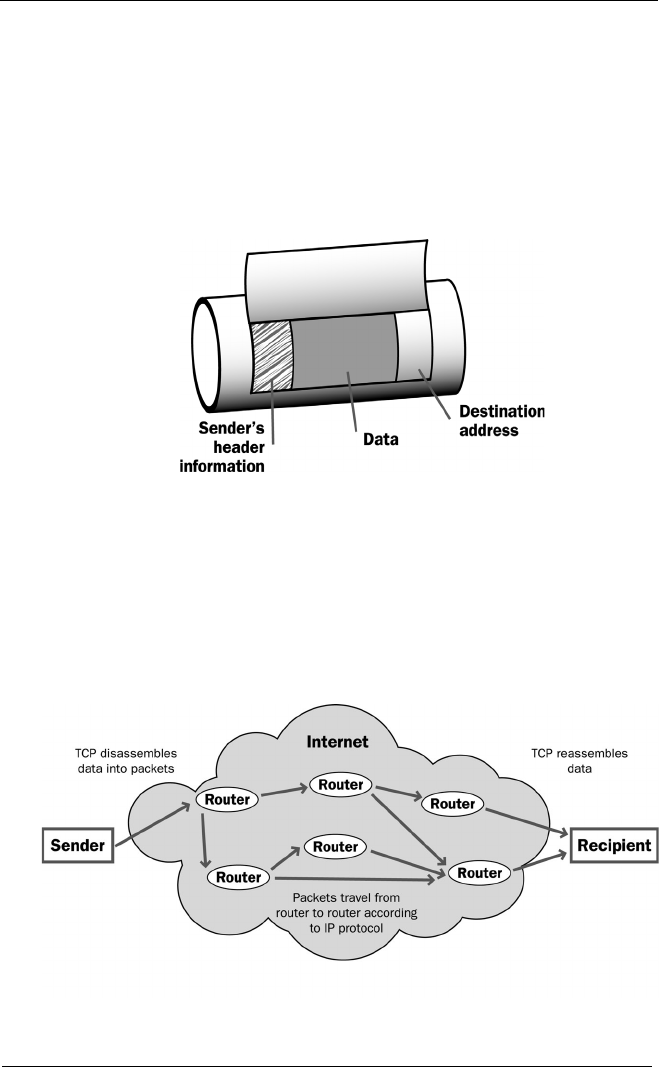
Introduction to Network Security
4 WatchGuard Firebox X Edge
Internet, the file is divided into chunks of data. Each chunk, or
packet, is separately numbered and includes the Internet address of
the destination. The individual packets for a given file may travel
different routes through the Internet. When they have all arrived,
they are reassembled into the original file. To make sure that the
packets are received at the destination, information is added to the
packets.
Data packet
The TCP and IP protocols are used for sending and receiving these
packets. TCP disassembles and reassembles the data; for example,
data that may consist of an e-mail message or a program file. IP
adds information to the packets that includes the destination and
the handling requirements.
Packets traveling on the Internet

IP Addresses
User Guide 5
IP Addresses
IP addresses are like street addresses—when you want to send some
information to someone, you must first know his or her address.
Similarly, when a computer connected to the Internet needs to send
data to another computer, it must first know its IP address.
Each computer on the Internet has its own unique IP address. An IP
address consists of four sets of numbers separated by decimal
points. Examples of IP addresses are:
• 192.168.0.11
• 10.1.20.18
• 208.15.15.15
A firewall device such as the Firebox® X Edge is also a computer and
therefore has its own IP address.
Network addressing
Your ISP assigns IP addresses, which are a requirement to connect to
the Internet. The assignment of IP addresses is
dynamic
or
static
.
Static IP addressing occurs when an ISP permanently assigns one or
more IP addresses for each user. These addresses do not change over
time. However, if a static address is assigned but not in use, it is
effectively wasted. Because ISPs have a limited number of addresses
allocated to them, they sometimes need to make more efficient use
of their addresses.
Dynamic IP addressing allows the ISP to use their address space
more efficiently. Using dynamic IP addressing, the IP addresses of
individual user computers may change over time. If a dynamic
address is not in use (the user is not connected to the network), it
can be automatically reassigned to another computer as needed.
Your ISP can tell you how their system assigns IP addresses.
About DHCP
Most ISPs make dynamic IP address assignments through (Dynamic
Host Configuration Protocol (DHCP). When a computer connects to
the network, a DHCP server at the ISP assigns that computer an IP
address. The manual assignment of IP addresses is not necessary
when using DHCP.

Introduction to Network Security
6 WatchGuard Firebox X Edge
About PPPoE
Some ISPs assign the IP addresses through Point-to-Point Protocol
over Ethernet (PPPoE). PPPoE emulates a standard dial-up connec-
tion to provide some of the features of Ethernet and PPP. This sys-
tem allows the ISP to use the billing, authentication, and security
systems designed for dial-up, DSL modem, and cable modem ser-
vice.
Domain Name Service (DNS)
If you don’t know a person’s street address, you can look it up in the
telephone directory. On the Internet, the equivalent to a telephone
directory is the Domain Name Service, or DNS. You probably use
DNS all the time without knowing it. Whenever you use a “.com”
address such as www.mysite.com (which is actually the site’s
domain
name
) to visit an Internet site, you are using DNS. When you type
the .com address into your Internet browser (such as Internet
Explorer or Netscape), your computer asks its DNS server for the
actual IP address of the site.
A URL (Uniform Resource Locator) identifies each IP address on the
Internet. An example of a URL is:
http://www.watchguard.com/
Services
As the name implies, a service provides some kind of useful function
for you on the computer, such as exchanging e-mail or transferring
files from one computer to another through the network. These ser-
vices are based on specific protocols. Commonly used Internet ser-
vices are:
• World Wide Web access uses Hypertext Transfer Protocol (HTTP)
• E-mail uses Simple Mail Transfer Protocol (SMTP)
• File transfer uses File Transfer Protocol (FTP)
• Resolving a domain name into an Internet address uses Domain
Name Service (DNS)
• Remote terminal access uses Telnet or Secure Shell

Ports
User Guide 7
Although some services are essential, they can also be a security risk.
To send and receive data, you must “open a door” in your computer,
which makes your network vulnerable. One of the most common
ways networks are broken into is by intruders exploiting services.
Ports
On computers and other telecommunication devices, a port is a spe-
cific place for physically connecting another device, usually with a
socket and plug. A computer usually has one or more serial ports
and one parallel port. The serial port supports sequential, one bit-
at-a-time transmission to devices such as scanners, and the parallel
port supports multiple-bit-at-a-time transmission to devices such as
printers.
Computers also have ports that are not physical locations. These
ports are “logical connection places” for programs or applications on
a computer in a network. Some applications, such as HTTP, have
ports with preassigned numbers. These are known as “well-known
ports.” Other application processes are assigned port numbers
dynamically for each connection. When a service is initially started,
it is said to “bind” to its designated port number.
Every Internet service using TCP is identified by a unique port num-
ber. When a client initiates a connection to a server, it chooses to
connect to, say, port 25 on the remote machine. Port 25 is assigned
to the SMTP protocol which is the service of delivering electronic
mail.
Most services are assigned a port number in the range from 0 to
1024, but the valid port numbers range from 0 to 65535.
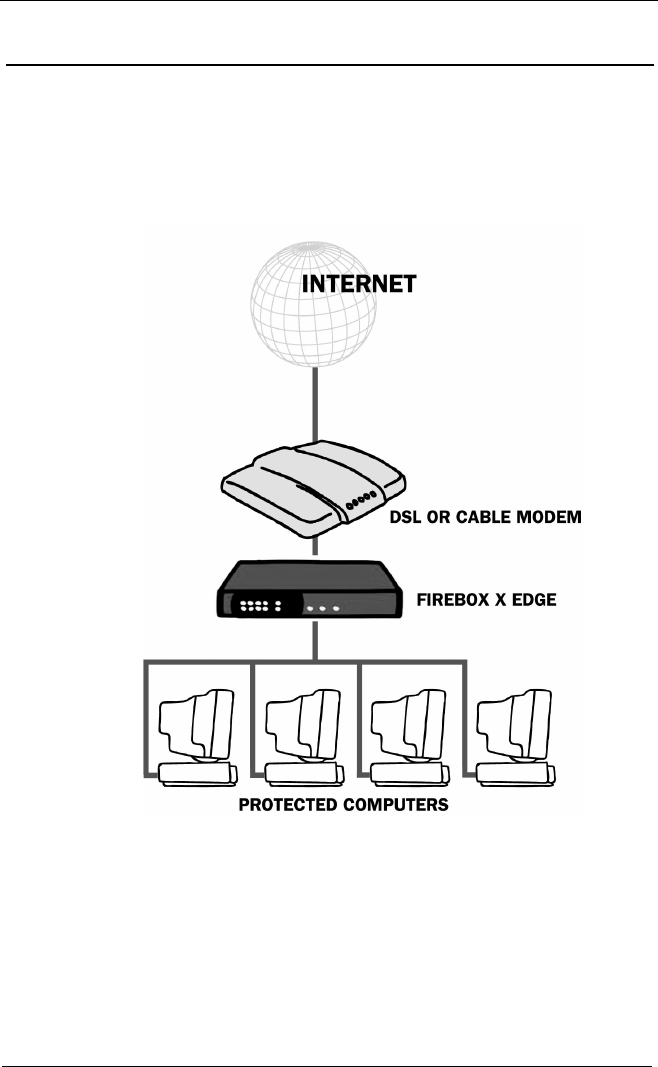
Introduction to Network Security
8 WatchGuard Firebox X Edge
Firewalls
A
firewall
divides your internal network from the Internet to reduce
this danger. The computers on the “trusted” (internal) side of a fire-
wall are protected. The illustration below shows how a firewall phys-
ically divides the trusted network (your computers) from the
Internet.
Firewalls allow the user to define access policies for the Internet
traffic going to the computers they are protecting. Many also pro-
vide the ability to control what services or ports the protected com-
puters are able to access on the Internet (outbound access). Most
firewalls intended for home use come with pre-configured security
policies from which the user chooses, and some—such as the Firebox
X Edge—allow the user to customize these policies for their specific
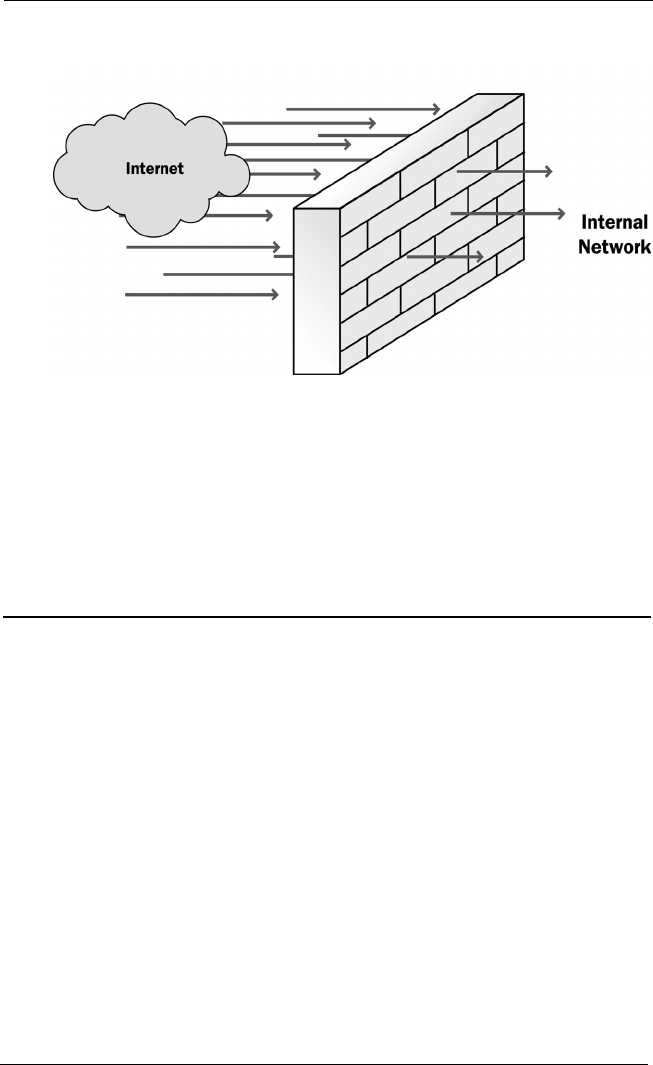
Firebox® X Edge and Your Network
User Guide 9
needs.
Firewalls are implemented in both hardware and software, or a com-
bination of both. Firewalls are frequently used to prevent unautho-
rized Internet users from accessing private networks connected to
the Internet. All messages entering or leaving the intranet pass
through the firewall, which examines each message and blocks those
that do not meet the specified security criteria.
Firebox
®
X Edge and Your Network
The Firebox® X Edge controls all traffic between the external net-
work (the Internet) and the trusted network. The Edge also supports
an optional network to extend the protection of the firewall to
include telecommuters on a separate network. All suspicious traffic
is stopped. The rules and policies that identify the suspicious traffic
are described in Chapter 5, “Configuring Firewall Settings.”
Designed for small and remote offices with modest in-house security
expertise, the Firebox X Edge is a high-performance security device
that simply plugs in between your cable, DSL, or ISDN router and
your network.
The Web-based user interface of the Firebox X Edge intuitive and
straight-forward. You don't need additional security expertise to
install and manage your firewall. Because you can manage your net-
work securely from anywhere, at any time, you have more time and
resources to focus on your business.

Introduction to Network Security
10 WatchGuard Firebox X Edge
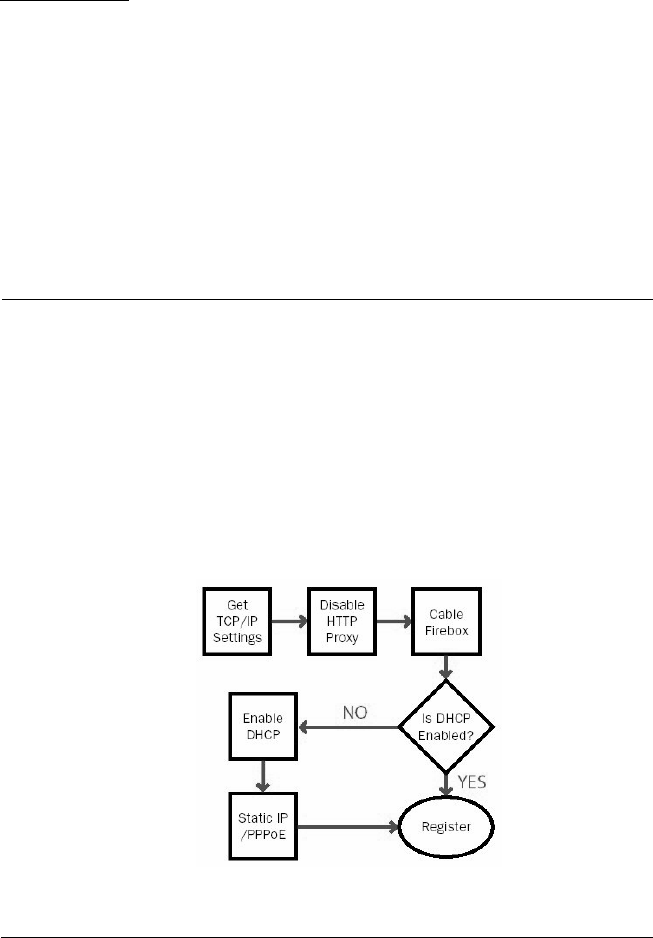
User Guide 11
CHAPTER 2 Installing the
Firebox® X Edge
To install the WatchGuard® Firebox® X Edge in your network, you must
complete these steps:
• Identify and record the TCP/IP properties for your Internet
connection.
• Disable the HTTP proxy properties of your Web browser.
• Connect the Firebox X Edge to your network.
• Enable your computer for DHCP.
• Activate the LiveSecurity® Service.
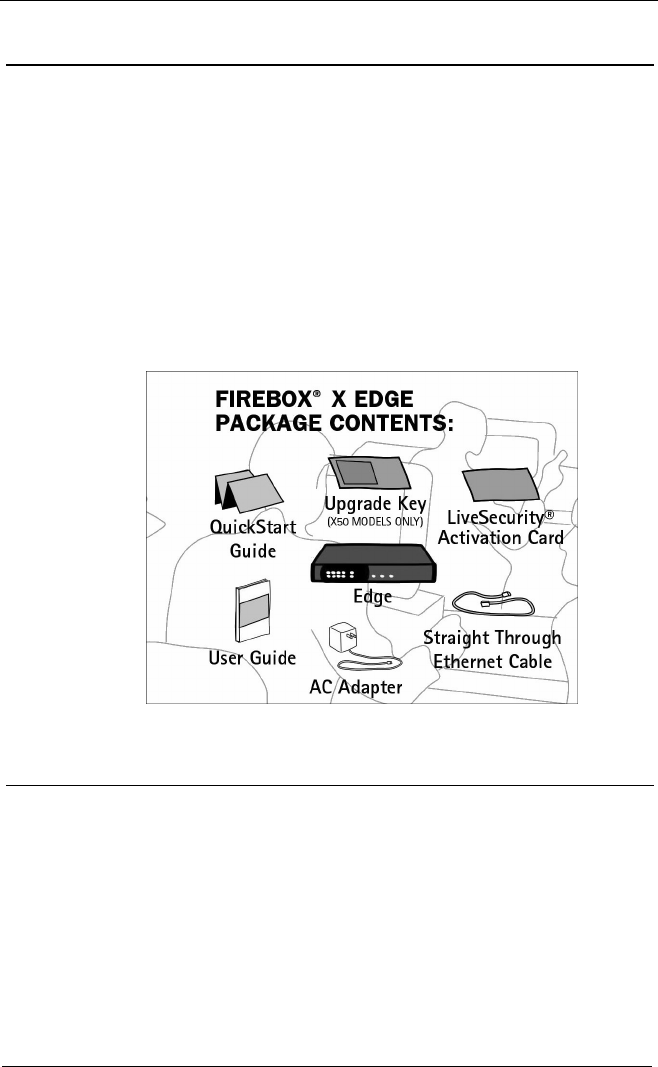
Installing the Firebox® X Edge
12 WatchGuard Firebox X Edge
Package Contents
Make sure that the package for your Firebox® X Edge includes this
User Guide and these items:
• The Firebox X Edge
QuickStart Guide
• A LiveSecurity® Service activation card
• A Hardware Warranty Card
• An AC adapter (12 V)
• Power cable clip, to attach to the cable and connect to the side
of the Edge. This releases tension on the power cable.
• One straight-through Ethernet cable
Installation Requirements
The other installation requirements are:
• A computer with a 10/100BaseT Ethernet I/O network interface
card.
• A Web browser. You must use Netscape 7.0 (or later), Internet
Explorer 6.0 (or later), or an equivalent browser.
• The serial number of the Firebox X Edge you see on the bottom
of the device.
You use the serial number to register the Edge.

Identifying Your Network Settings
User Guide 13
• An Internet connection that operates.
The external network connection can be a cable or DSL modem with a
10/100BaseT port, an ISDN router, or a direct LAN connection. If the
Internet connection does not operate, speak to your Internet Service
Provider (ISP).
Identifying Your Network Settings
You use an Internet Service Provider (ISP) to connect to the Internet.
These ISPs give all computers an Internet Protocol (IP) address. An
ISP can give you a static or dynamic IP address. A static address is an
address that stays the same. A dynamic address is an address that
can change each time you connect to the Internet. When you close a
dynamic Internet connection, the dynamic address goes to the list of
available addresses.
Your ISP gives you an IP address using one of these:
• Static: Web servers, FTP Web sites, and other Internet resources
that must have an address that cannot change get static a IP
addresses.
• DHCP: ISPs use the Dynamic Host Configuration Protocol
(DHCP) to give you a dynamic IP address. Each time you
connect to the ISP, a DHCP server can give you a different IP
address.
• PPPoE: ISPs use Point-to-Point Protocol over Ethernet (PPPoE)
to give you a dynamic IP address or a static IP address. A user
name and passphrase are necessary for PPPoE.
An ISP can also give a network mask (netmask) to a computer. A
netmask is a string of bits that "mask" one part of an IP address.
You use a netmask to divide your network into smaller units, and
creating added destinations to which you can send routed traffic.
Read your DSL or cable modem instructions or speak to your ISP to
learn if you have a dynamic IP address or a static IP address.
Finding your TCP/IP properties
Transmission Control Protocol/Internet Protocol (TCP/IP) is the pri-
mary protocol computers use to connect to the Internet. To use
TCP/IP, your computer must have an IP address and information
about the computer network of your ISP. You must have this infor-
mation to install your Firebox X Edge.

Installing the Firebox® X Edge
14 WatchGuard Firebox X Edge
N
OTE
N
OTE
If your ISP gives your computer an IP address of 10.0.0.0/8 or one
that starts with 192.168 or 172.16 to 172.31, then your ISP uses
network address translation (NAT). You must get a public IP
address and disable NAT on your intranet router for full
functionality. Get instructions from your ISP.
Your TCP/IP Properties Table
To find your TCP/IP properties, use the instructions for your com-
puter operating system.
Microsoft Windows 2000 and Windows XP
1Click Start > Programs > Accessories > Command Prompt.
2At the MS-DOS prompt, type ipconfig /all and then press
Enter.
3Record the values in the Your TCP/IP Properties Table on
page 14.
4Close the window.
Microsoft Windows NT
1Click Start > Programs > Command Prompt.
2At the MS-DOS prompt, type ipconfig /all and then press
Enter.
TCP/IP Property Value
IP Address
. . .
Subnet Mask
. . .
Default Gateway
. . .
DHCP Enabled Yes No
DNS Server(s) Primary
. . .
Secondary
. . .

Disabling the HTTP Proxy Setting
User Guide 15
3Record the values in the Your TCP/IP Properties Table on
page 14.
4Close the window.
Microsoft Windows 98 or ME
1Click Start > Run.
2At the MS-DOS prompt, type winipcfg and then press Enter.
3Click OK.
4Select the Ethernet Adapter.
5Record the values in the Your TCP/IP Properties Table on
page 14.
6Click Cancel.
Macintosh
1Click the Apple menu > Control Panels > TCP/IP.
2Record the values in the Your TCP/IP Properties Table on
page 14.
3Close the window.
Other operating systems (Unix, Linux)
1Read your operating system guide to locate the TCP/IP settings.
2Record the values in the Your TCP/IP Properties Table on
page 14.
3Exit the TCP/IP configuration screen.
Disabling the HTTP Proxy Setting
A proxy is a computer procedure that receives and examines packet
headers and packet content. If the proxy finds packet headers or
packet contents that do not obey the proxy rules, those packets are
denied, blocked, or stripped. The proxy policy monitors and controls
traffic to protect your network from the Internet.
Many Web browsers use the HTTP proxy to monitor incoming Inter-
net traffic. When this proxy is enabled, you can see Web pages on
the Internet, but you cannot see Web pages in other locations.
Because you must see pages that are stored or saved on the Firebox
X Edge to complete the installation procedure, you must disable this
proxy temporarily.

Installing the Firebox® X Edge
16 WatchGuard Firebox X Edge
You can use the instructions below to disable the HTTP proxy in
Netscape or Internet Explorer. If you are using a different browser,
try using the browser Help system to find the necessary information.
Many opensource browsers automatically disable the HTTP proxy
feature.
Netscape
1Open Netscape.
2Click Edit > Preferences.
The Preferences window appears.
3A list of options appears at the left side of the window. Click the
arrow symbol to the left of the Advanced heading to expand
the list.
4Click Proxies.
5Make sure the Direct Connection to the Internet option is
selected.
6Click OK.
Internet Explorer
1Open Internet Explorer.
2Click Tools > Internet Options.
The Internet Options window appears.
3Click the Advanced tab.
4Scroll down the page to HTTP 1.1 Settings.
5Clear all of the checkboxes.
6Click OK.
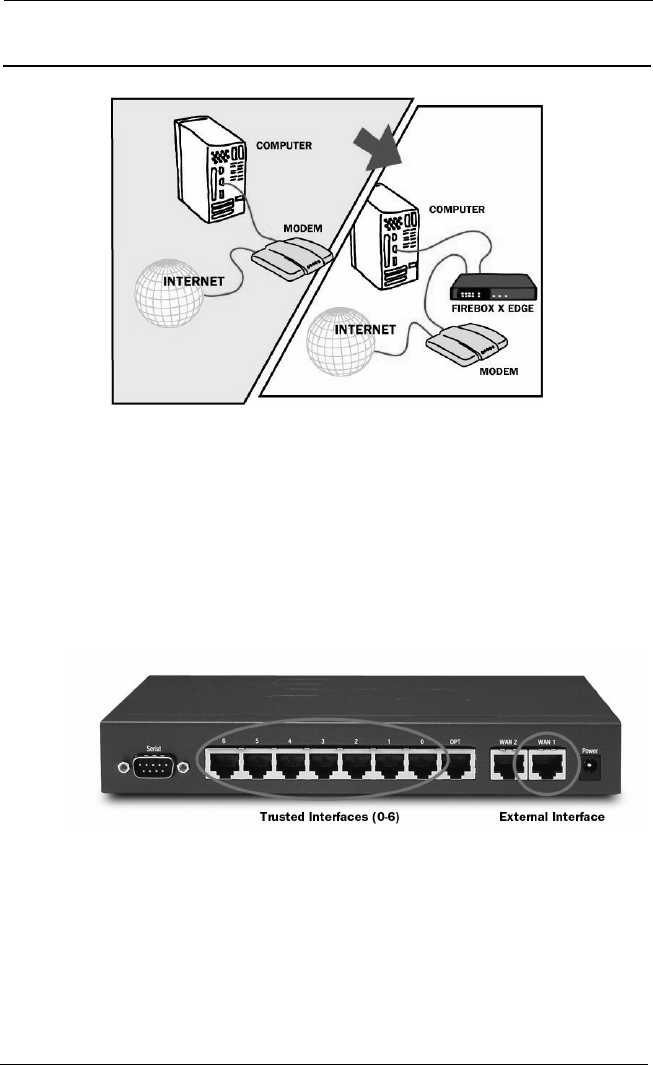
Connecting the Firebox X Edge
User Guide 17
Connecting the Firebox X Edge
Use this procedure to connect your Firebox® X Edge Ethernet and
power cables:
1Shut down your computer.
2If you use a DSL or cable modem to connect to the Internet,
disconnect its power supply.
3Find the Ethernet cable between the modem and your
computer. Disconnect this cable from your computer and
connect it to the Edge external interface (WAN 1).
4Find the Ethernet cable supplied with your Edge. Connect this
cable to a trusted interface (0-6) on the Edge. Connect the
other end of this cable to the Ethernet interface of your
computer.
5If you use a DSL or cable modem, connect its power supply.

Installing the Firebox® X Edge
18 WatchGuard Firebox X Edge
6Find the AC adapter supplied with your Edge. Connect the AC
adapter to the Edge and to a power source.
The Edge power indicator light comes on and the external interface
indicator lights flash and then come on. The Edge is ready.
N
OTE
N
OTE
Use only the Firebox X Edge AC adapter.
7When the Edge is ready, start your computer.
Cabling the Firebox X Edge for more than seven devices
Although the Firebox X Edge has only seven numbered Ethernet
ports (labeled 0-6), you can connect more than seven devices. Use
one or more network hubs to make more connections.
The maximum number of devices that can connect to the Internet
at the same time is set by model. For example, the Firebox X5 has a
five-session license. There can be more than five devices on the
trusted network, but the Edge allows only five Internet connections
at the same time.
The Edge uses a session when it makes a connection between a
computer on the trusted interface and a computer on the external
interface. The Edge releases the session when:
• The session reaches the idle timeout limit
• The session reaches the maximum time limit
• The Edge administrator uses the Firebox Users page to end the
session
• The user ends the session by closing all browser windows
• The Edge restarts.
For more information, see the FAQ:
https://www.watchguard.com/support/AdvancedFaqs/
sogen_seatlimit.asp
License upgrades are available from your reseller or from the Watch-
Guard Web site:
http://www.watchguard.com/sales/buyonline.asp
To connect more than seven devices to the Edge, you need:
• An Ethernet 10/100Base TX hub or switch
• A straight-through Ethernet cable, with RJ-45 connectors, for
each computer

Connecting the Firebox X Edge
User Guide 19
• A straight-through Ethernet cable to connect each hub to the
Firebox X Edge.
To connect more than seven devices to the Firebox X Edge:
1Shut down your computer. If you connect to the Internet
through a DSL modem or cable modem, disconnect the power
supply from this device.
2Disconnect the Ethernet cable that runs from your DSL modem,
cable modem, or other Internet connection to your computer.
Connect the Ethernet cable to the WAN port on the Firebox X
Edge.
The Firebox X Edge is connected directly to the modem or other Internet
connection.
3Connect one end of the straight-through Ethernet cable
supplied with your Firebox X Edge to one of the seven
numbered Ethernet ports (labeled 0-6) on the Edge. Connect
the other end to the uplink port of the Ethernet hub or switch.
The Firebox X Edge is connected to the Internet and your Ethernet hub
or switch.
4Connect an Ethernet cable between each of the computers and
an uplink port on the Ethernet hub, and make sure the link
lights are lit on both devices when powered back on.
5If you connect to the Internet through a DSL modem or cable
modem, reconnect the power supply to this device. The
indicator lights flash and then stop. The modem is ready for use.
6Attach the AC adapter to the Firebox X Edge. Connect the AC
adapter to a power supply.
7Restart your computer.
If you get a message that says your operating system has no network
connection, shut down all equipment and make sure all devices are
connected properly.
8Start your Internet browser.
9Type https://192.168.111.1/ into the URL entry field of your
browser and press Enter.
10 Follow the steps in the QuickSetup Wizard to configure your
Firebox X Edge.

Installing the Firebox® X Edge
20 WatchGuard Firebox X Edge
If your ISP uses static IP addressing, or uses PPPoE, then do the fol-
lowing additional steps:
1From your Web browser, select File > Open Location, type
https://192.168.111.1/ into the URL entry field of your browser,
and press Enter. Log on using the default user name (admin)
and password (admin).
2From the navigation bar, expand Network (click the plus sign)
and select External.
3From the Configuration Mode drop-down list, select either
Manual Configuration (for static IP addressing) or PPPoE
Client.
Connecting to the System Configuration Pages
Use a Web browser to connect to the Firebox® X Edge system con-
figuration pages. The first time you connect to the Edge configura-
tion pages, the End User License Agreement (EULA) appears. To
continue, you must accept the agreement. You must also set the
administrator password.
A factory default Edge allows HTTP traffic on port 80. After you set
the administrator password, the Edge uses only secure HTTP
(HTTPS) on port 443 for system configuration.
For your computer to connect to the Edge, you must choose one of
these options:
• Get a dynamic IP address from the Edge using DCHP
• Set a static IP address within the default trusted interface
address range
The default trusted interface IP address is 192.168.111.1/24.
For more information on network addressing, see “IP Addresses” on
page 5.
Setting your computer to use DHCP
This procedure sets a computer with the Windows XP operating sys-
tem to use DHCP. If your computer does not use Windows XP, read

Connecting to the System Configuration Pages
User Guide 21
the documentation for instructions to set your computer to use
DHCP.
1Click Start > Control Panel.
The Control Panel window appears.
2Double-click the Network Connections icon.
3Double-click the Local Area Connection icon.
4Double-click the Internet Protocol (TCP/IP) item.
The Internet Protocol (TCP/IP) Properties dialog box appears.
5Select the Obtain an IP address automatically and the Obtain
DNS server address automatically options.
6Click OK to close the Internet Protocol (TCP/IP) Properties
dialog box.
7Click OK to close the Local Area Network Connection
Properties dialog box. Close the Network Connections and
Control Panel windows.
Your computer is now connected to the Firebox X Edge.
Setting your computer with a static IP address
This procedure sets a computer with the Windows XP operating sys-
tem to a static IP address. If your computer does not use Windows
XP, read the documentation for instructions to set your computer to
use DHCP. You must use an IP address on the same network as the
Firebox X Edge trusted interface.
1Click Start > Control Panel.
The Control Panel window appears.
2Double-click the Network Connections icon.
3Double-click the Local Area Connection icon.
4Double-click the Internet Protocol (TCP/IP) item.
The Internet Protocol (TCP/IP) Properties dialog box appears.
5Select the Use the following IP address option.
6In the IP address field, type an IP address on the same network
as the Edge trusted interface. We recommend 192.168.111.2.
The default trusted interface network is 192.168.111.0/24. The last
number can be between 2 and 254.
7In the Subnet Mask field, type 255.255.255.0.
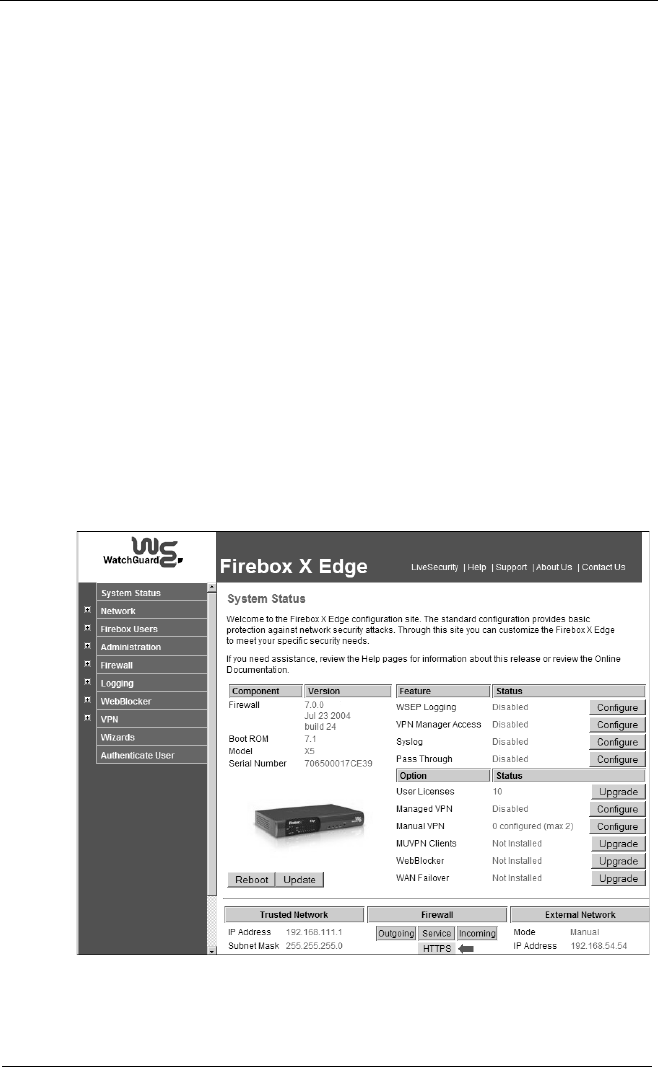
Installing the Firebox® X Edge
22 WatchGuard Firebox X Edge
8In the Default Gateway field, type the IP address of the Edge
trusted interface.
The default Edge trusted interface address is 192.168.111.1.
9Click OK to close the Internet Protocol (TCP/IP) Properties
dialog box.
10 Click OK to close the Local Area Network Connection
Properties dialog box. Close the Network Connections and
Control Panel windows.
Your computer is now connected to the Firebox X Edge.
Browsing to the System Status page
Use a Web browser to connect to the Edge and then change the
network settings.
1Open your Web browser.
If this is the first connection to the Edge, the End User License
Agreements appears. You must accept the agreement and set your
administrator password to continue.
2In the Address bar, type the Edge trusted interface IP address
which is https://192.168.111.1 for a new Edge. Press the Enter
key.
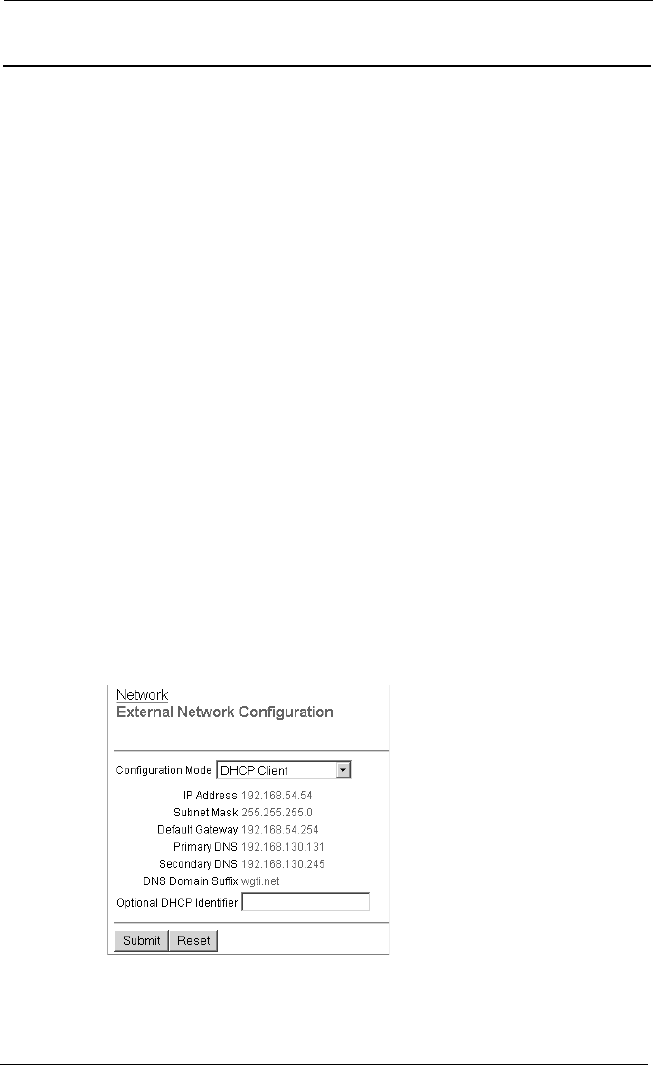
Configuring the External Interface
User Guide 23
Configuring the External Interface
Your Internet Service Provider (ISP) uses DHCP, PPPoE, or static IP
addressing to identify your computer on their network. After you
connect the Edge, you must configure the external interface with
the information from your ISP.
Setting the Edge to use DHCP
A new Edge uses DHCP to get an IP address for the external inter-
face. If your ISP uses DHCP addressing to identify your computer on
their network, it is not necessary to make a configuration change
unless the ISP gives you a DHCP ID or name. If necessary, use this
procedure to set the DHCP ID or name:
1Open your Web browser. Browse to the System Status page at
https://192.168.111.1.
Type the URL in the Address bar of your browser and press the [Enter]
key.
2From the navigation bar on the left side, click the + symbol to
the left of Network. Click External.
3Use the Configuration mode drop-down list to select DHCP
Client.
4In the Optional DHCP Identifier field, type the DHCP name or
ID you got from your ISP.
5Click Submit.
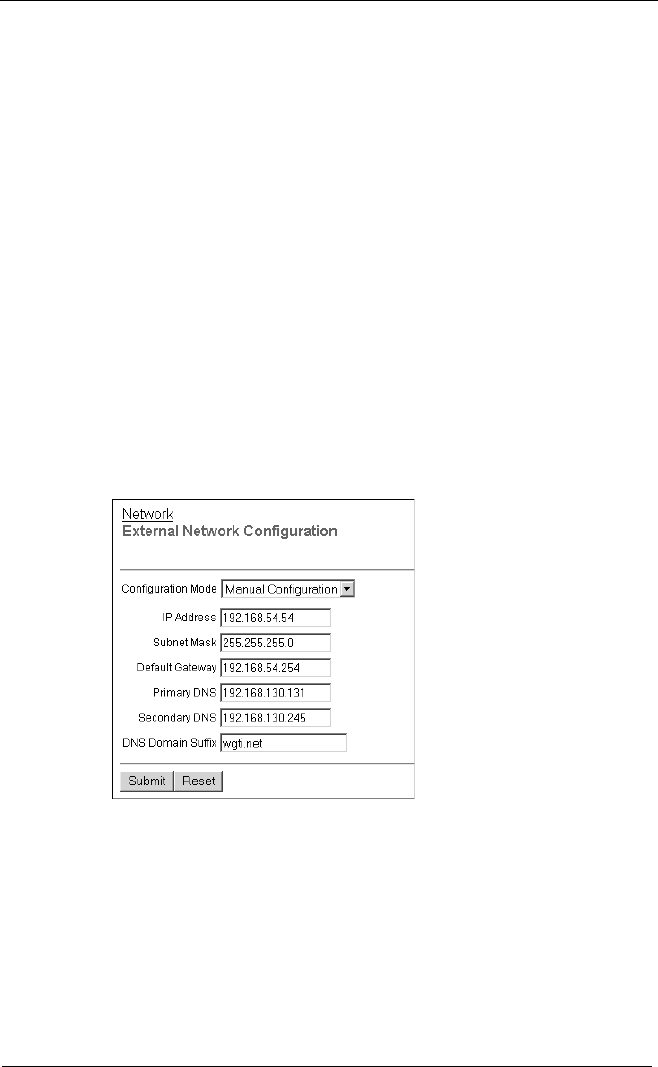
Installing the Firebox® X Edge
24 WatchGuard Firebox X Edge
Setting a Static IP Address
If your ISP uses static IP addressing, you must set the Edge external
interface address. Use the information in the Your TCP/IP Properties
Table on page 14 to do this procedure.
1Open your Web browser. Browse to the System Status page at
https://192.168.111.1.
Type the URL in the Address bar of your browser and press the [Enter]
key.
2From the navigation bar on the left side, click the plus sign (+)
to the left of Network. Click External.
3Use the Configuration mode drop-down list to select Manual
Configuration.
4Type the IP address, subnet mask, and default gateway.
5Type the IP addresses of the primary and secondary DNS servers.
6Type the DNS domain suffix.
7Click Submit.
Entering PPPoE settings
Many ISPs use Point to Point Protocol over Ethernet (PPPoE)
because it is easy to merge with dial-up infrastructure. If your ISP
uses PPPoE to give IP addresses, you must get more setup informa-
tion.
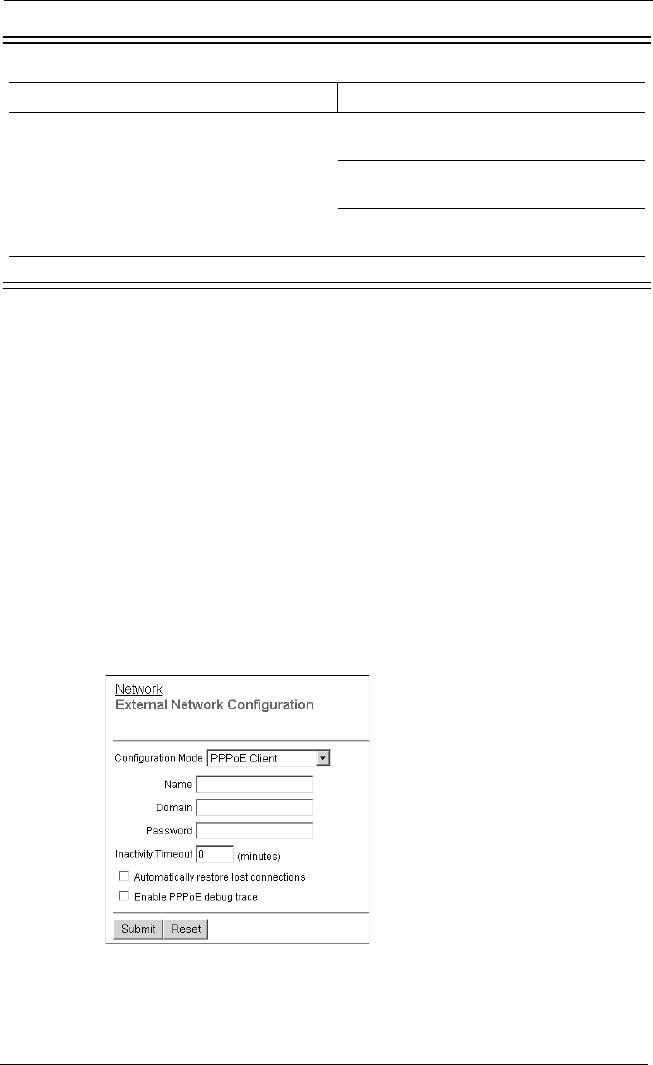
Configuring the External Interface
User Guide 25
PPPoE Address Settings
For more information in PPPoE, see “About PPPoE” on page 6. To
configure the Edge for PPPoE:
1Open your Web browser and click Stop.
Because the Internet connection is not configured, the browser cannot
show your home page from the Internet. The browser can only open the
configuration pages saved on the Edge.
2Type the IP address of the trusted network in your browser
window to connect to the System Status page of the Firebox X
Edge.
The default IP address is: https://192.168.111.1
3From the navigation bar at left, select Network > External.
The External Network Configuration page opens.
4From the Configuration Mode drop-down list, select PPPoE
Client.
PPPoE Setting Value
Login Name
Domain
Password

Installing the Firebox® X Edge
26 WatchGuard Firebox X Edge
5Type the PPPoE login name and domain as well as the PPPoE
password supplied by your service provide in the applicable
fields.
6Type the time delay before inactive TCP connections are
disconnected.
7If appropriate, select the Automatically restore lost
connections checkbox.
This option keeps a constant traffic flow between the Edge and the
PPPoE server. Thus the Edge keeps the PPPoE connection open during a
period of frequent packet loss. If the traffic flow stops, the Edge reboots,
which frequently activates the connection. The ISP sees this constant
traffic flow as a continuous connection. The ISP rules and billing policy
control if you can use this option.
8Select the Enable PPPoE debug trace checkbox to activate
PPPoE debug trace.
This can assist WatchGuard Technical Support in troubleshooting PPPoE
problems.
9Click Submit.
Registering Your Edge and Activating
LiveSecurity Service
After you install the Firebox® X Edge, you can register the Edge and
activate your LiveSecurity® Service subscription. The LiveSecurity
Service gives you threat alert notifications, security advice, free virus
protection, software updates, technical support by Web or tele-
phone, and access to online help resources and the WatchGuard user
forum.
You must have a subscription to the LiveSecurity Service before you
can get license keys for the upgrades that you purchase. To apply
upgrades, you must log into LiveSecurity Service and enter your
upgrade key. You get a
feature key
to activate the features on your
Firebox X Edge.
You must have the serial number of your Firebox X Edge to register.
The Edge serial number is on the bottom of the device. Record the
serial number in the table below:
1Register your Firebox X Edge with the LiveSecurity Service at the
WatchGuard Web site:
http://www.watchguard.com/activate

Registering Your Edge and Activating LiveSecurity Service
User Guide 27
N
OTE
N
OTE
To activate the LiveSecurity Service, your browser must have
JavaScript enabled.
2If you have a user profile on the WatchGuard Web site, enter
your user name and password. If you have not registered before,
you must create a user profile. To do this, follow the
instructions on the Web site.
3Record your LiveSecurity Service user profile information in the
table below. Keep this information confidential.
WatchGuard User Profile
4If a model upgrade key is included with your model, activate it
by going to:
http://www.watchguard.com/upgrade
5Select your product and follow the instructions for product
activation.
User name:
Password:
Serial Number:

Installing the Firebox® X Edge
28 WatchGuard Firebox X Edge

User Guide 29
CHAPTER 3 Configuration and
Management Basics
When you
configure
a Firebox, you make the WatchGuard® Firebox® X
Edge appropriate for the specific security needs of your organization.
This is your main task after you install your Firebox. You use Web
pages inthe Firebox to create the configuration of the Firebox X Edge.
You connect to these configuration pages with your Web browser.
You can also use the Firebox Web pages to create accounts, look at
network statistics, and see the current configuration of the Firebox.
Read this chapter to learn basic information about the Firebox X Edge
Web pages. Sections in later chapters have more detailed intructions.
This chapter contains cross-references to those later sections.
Navigating the Configuration Pages
To configure your Firebox® X Edge, you use a Web browser such as
Internet Explorer, Mozilla Firefox, or NetScape Navigator. You must
first disable the HTTP Proxy feature. For more information, see “Dis-
abling the HTTP Proxy Setting” on page 15.
In this User Guide, every procedure starts with a step to:
“Type the IP address of the trusted network in your browser window to
connect to the System Status page of the Firebox X Edge. The default
IP address is https://192.168.111.1.”
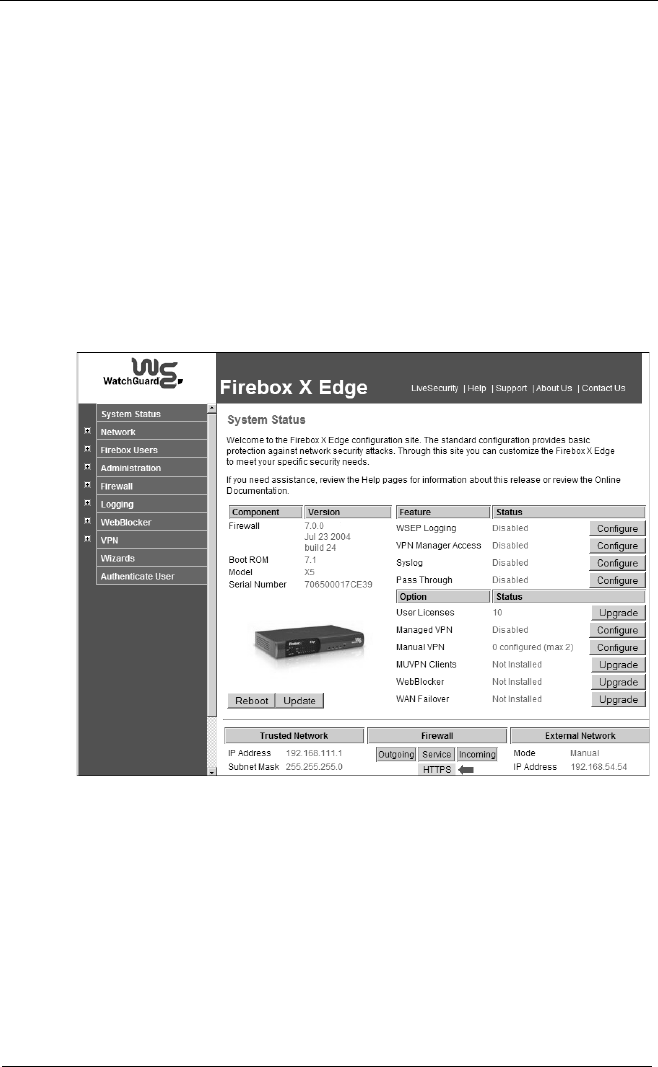
Configuration and Management Basics
30 WatchGuard Firebox X Edge
The purpose of the step is to open your Firebox system configura-
tion pages. Your computer must be connected to the Firebox with
an Ethernet cable. You can change the IP address of the trusted net-
work from https://192.168.111.1 to an IP address of your choice. For
more information, see “Configuring the Trusted Network” on
page 50.
For example, if you use Internet Explorer to configure your Firebox:
1Start Internet Explorer.
2Click File > Open, type https://192.168.111.1 in the text box
next to the word Open, and then click OK.
You can also type the URL directly into the Address bar and press the
Enter key.
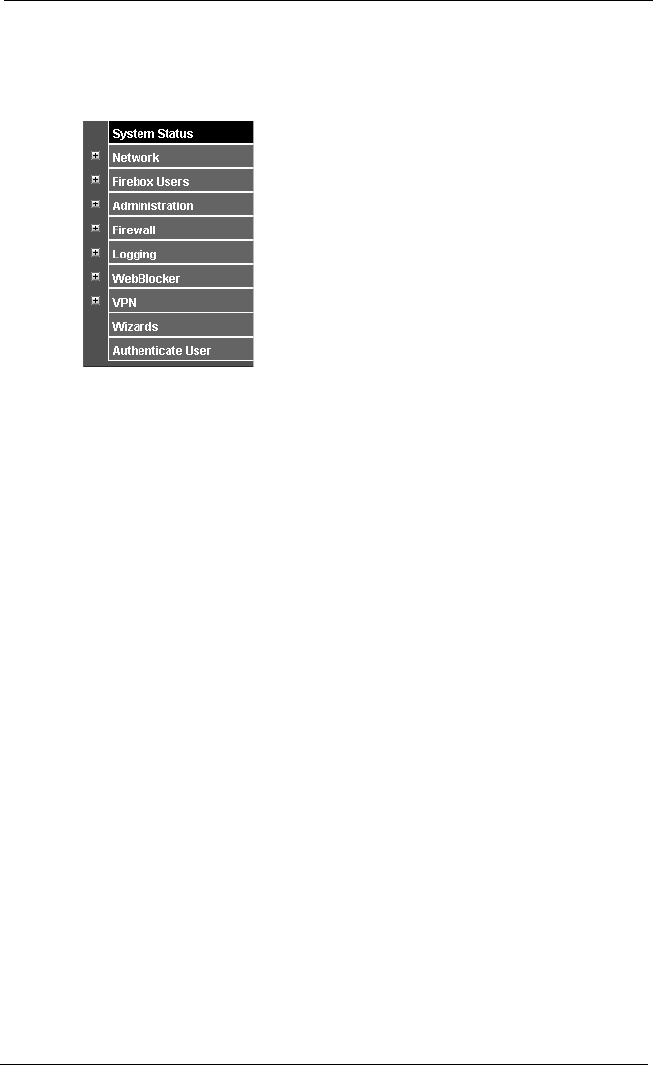
Navigating the Configuration Pages
User Guide 31
Using the navigation bar
On the left side of the System Status page is a navigation bar that
you use to see other Firebox X Edge configuration and status pages.
To see the main page for each area, click the appropriate menu item
on the navigation bar. For example, to see how logging is currently
configured for your Firebox and to see the current event log, click
Logging.
Each area contains submenus that you use to configure various set-
tings within that area. To see these submenus, click the plus sign (+)
to the left of the area. For example, if you click the plus sign next to
WebBlocker, the following submenu items appear: Settings, Profiles,
Allowed Sites, Denied Sites, and Trusted Hosts.
This guide uses a series of arrow (>) symbols to show menu items
that you expand or click. The menu names are in bold. For example,
the command to open the Denied Sites page appears in the text as
WebBlocker > Denied Sites.
Logging in and setting a password
The Firebox X Edge has no administrative password until you set
one. To connect to the Firebox before it has a password:
1Start your Internet browser.
2Click File > Open, type https://192.168.111.1 in the text box
next to the word Open, and then click OK.
3The End User License Agreement (EULA) appears. Read through
it, and if you agree, accept the EULA.
4Type your administrative password on the screen that appears.
Type it again to confirm.

Configuration and Management Basics
32 WatchGuard Firebox X Edge
Configuration Overview
You use the Firebox X Edge system configuration pages to set up
your Edge and make it work for your network and security require-
ments. This section gives a brief introduction to each category of
pages and tells you which chapters in this
User Guide
contain
detailed information about each feature.
Firebox System Status Page
The System Status page is the main configuration page of the Fire-
box X Edge. The center panel of the page shows information about
the current settings. It also contains buttons so you can change
these settings. This guide gives more detail on each setting in kater
chapters.
Basic information on this page includes the following:
• Firebox components and their current versions
• The serial number of the device
• The status of key Firebox X Edge features
• The status of upgrade options
• Network configuration information
• Which external network (external or failover) is currently active.
A green triangle appears next to the active network.
• Firewall configuration information
• A button to reboot the Firebox
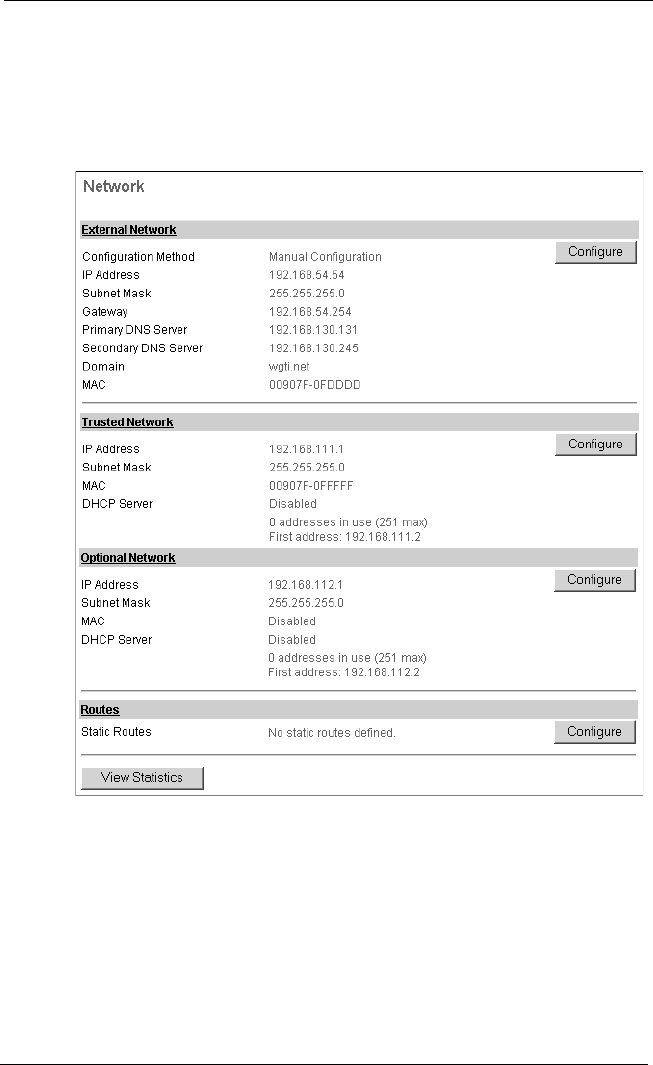
Configuration Overview
User Guide 33
Network Page
The Network page shows the configuration of each network inter-
face. It also shows any configured routes and has buttons you can
to change configurations and to see network statistics. For more
information, see Chapter 4, “Changing Your Network Settings.”
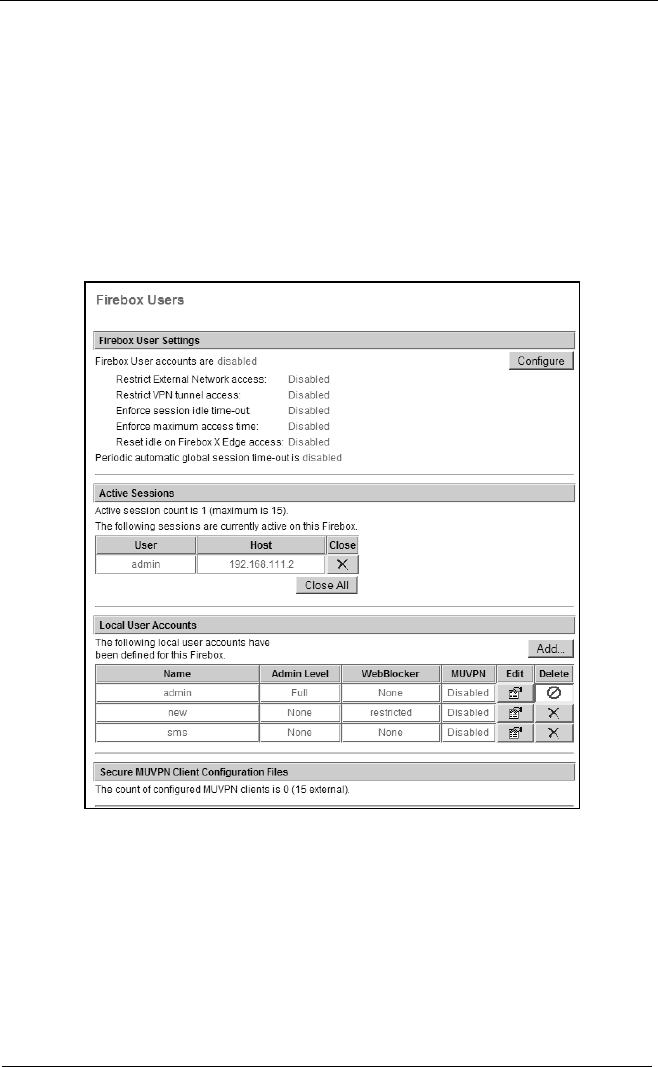
Configuration and Management Basics
34 WatchGuard Firebox X Edge
Firebox Users Page
The Firebox Users page shows statistics on the active sessions and
local user accounts. It also has buttons to close current sessions and
to add, edit, and delete user accounts.
This page also shows the MUVPN client configuration files that are
available for download. If you cannot yet use your Firebox for
MUVPN clients, the page has a button for you to make your Firebox
have MUVPN client support. For more information, see Chapter 11,
“Managing the Firebox X Edge.”
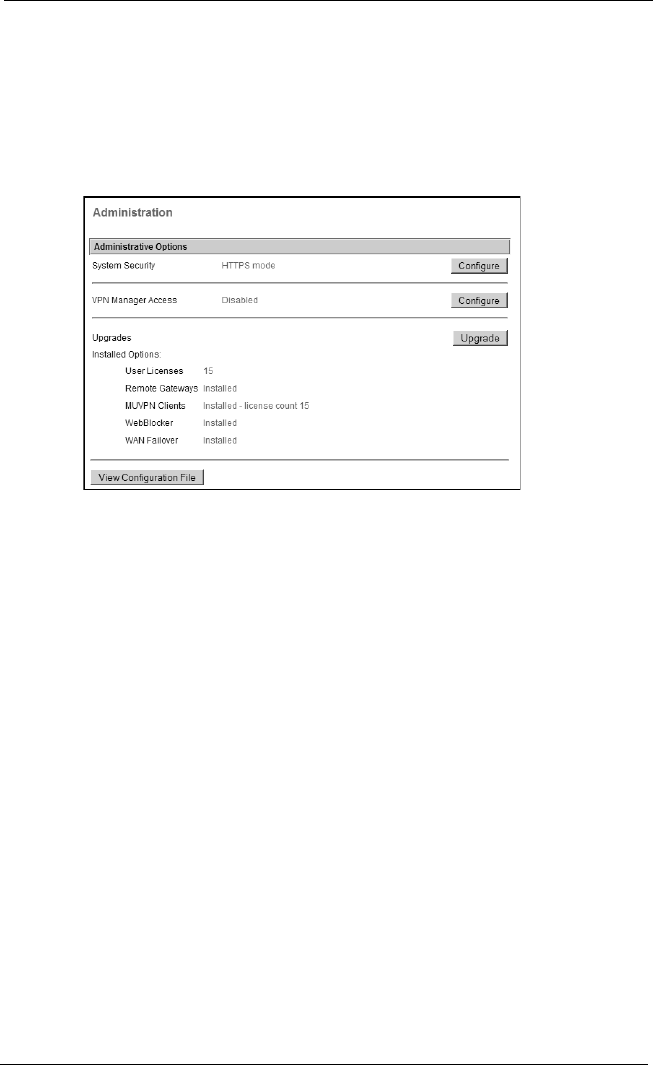
Configuration Overview
User Guide 35
Administration Page
The Administration page shows whether the Firebox uses HTTP or
HTTPS for its configuration pages, whether VPN Manager access is
enabled, and which upgrades are enabled. It has buttons to change
configurations, add upgrades, and view the configuration file. For
more information, see Chapter 11, “Managing the Firebox X Edge.”
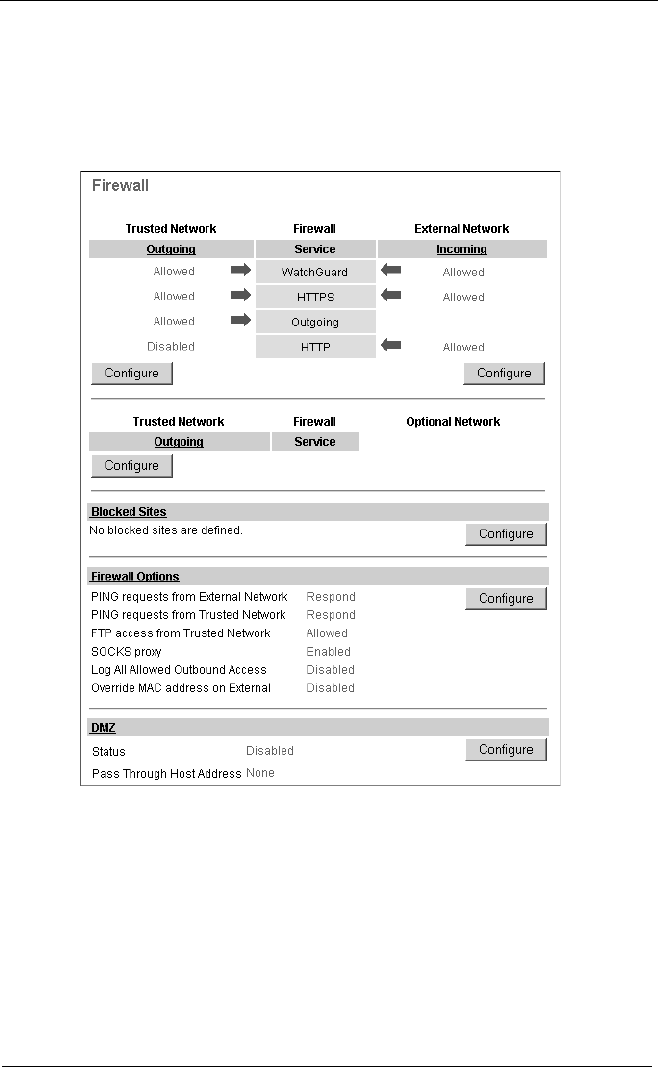
Configuration and Management Basics
36 WatchGuard Firebox X Edge
Firewall Page
The Firewall page shows the incoming and outgoing services,
blocked sites, as well as other firewell settings. This page also has
buttons to change these settings. For more information, see Chapter
6, “Configuring Firewall Settings.”
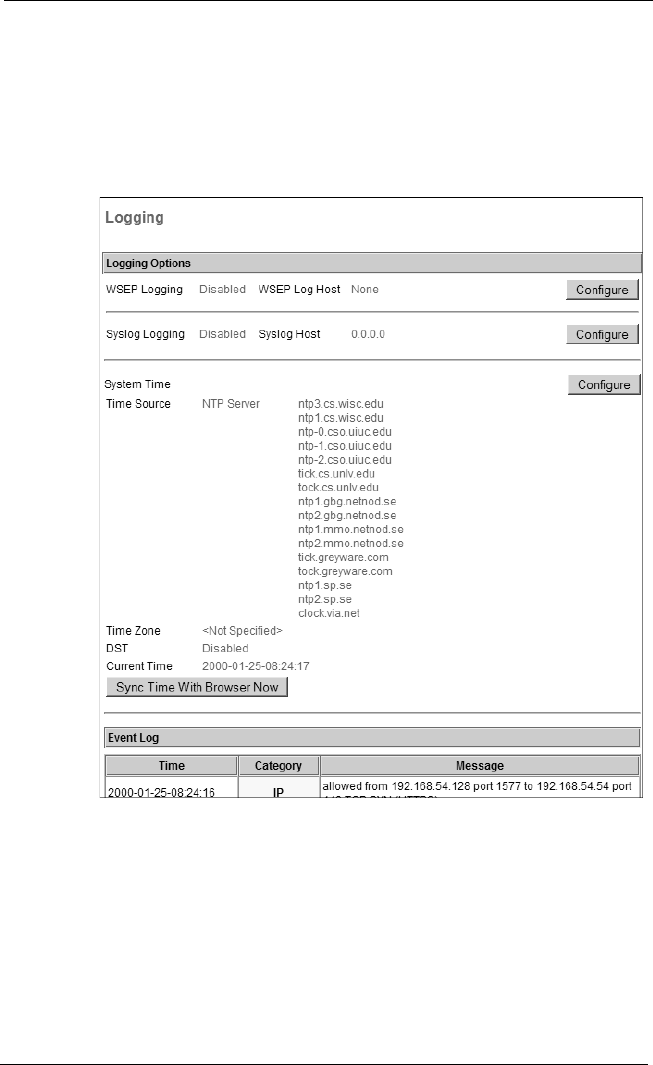
Configuration Overview
User Guide 37
Logging Page
The Logging page shows the current event log, status of WSEP and
Syslog logging, and the system time. It also has buttons to change
these settings and to set your system time so that it is the same as
your local computer. For more information, see Chapter 7, “Config-
uring Logging.”
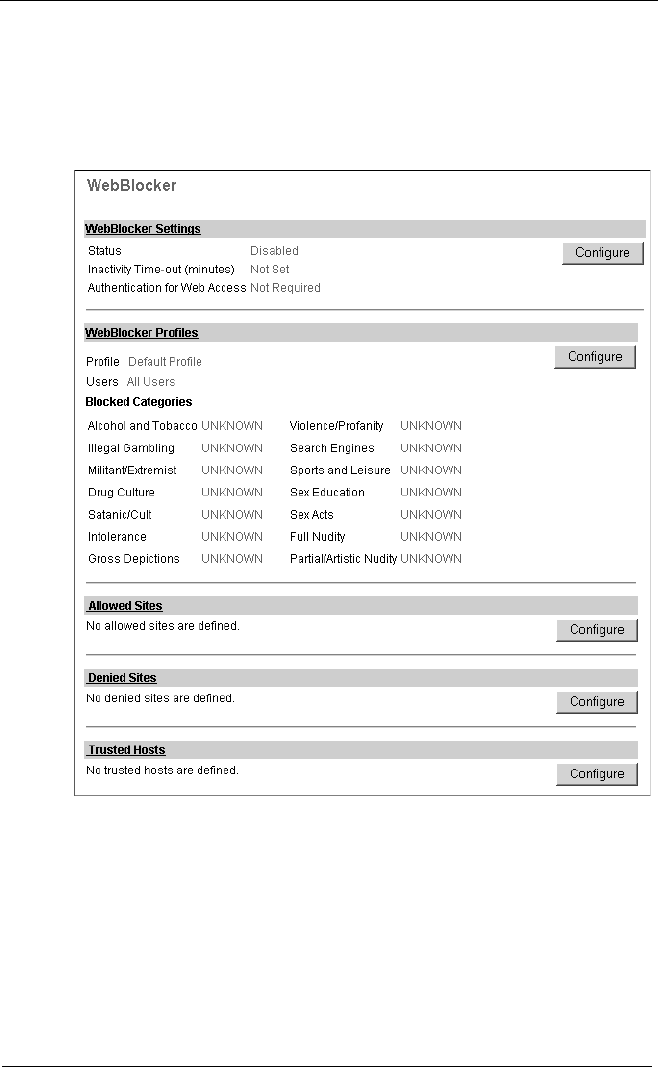
Configuration and Management Basics
38 WatchGuard Firebox X Edge
WebBlocker Page
The WebBlocker page shows the WebBlocker settings, profiles,
allowed sites, and denied sites. It also has buttons to change the
current settings. For more information, see Chapter 8, “Configuring
WebBlocker.”
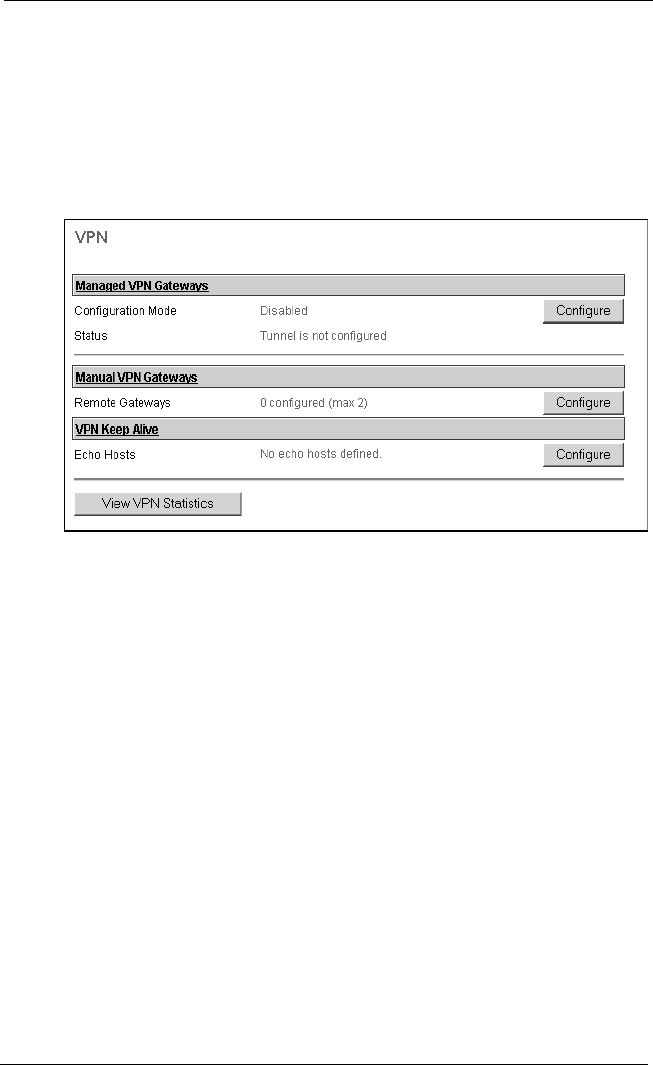
Configuration Overview
User Guide 39
VPN Page
The VPN page shows information on managed VPNs, manual VPN
gateways, and echo hosts along with buttons to change the config-
uration of VPN tunnels. It also has a button for you to see statistics
on active tunnels. For more information, see Chapter 9, “Configur-
ing VPNs.
Wizards Page
The Wizards page shows the wizards available to help you quickly
and easily set up key Firebox X Edge features:
• Network Interface Wizard
Configure all interfaces, including WAN failover. For more information,
see “Using the Network Setup Wizard” on page 45.
• Service Configuration Wizard
Create a rule to filter network traffic between interfaces. For more
information, see “Adding a custom policy using the wizard” on page 81.
•QuickSetup Wizard
Set up your Firebox X Edge.
•Failover Setup Wizard
Set up the failover network.
• Wireless Setup Wizard
Set up the wireless interface.
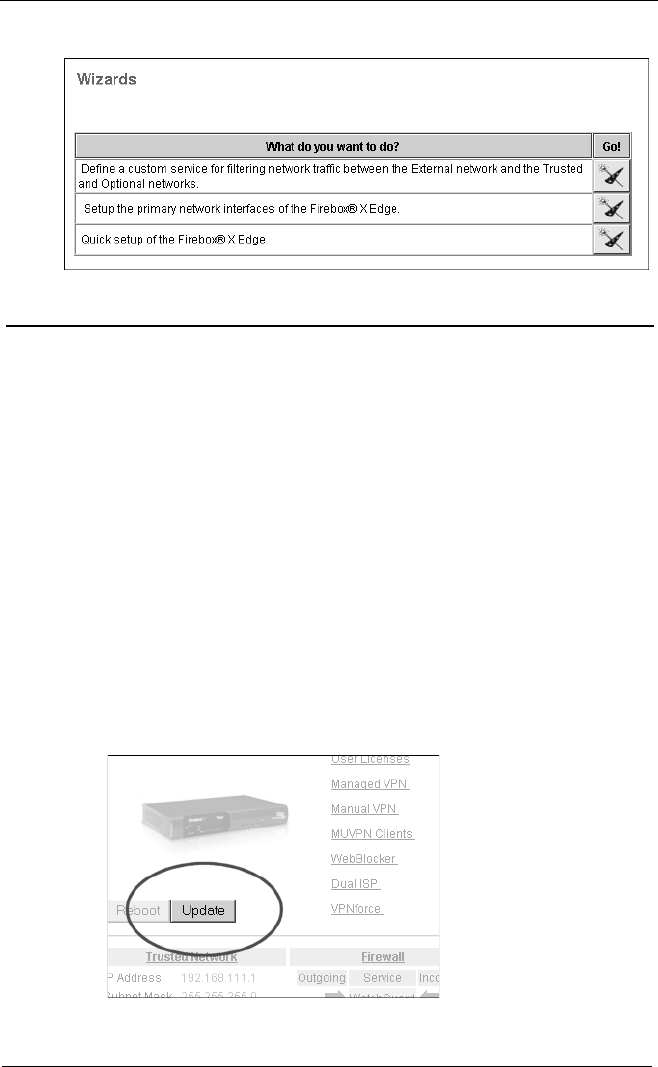
Configuration and Management Basics
40 WatchGuard Firebox X Edge
Updating Firebox X Edge Software
One benefit of your LiveSecurity® Service is ongoing software
updates. As new threats appear and WatchGuard adds product
enhancements, you receive alerts to let you know about new ver-
sions of your Firebox® X Edge software.
When you receive the alert, WatchGuard gives you instructions on
how to download the software to your personal computer. After this
download is complete, use the following instructions to update your
Firebox software:
1Type the IP address of the trusted network in your browser
window to connect to the System Status page of the Firebox X
Edge.
The default IP address is https://192.168.111.1.
2At the bottom of the System Status page, click Update.
The Administration Page appears with the End User License Agreement
(EULA). You can also go to this page by selecting Administration >
Update from the navigation bar at left.

Factory Default Settings
User Guide 41
3Read the text of the EULA. If you agree, select the I accept the
above license agreement checkbox.
4Type the name of the file containing the new Firebox X Edge
software in the Select file box or click Browse to find the file
on your local computer.
5Click Update.
The Firebox makes sure the software package is a legimate software
upgrade. It then copies the new software to the system and reboots. This
can take 15 to 45 seconds. When the update is complete, the System
Status page appears and shows the new version number.
Factory Default Settings
The term
factory default settings
refers to how the Firebox® X Edge
is configured when you first receive it—before you have made any
changes of your own to the configuration. The default network and
configuration settings for the Firebox X Edge are as follows:
Trusted network
- The default IP address for the trusted network is 192.168.111.1.
The subnet mask for the trusted network is 255.255.255.0.
- The Firebox X Edge is configured to give IP addresses to
computers on the trusted network through DHCP. You can also
give static addresses to computers in the trusted network with
IP addresses in the 192.168.111.2–192.168.111.254 range.
External network
- The external network settings use DHCP.
Optional network
- The optional network is disabled.
Firewall settings
- All incoming services are blocked.
- An outgoing service allows all outbound traffic.
- All of the options on the Firewall Options page are disabled.
System Security
- The System Security is disabled. The system administrator name
and system administrator passphrase are not set. All computers
on the trusted network can see the configuration pages.
- Remote Management is disabled.

Configuration and Management Basics
42 WatchGuard Firebox X Edge
- VPN Manager Access is disabled.
- Remote logging is not configured.
WebBlocker
- The WebBlocker feature is disabled and the settings are not
configured.
Upgrade Options
- The upgrade options are disabled until you type the license
keys into the configuration page.
Resetting the Firebox to the factory default settings
You might have a reason to set the Firebox to the factory default
settings. For example, you might be unable to correct a configura-
tion problem and just want to “start over.” Sometimes, a reset is
your only choice: such as if the system security passphrase is
unknown or the firmware of the Firebox X Edge is damaged by a
power interruption.
You should have a copy of the most recent Firebox X Edge software
on your local computer before you try to return to factory default
settings.
Follow these steps to set the Firebox to the factory default settings:
1Disconnect the power supply.
2Hold down the Reset button, located on the front of the
Firebox.
3Connect the power supply while you continue to hold down the
Reset button.
4Continue to hold down the button until the red light on the
front of the Firebox blinks in a steady pattern (about 15
seconds).
5Disconnect the power supply.
6Reconnect the power supply.
The Power indicator is on and the reset is complete.
Rebooting the Firebox
You can reboot the Firebox® X Edge from a computer on the trusted
network. You can also reboot the Firebox from a computer with the
Internet to connect to the Firebox external interface.
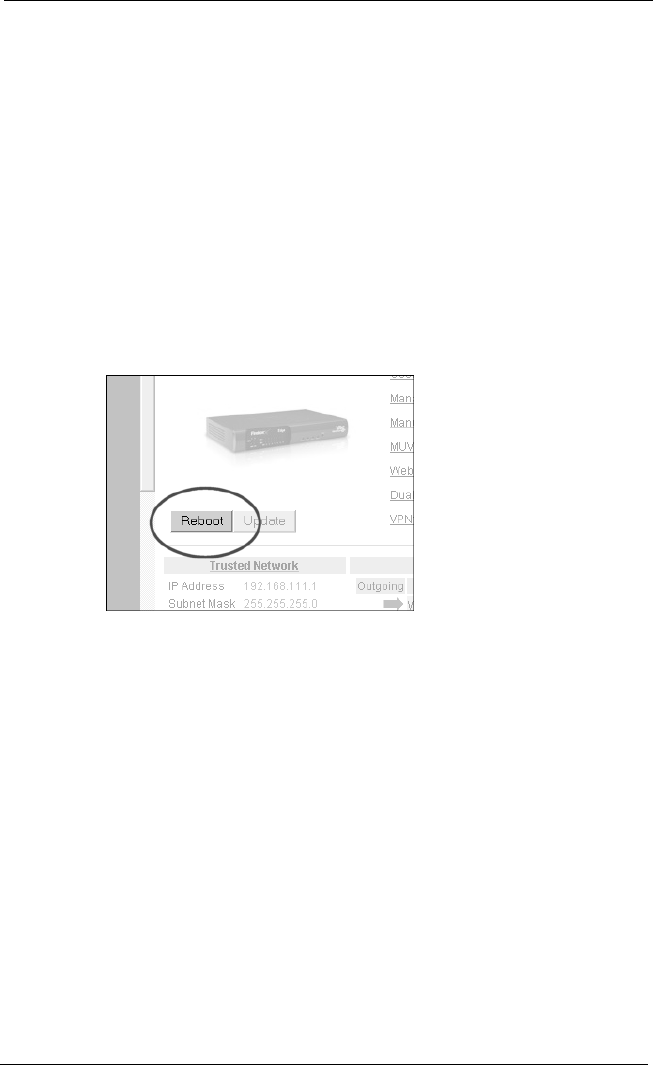
Rebooting the Firebox
User Guide 43
The Firebox reboot cycle is up to 30 seconds. During the reboot
cycle, the mode light on the front of the Firebox turns off and then
turns on again.
Local reboot
You can locally reboot the Firebox X Edge either with the Web
browser or by disconnecting the power supply.
Using the Web browser
1Type the IP address of the trusted network in your browser
window to connect to the System Status page of the Firebox X
Edge.
The default IP address is: https://192.168.111.1
2Click Reboot.
Disconnecting the power supply
Disconnect the Firebox power supply. After a minimum of 10 sec-
onds, connect the power supply.
Remote reboot
You must configure the remote Firebox X Edge to send incoming
HTTP (Web) or FTP traffic to the Firebox’s trusted interface IP
address if you want to use the following method to reboot it. For
more information on how to configure the Firebox to receive incom-
ing traffic, see “Configuring Incoming and Outgoing Policies” on
page 65. Also, see the following FAQ for more information on con-
figuring a Firebox X Edge to receive incoming traffic:

Configuration and Management Basics
44 WatchGuard Firebox X Edge
https://www.watchguard.com/support/tutorials/
stepsoho_remotemanage.asp
1Type the external network IP address of the remote Firebox X
Edge in your browser window to connect to its System Status
page.
2Click Reboot.

User Guide 45
CHAPTER 4 Changing Your
Network Settings
A primary task to set up your WatchGuard® Firebox® X Edge is to con-
figure the network IP addresses. At a minimum, you must configure
the external network and the trusted network to let traffic flow
through the Edge. You can also set up the optional interface. Many
customers use the optional network for public servers. An example of a
public server is a Web server.
You can use the Quick Setup Wizard to set up your network IP
addresses. You can also manually set up or change your network IP
addresses on the Network page.
Using the Network Setup Wizard
The easiest procedure to set up your network IP addresses is with the
Network Setup Wizard.
1To connect to the System Status page, type the IP address of the
trusted network in the browser.
The default IP address is: https://192.168.111.1.
2From the navigation bar, select Wizards.
3Next to Setup the primary network interfaces of the Firebox X
Edge, click Go.

Changing Your Network Settings
46 WatchGuard Firebox X Edge
4Work through the wizard, following the instructions on the
screens. Steps associated with optional functionality you decide
not to enable are automatically skipped by the wizard.
The Network Setup Wizard consists of the following steps:
Step 1: Welcome
The first screen describes the purpose of the wizard.
Step 2: Configure the External Interface of your Firebox
The next screen asks the method your ISP uses to set your IP
address. For more information, see the next section in this guide,
“Configuring the External Network.”
Step 3a: Configure the External Interface for DHCP
On the next screen, type in your DHCP identification as provided
by your ISP. For more information, see “If your ISP uses DHCP”
on page 47.
Step 3b: Configure the External Interface for PPPoE
On the next screen, type in your PPPoE information as provided
by your ISP. For more information, see “If your ISP uses PPPoE”
on page 48.
Step 3c: Configure the External Interface with a static IP
address
On the next screen, type in your static IP address information as
provided by your ISP. For more information, see “If your ISP uses
static IP addresses” on page 48.
Step 4: Configure the Trusted Interface of the Firebox
On the next screen, type the IP address of the trusted interface.
For more information, see “Configuring the Trusted Network” on
page 50.
Step 5: Change the User Name and Passphrase
The next screen enables you to set a username and passphrase
for the Edge.
Step 6: The Network Setup Wizard is complete
Configuring the External Network
You must configure your external network manually if you choose
not to use the Network Setup wizard.

Configuring the External Network
User Guide 47
When you configure the external network, set how your Internet
Service Provider (ISP) gives an IP address to your Firebox. There are
three methods to give IP addresses:
•DHCP - Network administrators use the Dynamic Host
Configuration Protocol (DHCP) to give IP addresses to
computers on their network automatically. With DHCP, your
Firebox can receive a new external address each time it connects
to the ISP network.
•Static IP address - Network administrators use static IP
addresses to manually give an IP address to each computer on
their network. Because more work is necessary with this
procedure, an ISP frequently charges more for a static IP
address. Static IP addresses are also known as manual addresses.
•PPPoE - Many ISPs use the Point to Point Protocol over
Ethernet (PPPoE) to give IP addresses to each computer on their
network. Frequently they use PPPoE with a dial-up network
infrastructure.
To configure your Firebox® X Edge, you must know how it gets the
IP address for the external interface. If you do not know the
method, get the information from your ISP or corporate network
administrator.
If your ISP uses DHCP
The default configuration sets the Firebox X Edge to get the exter-
nal address information through DHCP. If your ISP uses DHCP, your
Edge gets a new external IP address when it starts and connects to
the ISP network.
For more information about DHCP, see “About DHCP” on page 5.
To manually set your Firebox to use DHCP on the external interface:
1To connect to the System Status page, type the IP address of
the trusted network in the browser.
The default IP address is: https://192.168.111.1
2From the navigation bar, select Network > External.
The External Network Configuration page appears.
3From the Configuration Mode drop-down list,
select DHCP Client.
4Click Submit.
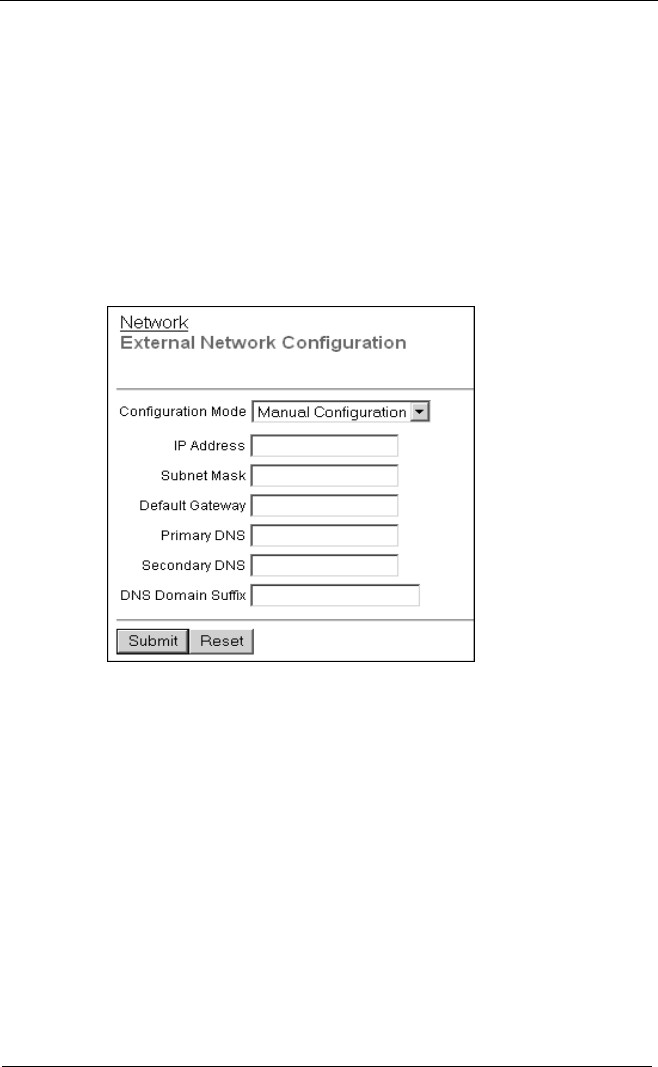
Changing Your Network Settings
48 WatchGuard Firebox X Edge
If your ISP uses static IP addresses
If your ISP uses static IP addresses, you must enter the address infor-
mation into your Edge before it can send traffic through the exter-
nal interface.
To set your Edge to use a static IP address for the external interface:
1Use your browser to connect to the System Status page. From
the navigation bar, select Network > External.
The External Network Configuration page appears.
2From the Configuration Mode drop-down list, select
Manual Configuration.
3Type the IP address, Subnet Mask, Default Gateway, Primary
DNS, Secondary DNS and DNS Domain Suffix into the related
fields.
Get this information from your ISP or corporate network
administrator.
If you completed the table on page 14, type the information from the
table.
4Click Submit.
If your ISP uses PPPoE
If your ISP uses PPPoE, you must enter the PPPoE information into
your Firebox before it can send traffic through the external inter-
face. For more information in PPPoE, see “About PPPoE” on page 6.
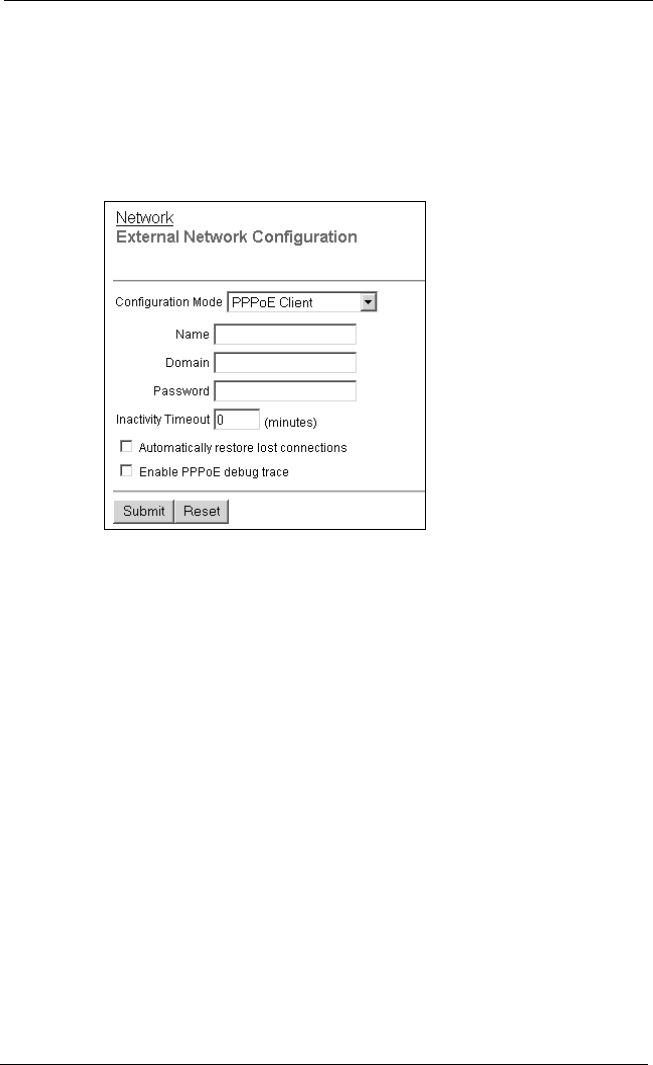
Configuring the External Network
User Guide 49
To set your Firebox to use PPPoE on the external interface:
1Use your browser to connect to the System Status page. From
the navigation bar, select Network > External.
The External Network Configuration page appears.
2From the Configuration Mode drop-down list,
select PPPoE Client.
3Type the Name and Password in the related fields. Get this
information from your ISP. If your ISP gives you a domain
name, type it into the Domain field.
Most ISPs make the domain name section of the PPPoE name (e.g.
myname@ispdomain). If you have a PPPoE name with this format, type
the myname section in the Name field. Type the ispdomain section in
the Domain field. Do not type the @ symbol. Some ISPs do not use the
Domain.
4Type the time before the Firebox disconnects inactive TCP
connections.
We recommend a value of 20.
5If necessary, select the Automatically restore lost connections
check box.
The Firebox can keep a constant traffic flow to the PPPoE server. This
flow keeps the PPPoE connection open when there is frequent packet
loss. If the traffic flow stops, the Firebox restarts to make the connection
again. The PPPoE server reads the constant traffic flow as a continuous
connection. Many ISPs charge more if you use this option.
6WatchGuard Technical Support uses the Enable PPPoE debug
trace check box to troubleshoot PPPoE problems. With this

Changing Your Network Settings
50 WatchGuard Firebox X Edge
option on, the Firebox makes a file which you can send to
Technical Support. Only use this option when Technical Support
tells you. This option decreases Firebox performance.
7Click Submit.
Configuring the Trusted Network
You must configure your trusted network manually if you choose
not to use the Network Setup wizard.
You can use static IP addresses or DHCP for your trusted network.
The Firebox® X Edge has a DHCP server to give IP addresses to com-
puters on your trusted and optional networks. You can also change
the IP address of the trusted network.
With a factory default Firebox, its DHCP server automatically gives
IP addresses to computers on the trusted network. The trusted net-
work starts with IP address 192.168.111.1. It is a “class C” network
with a subnet mask of 255.255.255.0. The Firebox can give an IP
address from 192.168.111.2 to 192.168.111.252. The factory default
configuration uses the same DNS and domain name as it uses for
the external interface. For more information, see “IP Addresses” on
page 5.
If necessary, you can disable the Firebox DHCP server. The Firebox
can forward the DHCP requests to a DHCP server on a different net-
work. You can also use static IP addresses for the computers on your
trusted network.
N
OTE
N
OTE
You can make one or more changes to the trusted network,
Submit each change, then Reboot only once to enable all of the
changes. You must Reboot the Firebox to enable a change to the
trusted network configuration.
You can make many changes and click Submit. Any change to the
trusted network configuration All changes to the Trusted Network
Configuration page require that you click Submit and then reboot
the Firebox before they take effect.But you can make all the
changes you want to make and then reboot just once when you are
done.

Configuring the Trusted Network
User Guide 51
Changing the IP address of the trusted network
If necessary, you can change the trusted network address. For exam-
ple, if you connect two or more Firebox devices in a virtual private
network, each Firebox must use a different trusted network address.
For more information, see “What You Need to Create a VPN” on
page 107.
To change the IP address of the trusted network:
1To connect to the System Status page, type the IP address of
the trusted network in the browser.
The default IP address is: https://192.168.111.1
2From the navigation bar, select Network > Trusted.
The Trusted Network Configuration page appears.
3Type the first address of the new network address range in the
IP Address text field.
4If necessary, type the new subnet mask.
Most networks use 255.255.255.0 which includes 252 addresses.
Using DHCP on the trusted network
The DHCP Server option sets the Firebox X Edge to give IP addresses
to the computers on the trusted network. When the Firebox receives
a DHCP request from a computer on the trusted network, it gives
the computer an IP address. A factory default Firebox has the DHCP
Server option for the trusted interface on.
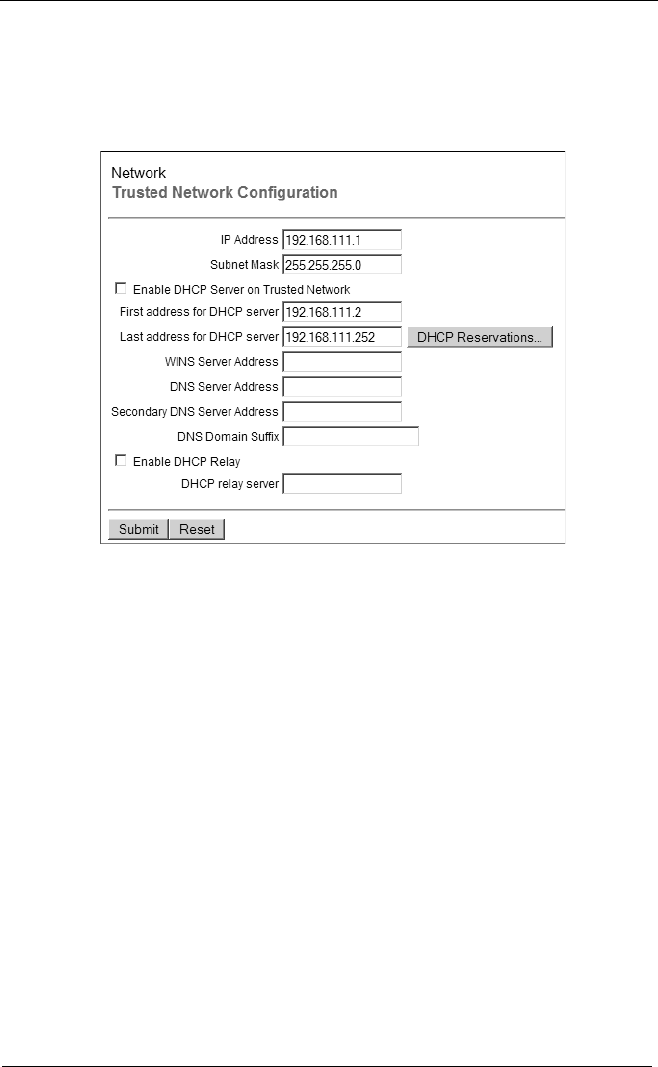
Changing Your Network Settings
52 WatchGuard Firebox X Edge
To use DHCP on the trusted network:
1Use your browser to connect to the System Status page. From
the navigation bar, select Network > Trusted.
The Trusted Network Configuration page appears.
2Select the Enable DHCP Server on the Trusted Network check
box.
3Type the first available IP address for the trusted network. Type
last IP address.
The IP addresses must be on the same network as the trusted IP address.
For example, if your trusted IP address is 192.168.200.1, the IP addresses
can be from 192.168.200.2 to 192.168.200.252.
4Type the WINS Server Address, DNS Server Primary Address,
DNS Server Secondary Address, and DNS Domain Suffix in the
related fields.
Use these field if you have a WINS or DNS server. If you do not enter a
value, the Firebox uses the same values as those used for the external
network.
5Click Submit.
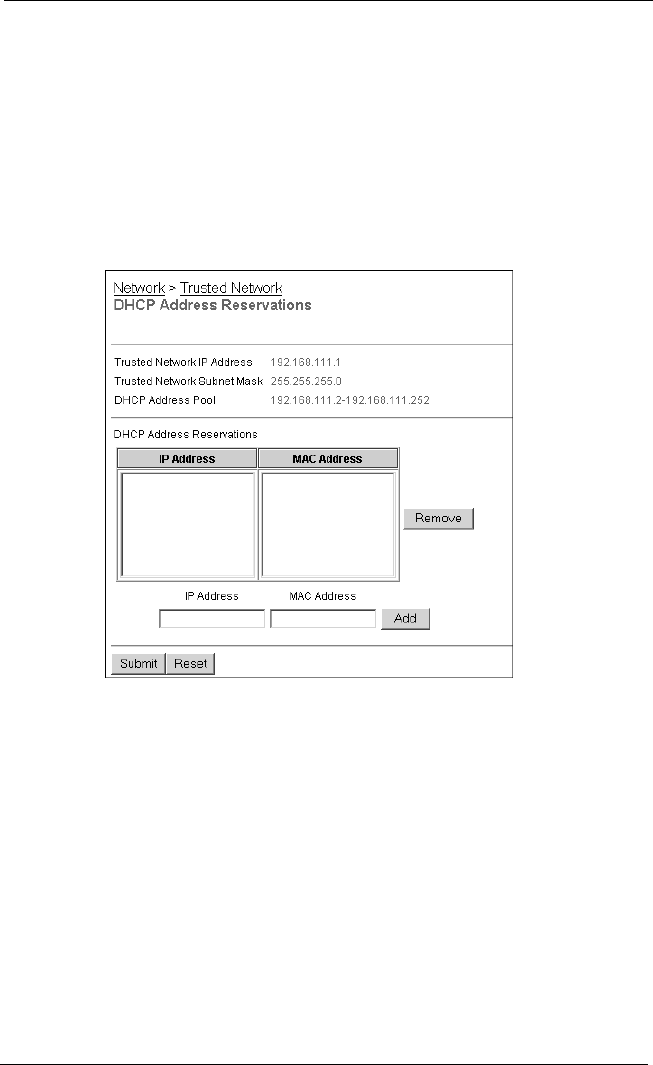
Configuring the Trusted Network
User Guide 53
Setting trusted network DHCP address reservations
You can manually give an IP address to a specified computer on
your trusted network. The Firebox identifies the computer by its
MAC address.
1Use your browser to connect to the System Status page. From
the navigation bar, select Network > Trusted.
The Trusted Network Configuration page appears.
2Click the DHCP Reservations button.
The DHCP Address Reservations page appears.
3Type a static IP address in the IP Address field. The IP address
must be on the trusted network.
For example, if the trusted network starts with 192.168.111.1, you can
enter 192.168.111.2 to 192.168.111.251.
4Type the MAC address of the computer on the trusted network
in the MAC Address field. Click Add.
5Click Submit.
Configuring the trusted network for DHCP relay
One method to get IP addresses for the computers on the Firebox
trusted network is to use a DHCP server on a different network. The
Firebox can send a DHCP request to a DHCP server at a different
location. It gives the reply to the computers on the Firebox trusted

Changing Your Network Settings
54 WatchGuard Firebox X Edge
network. This option lets computers in more than one office use the
same network address range. This procedure makes the Firebox a
DHCP relay agent
.
To configure the Firebox as a DHCP relay agent for the trusted
interface:
1Use your browser to connect to the System Status page. From
the navigation bar, select Network > Trusted.
The Trusted Network Configuration page appears.
2Select the Enable DHCP Relay check box.
3Type the IP address of the DHCP server in the related field.
4Click Submit.
The Firebox restarts. If the Firebox can not connect to the DHCP server in
30 seconds, it uses its DHCP server to give IP addresses to computers on
the trusted network.
Using static IP addresses for trusted computers
You can use static IP addresses for some or all of the computers on
your trusted network. If you disable the DHCP server, you must
manually configure the IP address and subnet mask of each com-
puter. You can also configure specified computers with a static IP
address. For example, this is necessary when a client server software
application must use a static IP address for the server. Static IP
addresses must be on the same network as the Firebox trusted inter-
face.
To disable the Firebox DHCP server, clear the Enable DHCP Server
on the Trusted Network check box on the Trusted Network Config-
uration page.
Adding computers to the trusted network
The Firebox X Edge can connect to one to seven trusted computers.
You can use 10/100 BaseT Ethernet hubs or switches with RJ-45
connectors to connect more than seven computers. It is not neces-
sary that the computers on the trusted network use the same oper-
ating system.
To add more than seven computers to the trusted network:
1Make sure that each computer has a functional Ethernet card.
2Set each computer to use DHCP. For more information, see
“Setting your computer to use DHCP,” on page 20.

Configuring the Optional Network
User Guide 55
3Connect each computer to the network. Use the procedure
“Cabling the Firebox X Edge for more than seven devices” on
page 18.
4Restart each computer.
Configuring the Optional Network
The optional network is an isolated network for less secure public
resources. Many customers use the optional network for public com-
puters such as a Web, e-mail, or FTP server. A factory default Fire-
box does not connect the trusted network to the optional network.
While you can enable traffic between these networks, this procedure
decreases security for the trusted network. For more information,
see “Adding a Policy for the Optional Interface” on page 83.
You can use the Firebox® X Edge DHCP server or you can use static
IP addresses for computers on the optional network. You can also
change the IP address range of the optional network.
Many public servers must have a static IP address. For increased
security, we recommend that you disable DHCP on the optional net-
work. If it is necessary to protect your servers from Internet traffic,
you can put your user computers on the optional network and your
servers on the more secure trusted network.
N
OTE
N
OTE
You can make one or more changes to the optional network,
Submit each change, then Reboot only once to enable all of the
changes. You must Reboot the Firebox to enable a change to the
optional network configuration.
Enabling the optional network
1To connect to the System Status page, type the IP address of
the trusted network in the browser.
The default IP address is: https://192.168.111.1
2From the navigation bar, select Network > Optional.
The Optional Network Configuration page appears.
3Select the Enable Optional Network check box.
Changing the IP address of the optional network
If necessary, you can change the optional network address. For
example, you can isolate a wireless network from the trusted net-

Changing Your Network Settings
56 WatchGuard Firebox X Edge
work. A factory default Firebox has the trusted network and the
optional network on 2 different subnets.
To change the IP address of the optional network:
1To connect to the System Status page, type the IP address of
the trusted network in the browser.
The default IP address is: https://192.168.111.1
2From the navigation bar, select Network > Optional.
The Optional Network Configuration page appears.
3Type the first address of the new network address range in the
IP Address text field.
4If necessary, type the new subnet mask.
Most networks use 255.255.255.0 which includes 252 addresses.
Using DHCP on the optional network
The DHCP Server option sets the Firebox X Edge to give IP addresses
to the computers on the optional network. When the Firebox
receives a DHCP request from a computer on the optional network,
it gives the computer an IP address. A factory default Firebox has
the DHCP Server option for the optional interface off.
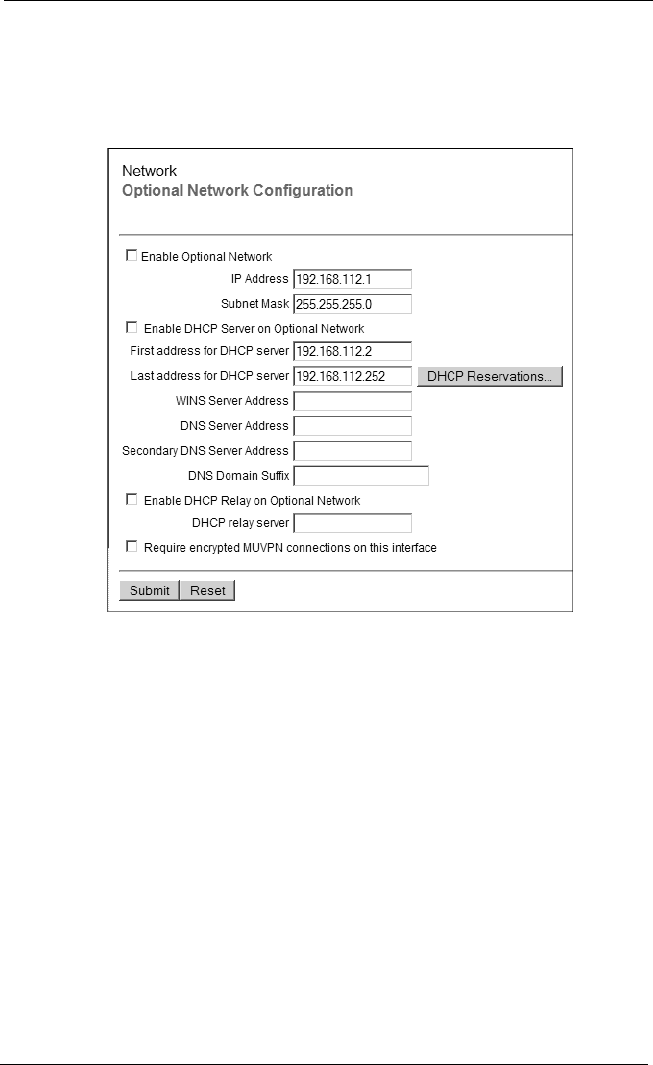
Configuring the Optional Network
User Guide 57
To use DHCP on the optional network:
1Use your browser to connect to the System Status page. From
the navigation bar, select Network > Optional.
The Optional Network Configuration page appears.
2Select the Enable DHCP Server on the Optional Network check
box.
3Type the first available IP address for the optional network. Type
last IP address.
The IP addresses must be on the same network as the optional IP
address. For example, if your optional IP address is 192.168.112.1, the IP
addresses can be from 192.168.112.2 to 192.168.112.252.
4Type the WINS Server Address, DNS Server Primary Address,
DNS Server Secondary Address, and DNS Domain Suffix in the
related fields.
Use these field if you have a WINS or DNS server. If you do not enter a
value, the Firebox uses the same values as those used for the external
network.
5Click Submit.
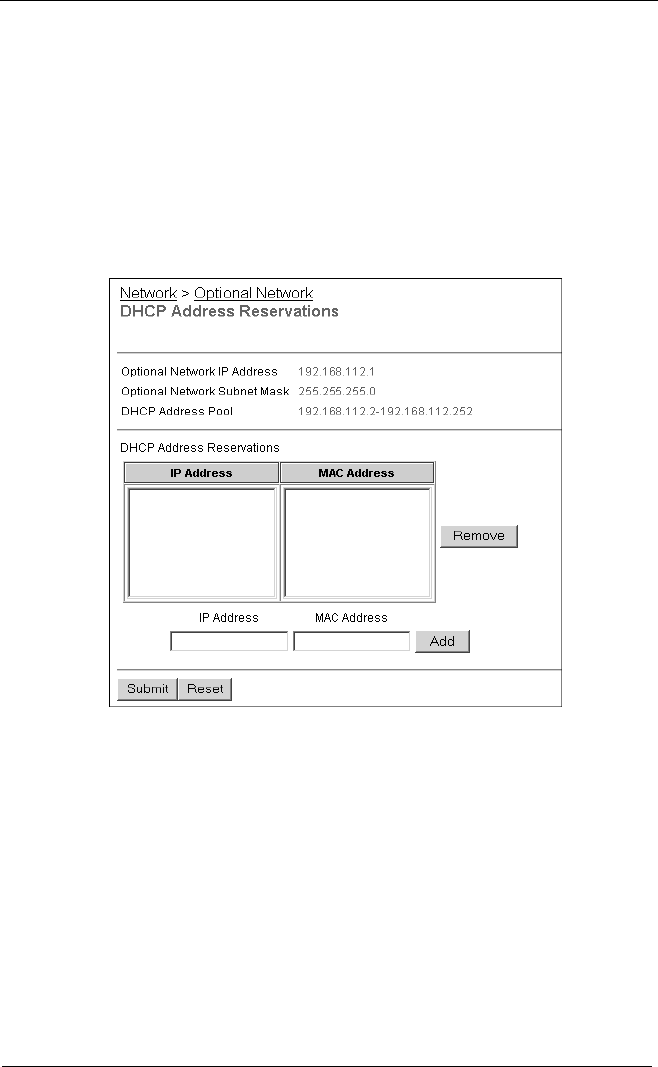
Changing Your Network Settings
58 WatchGuard Firebox X Edge
Setting optional network DHCP address reservations
You can manually give an IP address to a specified computer on
your optional network. The Firebox identifies the computer by its
MAC address.
1Use your browser to connect to the System Status page. From
the navigation bar, select Network > Optional.
The Optional Network Configuration page appears.
2Click the DHCP Reservations button.
The DHCP Address Reservations page appears.
3Type a static IP address in the IP Address field. The IP address
must be on the optional network.
For example, if the optional network starts with 192.168.112.1, you can
enter 192.168.112.2 to 192.168.112.251.
4Type the MAC address of the computer on the optional network
in the MAC Address field. Click Add.
5Click Submit.
Configuring the optional network for DHCP relay
One method to get IP addresses for the computers on the Firebox
optional network is to use a DHCP server on a different network.
The Firebox can send a DHCP request to a DHCP server at a different

Configuring the Optional Network
User Guide 59
location. It gives the reply to the computers on the Firebox optional
network. This option lets computers in more than one office use the
same network address range. This procedure makes the Firebox a
DHCP relay agent
.
To configure the Firebox as a DHCP relay agent for the optional
interface:
1Use your browser to connect to the System Status page. From
the navigation bar, select Network > Optional.
The Optional Network Configuration page appears.
2Select the Enable DHCP Relay on Optional Network check box.
3Type the IP address of the DHCP server in the related field.
4Click Submit.
The Firebox restarts. If the Firebox can not connect to the DHCP server in
30 seconds, it uses its DHCP server to give IP addresses to computers on
the optional network.
Using static IP addresses for optional computers
You can use static IP addresses for some or all of the computers on
your optional network. If you disable the DHCP server, you must
manually configure the IP address and subnet mask of each com-
puter. You can also configure specified computers with a static IP
address. For example, this is necessary when a client server software
application must use a static IP address for the server. Static IP
addresses must be on the same network as the Firebox optional
interface.
To disable the Firebox DHCP server, clear the Enable DHCP Server
on the Optional Network check box on the Optional Network Con-
figuration page.
Adding computers to the optional network
The Firebox X Edge can connect to 1 optional computer. You can
use 10/100 BaseT Ethernet hubs or switches with RJ-45 connectors
to connect more than 1 computer. It is not necessary that the com-
puters on the optional network use the same operating system.
To add more than 1 computers to the optional network:
1Make sure that each computer has a functional Ethernet card.
2Set each computer to use DHCP. For more information, see
“Setting your computer to use DHCP,” on page 20.

Changing Your Network Settings
60 WatchGuard Firebox X Edge
3Connect each computer to the network. Use the procedure
“Cabling the Firebox X Edge for more than seven devices” on
page 18.
4Restart each computer.
N
OTE
N
OTE
All changes to the Optional Network Configuration page require
that you click Submit and then reboot the Firebox before they
take effect. But you can make all the changes you want to make
and then reboot just once when you are done.
You can either enable or disable the DHCP server on the optional
network.
Requiring encrypted connections
You can set the optional interface to use only encrypted connec-
tions. Frequently a customer uses this option to make a secure wire-
less network. The wireless connections use the Mobile User VPN
client. The client encrypts all traffic from the optional interface to
the Firebox. A “drive-by” hacker can not read the encrypted traffic
on the wireless network.
Making Static Routes
You can configure the Firebox to send specified traffic to different
parts of the Firebox® X Edge trusted network connected by a router
or switch. Use the Routes page to make a static route:
1To connect to the System Status page, type the IP address of
the trusted network in the browser.
The default IP address is: https://192.168.111.1
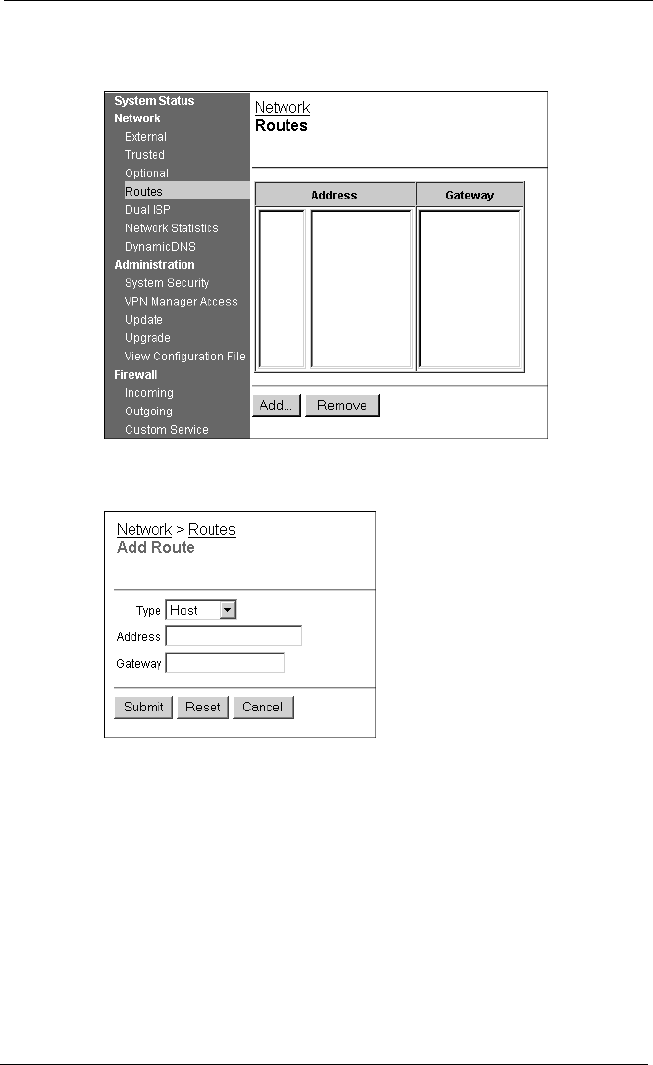
Making Static Routes
User Guide 61
2From the navigation bar, select Network > Routes.
The Routes page appears.
3Click Add.
The Add Route page appears.
4From the Type drop-down list, select either Host or Network.
A host is 1 computer. A network is more than one computer which use a
range of IP addresses.
5Type the destination IP address and the gateway in the related
fields.
The Gateway is the ylocal interface of the router.
6Click Submit.
To remove a static route, click the IP address and click Remove.
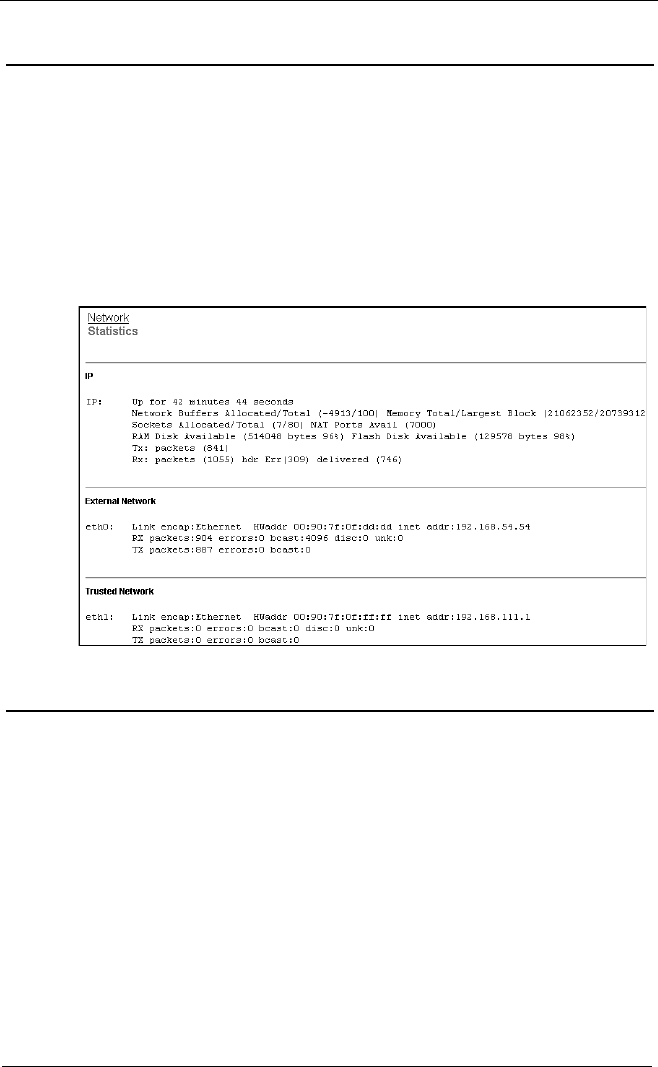
Changing Your Network Settings
62 WatchGuard Firebox X Edge
Viewing Network Statistics
The Firebox® X Edge Network Statistics page shows information
about the performance. Network administrators frequently use this
page to troubleshoot a problem with the Firebox or network.
1To connect to the System Status page, type the IP address of
the trusted network in the browser.
The default IP address is: https://192.168.111.1
2From the navigation bar, select Network > Network Statistics.
The Network Statistics page appears.
Registering with the Dynamic DNS Service
You can register the external IP address of the Firebox® X Edge with
the dynamic Domain Name Server (DNS) service DynDNS.org. A
dynamic DNS service makes sure that the IP address attached to
your domain name changes when your ISP gives you a new IP
address. For more information, click Information about Dynamic
DNS available here.
You can also see these WatchGuard FAQs:
What is Dynamic DNS?
How do I set up Dynamic DNS?
https://www.watchguard.com/support/AdvancedFaqs/sogen_main.asp
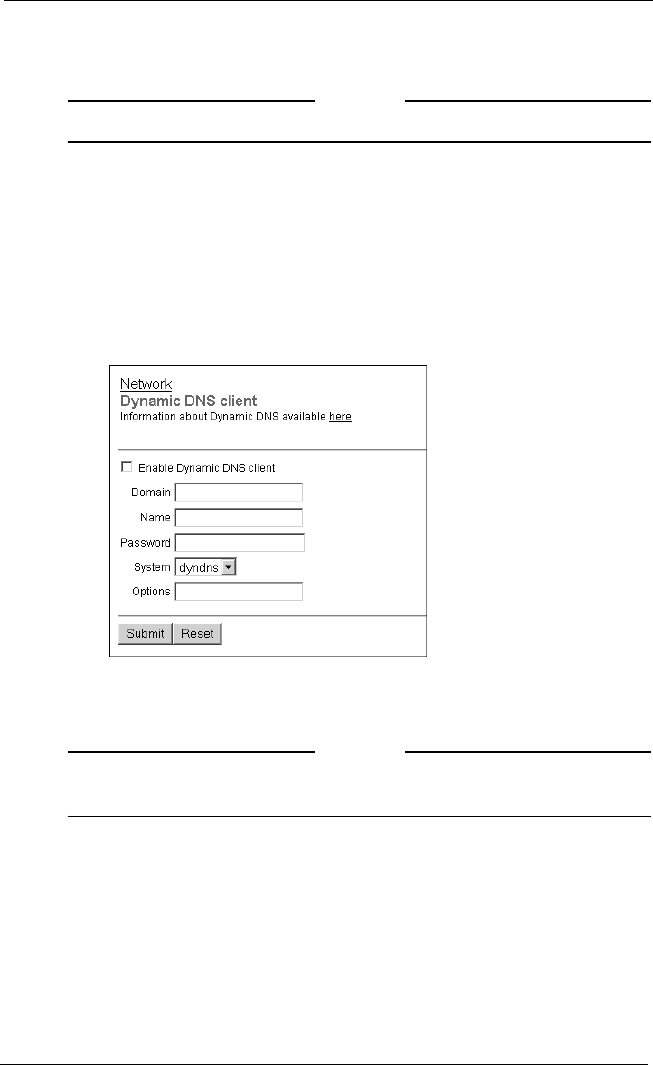
Registering with the Dynamic DNS Service
User Guide 63
After you click this link, log into your LiveSecurity Service account
to see the FAQ.
N
OTE
N
OTE
WatchGuard is not affiliated with DynDNS.org.
1Create a dynamic DNS account.
For more information, see the Technical Support FAQ “How do I set up
Dynamic DNS?
1To connect to the System Status page, type the IP address of
the trusted network in the browser.
The default IP address is: https://192.168.111.1
2From the navigation bar, select Network > Dynamic DNS.
The Dynamic DNS client page appears.
3Select the Enable Dynamic DNS client check box.
4Type the Domain, Name, and Password in the related fields.
N
OTE
N
OTE
The Firebox gets the IP address of members.dyndns.org when it
connects to the time server.
5System???
6Options???
7Click Submit.

Changing Your Network Settings
64 WatchGuard Firebox X Edge
Enabling the WAN Failover Option
The WAN Failover option adds redundant support for the external
interface. With this option, the Firebox® X Edge starts a connection
through the WAN2 port when the primary external interface (WAN1)
can not send traffic. Companies use this option if they must have a
constant connection. You must get a second Internet connection to
use this option.
It is not necessary to configure new services to use this option. The
failover interface uses the same services and network properties as
the external interface.
The Firebox uses two methods to find out if the external interface is
functional:
• The status of the link to the nearest router
• A ping command to a specified location
The Firebox pings the default gateway or a computer specified by
the administrator. If there is no reply, the Firebox changes to the
secondary external network interface (WAN2).
When you enable the WAN Failover, the Firebox does the following:
• If the WAN1 interface connection stops, the Firebox starts to
use WAN2 interface.
• If the WAN2 interface connection stops, the Firebox starts to
use the WAN1 interface.
• If the WAN1 interface and the WAN2 interface stop, the Firebox
tries the 2 interfaces until it makes a connection.
When the WAN2 is in use, the Firebox does not switch back to the
WAN1 port unless PPPoE is used to assign IP addresses. After the
Firebox switches to the WAN2 port, the administrator must change
the configuration back to the WAN1 port when the connection is
restored.
If you use PPPoE, you can set an inactivity timeout that disables
inactive TCP connections during periods of inactivity. See “If your
ISP uses PPPoE” on page 48 for PPPoE configuration information. If
your external connection fails, the WAN2 port connection is started
and used. The WAN2 port is used until the TCP connection becomes
inactive (timeout). When the traffic continues, the Firebox connects
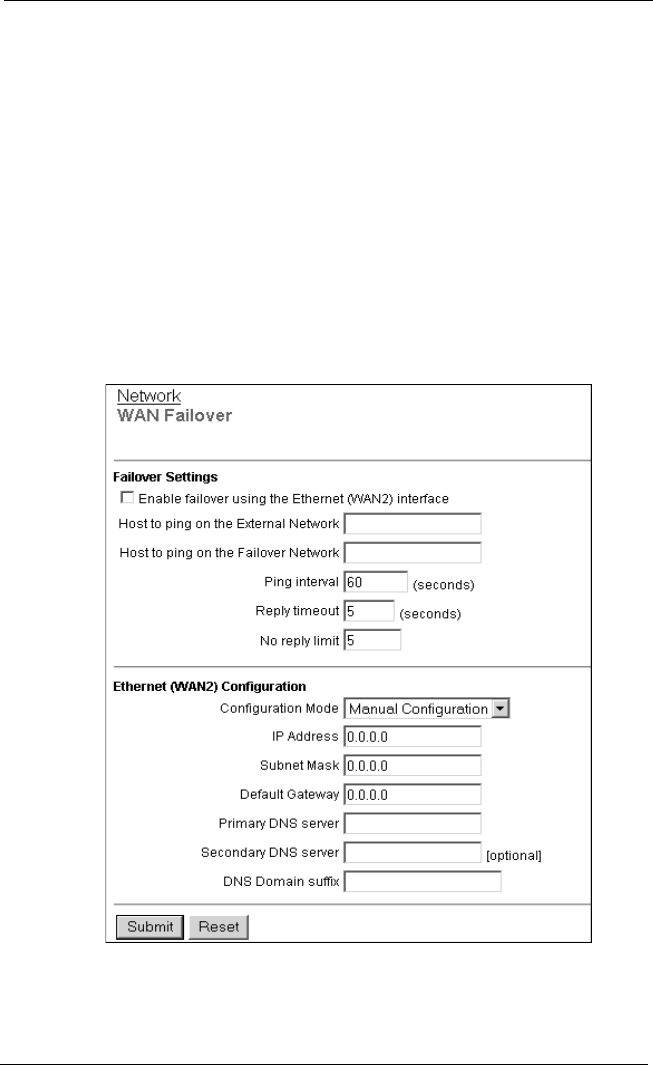
Enabling the WAN Failover Option
User Guide 65
through the WAN1 port first. If a connection is made, the WAN1port
is used. If the WAN1 port is not available, the Firebox connects
through the WAN2 port.
To configure the WAN failover network:
1Connect one end of a straight through Ethernet cable to the
WAN2 interface. Connect the other end to the source of the
secondary external network connection. This connection can be
a cable modem or a hub.
2To connect to the System Status page, type the IP address of
the trusted network in the browser.
The default IP address is: https://192.168.111.1
3From the navigation bar, select Network > WAN Failover.
The WAN Failover page appears.
4Select the Enable failover using the Ethernet (WAN2)
interface check box.

Changing Your Network Settings
66 WatchGuard Firebox X Edge
5From the drop-down list, select the interface for the feature:
Ethernet or modem (see the next section for additional
information on using a modem).
6Type the IP addresses of the hosts to ping for WAN1 and WAN2
interfaces in the applicable fields.
7Type the number of seconds between pings and the number of
seconds to wait for a reply in the applicable fields.
8Type the limit number of pings before timeout in the applicable
field.
9Click Submit.
Enabling External Modem Failover
Using the Firebox X Edge, you can specify that upon failover the
Edge can contact a remote secondary host for routing traffic by way
of a modem. For a list of the types of modem supported, see [FAQ?]
1From the drop-down list on the WAN Failover page, select
Modem (serial port).
2Under Dial Up Account Settings, use the drop-down list to
select your ISP. The following ISPs are supported: Standard PPP,
AOL, AT&T Worldnet, CompuServe 4.0, EarthLink, MSN, and
Qwest.
3Type the telephone number of your ISP. Optionally, you can also
type an alternate telephone number.
4Type the account name used by your ISP for your modem.
5(Optional) If you use the login to your account with a domain
name (such as aol.com), enter it in Account Domain.
6Enter the account password.
7If you want to enable automatically restoring lost connections,
select the corresponding checkbox.
8If you want to enable modem and PPP debug trace, select the
corresponding checkbox.
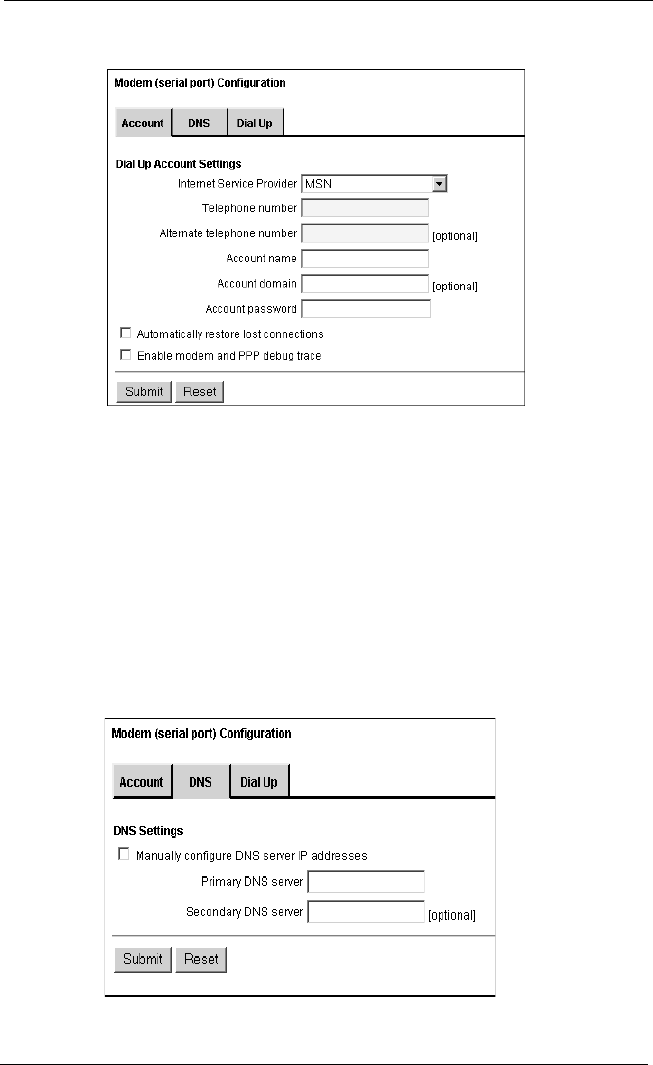
Enabling External Modem Failover
User Guide 67
DNS settings
If your server is not using DHCP and doesn’t specify the location of
the DNS server, you must manually enter IP addresses for your DNS
server:
1Select the Manually configure DNS server IP addresses
checkbox.
2In the Primary DNS Server text box, enter the IP address of the
primary DNS server.
3(Optional) In the Secondary DNS Server text box, enter the IP
address of the secondary DNS server.
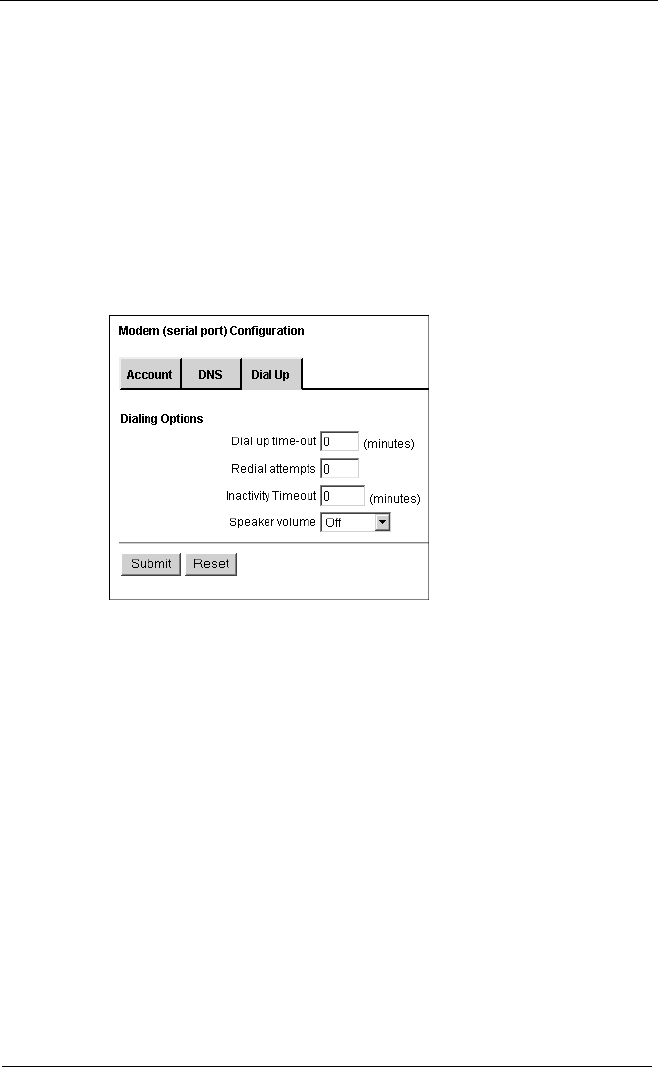
Changing Your Network Settings
68 WatchGuard Firebox X Edge
Dialup settings
1In the Dial up timeout field, enter the number of seconds
before timeout if your modem doesn’t connect.
2In the Redial attempts field, enter the number of attempts
made if your modem doesn’t connect
3In the Inactivity timeout field, enter the number of seconds
before timeout if no traffic passes through the modem.
4In the Speaker volume field, set your modem speaker’s volume
to off, low, medium, or high.

User Guide 69
CHAPTER 5 Setting up the Firebox
X Edge Wireless
The Firebox X Edge Wireless protects the computers that are connected
to your network. The Firebox X Edge Wireless also protects network
wireless connections. This chapter shows how to install the Firebox X
Edge Wireless and set up the wireless network.
WatchGuard is concerned about the security of your network so the
wireless feature of the Firebox X Edge Wireless is disabled until you are
ready to use it. Activate the wireless feature when you configure the
security of the wireless connections.
To install the Firebox X Edge Wireless:
• Identify and record your TCP/IP settings
• Disable the HTTP proxy setting of your Web browser
• Activate DHCP on your computer
• Make the physical connections between the Firebox X Edge
Wireless and your network
• Attach the two antennae to the Firebox X Edge Wireless
• Install the Firebox X Edge Wireless in a location more than 20
centimeters from all persons. Put the Firebox X Edge Wireless in a
location away from all other antennae or transmitters.
To set up the wireless network:
• Configure the wireless network

Setting up the Firebox X Edge Wireless
70 WatchGuard Firebox X Edge
• Configure the Wireless Access Point (WAP)
• Configure the wireless card on your computer
How
Wireless Networking Works
Wireless networking uses radio-frequency signals to communicate
with computers and the Firebox X Edge Wireless. The Firebox X Edge
Wireless complies with 802.11b and 802.11g standards defined by
the Institute of Electrical and Electronics Engineers (IEEE).
You must protect a wireless network from unauthorized access.
Without this protection, unauthorized users compromise the security
of your network or make use of your Internet connection.
You increase the security of your corporate network by requiring
users to authenticate as MUVPN clients. A VPN creates a secure
IPSec tunnel from the wireless computer to the Firebox X Edge
Wireless. Another way to increase security is to separate the trusted
network from the optional network.
Connecting to the Firebox X Edge Wireless
The Firebox X Edge Wireless protects all the computers that connect
to your network through the Ethernet ports and wireless connec-
tions of the Firebox. This section shows how to connect computers
to the Firebox X Edge Wireless using Ethernet cables.
The Firebox X Edge Wireless protects one computer or all the com-
puters on a network. The Firebox X Edge Wireless also operates as a
hub to connect other computers.
To set up a wireless network, you connect a computer to the Firebox
X Edge Wireless with an Ethernet cable. The computer (the manage-
ment station) that is connected through an Ethernet cable is used to
configure the wireless network.
Cabling the Firebox X Edge Wireless for one to seven
devices
A maximum of seven computers, printers, scanners or other devices
can connect directly to the Firebox X Edge Wireless. These connec-
tions use the seven Ethernet ports (labeled 0-6). There are also two
WAN ports (WAN1 and WAN2) you use to create dual ISP connec-
tions that provide uninterrupted connectivity. To connect a maxi-

Connecting to the Firebox X Edge Wireless
User Guide 71
mum of seven devices, use the Firebox X Edge Wireless as a network
hub.
1Shut down your computer.
2If you connect to the Internet through a DSL modem or cable
modem, disconnect the power supply to this device.
3Disconnect the Ethernet cable that connects your DSL modem,
cable modem or other Internet connection to your computer.
Connect this cable to the WAN port on the Firebox X Edge
Wireless.
The Firebox X Edge Wireless is connected directly to the modem or other
Internet connection.
4Connect one end of the straight-through Ethernet cable
supplied with your Firebox X Edge Wireless to one of the seven
numbered Ethernet ports (labeled 0-6) on the Firebox X Edge
Wireless. Connect the other end to the Ethernet port of your
computer.
The Firebox X Edge Wireless is connected to the Internet and your
computer.
5If you connect to the Internet through a DSL modem or cable
modem, reconnect the power supply to this device. The
indicator lights flash and then stop. The modem is available for
use.
6Attach the AC adapter to the Firebox X Edge Wireless. Connect
the AC adapter to a power source.
7Restart the computer.
See “Configuring the External Network” on page 46 and “Configur-
ing the Trusted Network” on page 50 for special configurations.
Cabling the Firebox X Edge Wireless for more than
seven devices
Although the Firebox X Edge Wireless has only seven Ethernet ports
(labeled 0-6), you can connect more than seven devices. Use one or
more network hubs to make more connections.
The base model Firebox X Edge Wireless includes a ten-seat license.
This license allows a maximum of ten devices on the trusted net-
work to connect to the Internet at the same time. There can be more
than ten devices on the trusted network, but the Firebox X Edge
Wireless allows only ten Internet connections. A seat is in use when

Setting up the Firebox X Edge Wireless
72 WatchGuard Firebox X Edge
a devices connects to the Internet and is free when the connection
ends. License upgrades are available from the WatchGuard Web site:
http://www.watchguard.com/sales/buyonline.asp
To connect more than seven devices to the Firebox X Edge Wireless,
you need:
• An Ethernet hub
• A straight-through Ethernet cable, with RJ-45 connectors, for
each computer
• A straight-through Ethernet cable to connect each hub to the
Firebox X Edge Wireless.
To connect more than seven devices to the Firebox X Edge:
1Shut down your computer. If you connect to the Internet
through a DSL modem or cable modem, disconnect the power
supply from this device.
2Disconnect the Ethernet cable that runs from your DSL modem,
cable modem, or other Internet connection to your computer.
Connect the Ethernet cable to the WAN port on the Firebox X
Edge Wireless.
The Firebox X Edge Wireless is connected directly to the modem or other
Internet connection.
3Connect one end of the straight-through Ethernet cable
supplied with your Firebox X Edge Wireless to one of the seven
numbered Ethernet ports (labeled 0-6) on the Firebox X Edge
Wireless. Connect the other end to the uplink port of the
Ethernet hub.
The Firebox X Edge Wireless is connected to the Internet and your
Ethernet hub.
4Connect an Ethernet cable between each of the computers and
an uplink port on the Ethernet hub.
5If you connect to the Internet through a DSL modem or cable
modem, reconnect the power supply to this device. The
indicator lights flash and then stop. The modem is available for
use.
6Attach the AC adapter to the Firebox X Edge Wireless. Connect
the AC adapter to a power supply.
7Restart your computer.

Using the Wireless Network Wizard
User Guide 73
Using the Wireless Network Wizard
The Wireless Network Wizard is a tool that you use to automatically
configure your wireless network.
Setting up the Wireless Access Point
WatchGuard is concerned about the security of your network so the
wireless feature of the Firebox X Edge Wireless is disabed until you
are ready to use it. Activate the wireless feature when you configure
the security of the wireless connections.
1Type the IP address of the trusted network in your browser
window to connect to the System Status page of the Firebox X
Edge Wireless.
The default IP address is: https://192.168.111.1
1From the navigation bar, select
Network > Wireless (802.11g).
The Wireless Network Configuration page appears.
2From the Encryption drop-down list, select Disabled.
3From the Authentication drop-down list, select Open System.
4Record the number that appears in the SSID text box of the
Basic Settings for later use.
The SSID (Service Set Identifier) is the identification number of the
wireless device. The SSID is used to create the wireless connection. The
default SSID is the 5-digit serial number for your Firebox X Edge
Wireless.
5Click Submit.
Configuring the Wireless Card on Your Computer
These instructions are for the Windows XP operating system. To see
installation instructions for other operating systems, go to:
http://www.watchguard.com/support/sohoresources/
1Select Start > Settings > Control Panel > Network
Connections.
The Network Connections dialog box appears.
2Double-click Wireless Network Connection.
The Wireless Network Connection dialog box appears.

Setting up the Firebox X Edge Wireless
74 WatchGuard Firebox X Edge
3Select the Wireless Networks tab
4In the Preferred networks section, click Add.
The Wireless Network Properties dialog box appears.
5Type the SSID in the Network Name (SSID) text box. This is the
same number that you recorded from the Wireless Network
Configuration page.
6Click OK to close the Wireless Network Properties dialog box.
7Click Refresh.
All available wireless connections are shown in the Available Networks
text box. Select the SSID of the computer that you want to configure.
8Click OK to enable the wireless connection.
The wireless network connection shows that your wireless network is
active.
9Configure the wireless computer to use DHCP. For additional
information about how to configure DHCP, see “Setting your
computer to use DHCP” on page 20.
The Windows operating system looks for the wireless connection. If more
than one wireless network is discovered, a dialog box appears with a list
of all wireless devices in the area. Select the computer to configure the
Firebox X Edge Wireless.
The Firebox X Edge Wireless is configured to protect the wired and
wireless computers that are attached to it from security hazards.
Wireless Security Options
The Firebox X Edge provides many options from which to choose in
securing your wireless network.
Two of the most important choices are the security settings:
• What type of authentication to use
• The type of encryption to implement
The Firebox X Edge uses two industry-standard security protocols
that provide you with secure wireless protection. They are Wired
Equivalent Privacy (WEP), specified by the IEEE standard 802.11b
and Wi-Fi Protected Access (WPA) supporting theIEEE standard
802.11g. WPA and WEP provide a Wireless Local Area Network
(WLAN) with a level of security and privacy comparable to a wired
Local Area Network (LAN).

Wireless Security Options
User Guide 75
A wired LAN is normally protected by measures such as login cre-
dentials, which are only effective for a controlled physical environ-
ment. Because the radio transmissions of a WLAN are not bound by
the walls containing the network, these measures are insufficient for
a wireless network. WPA and WEP encrypt the transmissions over the
WLAN to provide physical security for the wireless connections
between the computers and the access points. In addition, you must
use other LAN security mechanisms such as password protection,
VPNs, and authentication to ensure privacy.
Follow these instructions to configure the Firebox X Edge Wireless:
1Type the IP address of the trusted network in your browser
window to connect to the System Status page of the Firebox X
Edge Wireless:
The default IP address is: https://192.168.111.1
2From the navigation bar, select Network => Wireless
Configuration.
The Wireless Configuration page appears.
Changing basic settings
The SSID (Service Set Identifier) is the workgroup name of your
Wireless Network. You must configure the wireless network card in
your computer to have the same SSID in order to communicate with
the Firebox X Edge Wireless.
N
OTE
N
OTE
When you complete the wireless configuration you need to restart
the Firebox X Edge wireless.
Network assignment offers three choices:
•None (disable wireless)
• Bridge to trusted network
• Bridge to optional network
Select the option that meets your needs.
To change the SSID of the Firebox X Edge Wireless:
• Type a new identification number in the SSID field.
The default SSID is the 5-digit identification code from the serial
number of the Firebox X Edge Wireless. The first four digits of the serial
number are the product code and are not used in the SSID. The next five
digits of the serial number are the identification code. The remaining
characters of the serial number are not used. The maximum length of
the SSID is 20 characters.

Setting up the Firebox X Edge Wireless
76 WatchGuard Firebox X Edge
To change the channel:
• Select a value from the Channel drop-down list.
There are four options to choose from in order to set the proper
operating region: North America, Europe, France, and Japan. It is
very important that you select the proper region because this setting
applies to the certification requirements of your region. To config-
ure the operating region select an option from the Operating Region
drop-down list.
Configuring security
Select the Authentication mode you want to use for your wireless
network connection.
The options are Open System, Shared Key, and Both.
Open System
This option does not support shared keys. If you disable
encryption, this is the only option.
Shared Key
This option supports shared keys. If you enabled WPA, this
option is enabled.
WPA-PSK
This option activates preshared-keys.
1From the Encryption drop-down list, select the level of
encryption for your wireless connections.
The options are Disabled, 64/128 bit WEP, and WPA-PSK.
Disabled
The default setting is Disabled. Use this option for the initial
connection. Your wireless connection is not encrypted when
Disabled is selected.
64/128 bit WEP or WPA-PSK
After you complete the initial connection between your wireless
computer and Firebox X Edge Wireless, you can change the
Encryption setting to add WPA-PSK.
2If you have selected WPA encryption, type a hexadecimal
number in the Key text boxes.
You can enter up to four keys that the wireless network will use for
connections. If you have selected 64 bit WEP, the key can be up to 10
characters. If you have selected 128 bit WEP, the key can be up to 26
characters.

Wireless Security Options
User Guide 77
3If you have typed more than one key, select the key you want to
use as the default key from the Default Key drop-down list.
Configuring advanced settings
You can configure how the Firebox X Edge Wireless communicates
with your wireless computer.
If you want the Firebox X Edge Wireless to broadcast the SSID in the
beacon frames, select the Broadcast SSID in AP Beacon Frames
checkbox.
The beacon rate is the interval at which the Firebox X Edge Wireless
broadcasts a beacon frame to identify itself to wireless computers.
To restrict access to the Firebox X Edge Wireless by the computer
hardware address:
1Select the Restrict Access by Hardware Address checkbox.
2Click Edit.
The Allowed Hardware Addresses page appears.
3Type the MAC Address of the computer that are allowed to
connect to the Firebox X Edge Wireless in the applicable field.
4Click Add and then Submit.
Wireless computers send requests to determine whether there are
any wireless access points to which they can connect. To configure
the the Firebox X Edge Wireless to respond to these requests select
the Respond to SSID Query Requests checkbox.
Logging authentication events
An authentication event occurs each time a wireless computer
attempts to connect to the Firebox X Edge Wireless. If you want the
Firebox X Edge Wireless to log authentication events, select the Log
Authentication Events checkbox.
To change the fragmentation threshold type a value in the Frag-
mentation Threshold field. The values are 256 through 4096.
Configuring the wireless mode
To configure the operating mode, select an option from the Wire-
less Mode drop-down list. There are three wireless modes from
which to select:
802.11g only
This is the default mode, which allows a computer with a wireless
network card to access the Firebox X Edge Wireless.

Setting up the Firebox X Edge Wireless
78 WatchGuard Firebox X Edge
802.11g and 802.11b
This mode allows Firebox X Edge Wireless to connect with
wireless devices using both wireless protocols
802.11b only
This mode allows the Firebox X Edge Wireless to connect to
devices using this wireless protocol.
Configuring Static Routes
To send the specified packets to different segments of the trusted
network connected through a router or switch, configure static
routes.
Follow these instructions to configure static routes:
1Type the IP address of the trusted network in your browser
window to connect to the System Status page of the Firebox X
Edge Wireless:
The default IP address is: http://192.168.111.1
2From the navigation bar on the left side, select
Network > Routes.
The Routes page appears.
3Click Add.
The Add Route page appears.
4From the Type drop-down list, select either Host or Network.
5Type the IP address and the gateway of the route in the
applicable fields.
The gateway of the route is the local interface of the router.
6Click Submit.
To remove a route, select the route and click Remove.

User Guide 79
CHAPTER 6 Configuring Firewall
Settings
The Firebox X Edge uses firewall properties to control the flow of traf-
fic between the trusted interface and external interfaces. The firewall
properties you use show how much risk you can accept.
Configuring Incoming and Outgoing Policies
Your network receives incoming traffic and sends outgoing traffic.
Traffic that does not start in your network is incoming traffic. Traffic
that starts in your network is outgoing traffic.
The default configuration of the Firebox X Edge prevents the flow of
traffic from the external interface to the trusted interface. You add
Firebox policies to identify the traffic to transmit between the external
and trusted interfaces.
A Firebox policy is one or more rules that together monitor and control
traffic. These rules set the firewall actions:
• Allow means to permit a data stream or connection through the
Firebox.
• Deny means to stop a data stream or connection from passing
through the Firebox, but a response is sent to the source.
To operate a Web server behind the Firebox X Edge, configure the
HTTP policy to let incoming traffic flow to the IP address of the Web
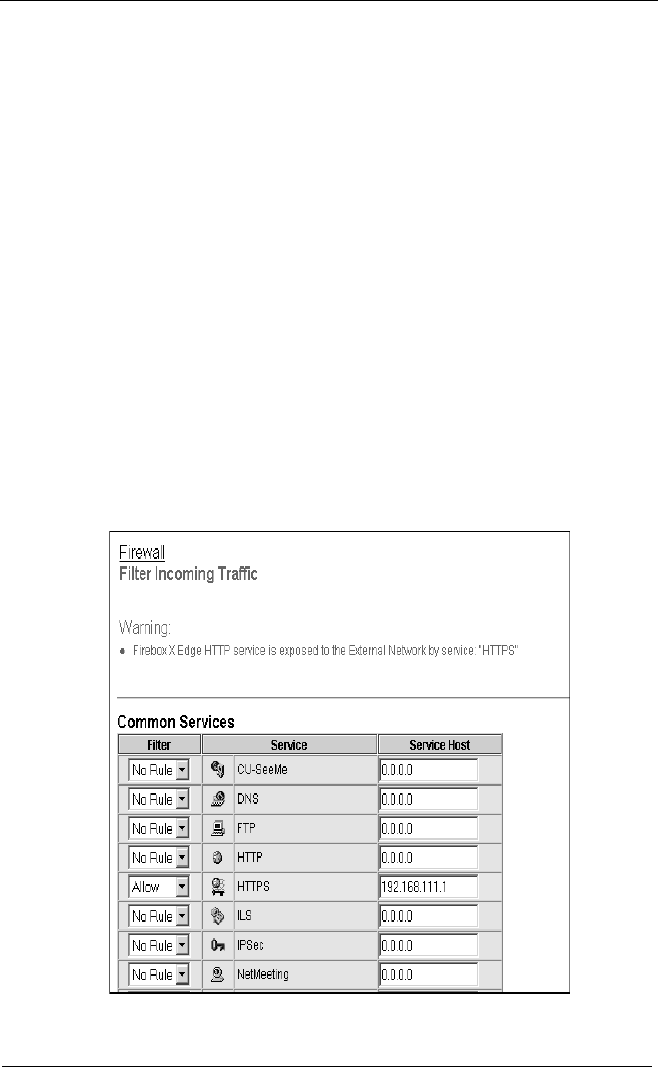
Configuring Firewall Settings
80 WatchGuard Firebox X Edge
server (the internal computer that will receive the requests for Web
pages).
You must be careful when you add policies because when you add a
policy, you open your Edge to more traffic. When you do this, you
increase your risk. Make sure that you compare the value of added
access to the security risk.
When you add a policy, you identify the source and destination IP
addresses, and set the policy properties.
Standard policies
The Firebox X Edge has standard policies you can use to control the
flow of traffic. You can use the procedure below to configure the
properties of a standard policy.
1Type the IP address of the trusted network in your browser
window to connect to the System Status page.
The default IP address is: https://192.168.111.1
2From the navigation bar, select Firewall > Incoming or
Outgoing.
The Filter Traffic page appears.

Configuring Incoming and Outgoing Policies
User Guide 81
3Find a standard policy, such as FTP, Web, or Telnet. From the
drop-down list adjacent to the Policy (Service) name, click Allow
or Deny. Repeat to add more policies.
4For incoming policies, enter the IP address of the service host.
5Click Submit.
Adding a custom policy using the wizard
You can add a custom policy using a TCP port, a UDP port, or a pro-
tocol.
1From the Navigation Bar, click Wizards.
2Next to Define a custom service... click Go.
3Obey the on-screen instructions.
The Traffic Filter Wizard includes the following steps:
Step 1: Welcome
The first screen describes what the wizard does and the
information you need before running it.
Step 2: Basic Filter Definition
On the next screen, you specify basic information such as the
filter name and whether it is appied to incoming or outgoing
traffic.
Step 3: Protocols and Ports
Next, you specify the ports you want to assign to this traffic
filter.
Step 4: Source Hosts
On the next screen, you identify the IP addresses of the source
hosts to which this traffic filter will apply.
Step 5: Destination Hosts
In this step, you identify the IP addresses of the destination hosts
to which this traffic filter will apply.
Optional: Destination “service” host
This step appears if you have configured an incoming service to
allow traffic from the enternal network to pass through to the
trusted network. A local host on the trusted network must be
specified as the destination for all traffic matching this filter. This
host is referred to as a "service host" because it is generally used
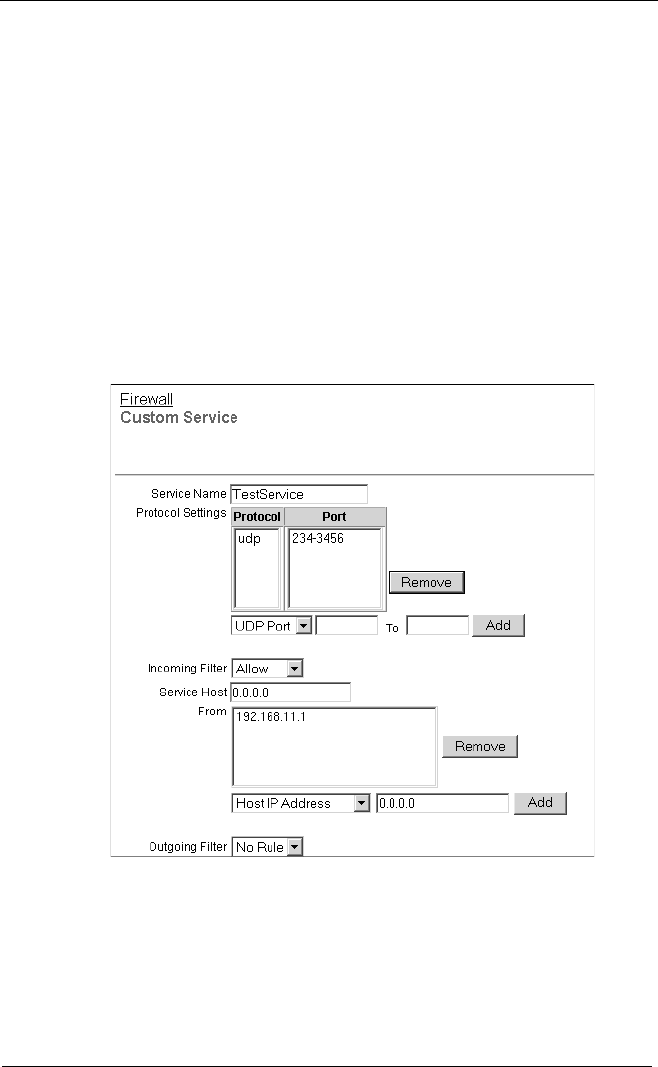
Configuring Firewall Settings
82 WatchGuard Firebox X Edge
to expose a service such as HTTP (a Web server) to the external
network.
Step 6: Summary
The wizard’s last screen displays a summary of the settings you
have made using the wizard.
Adding a custom policy
You can add a custom policy without using the wizard.
1In your Web browser, type the IP address of the trusted interface
to show the System Status page.
The default IP address is: https//192.168.111.1
2On the Filter Traffic page, click Add Service.
The Custom Service page appears.
3In the Service Name text box, type the name for your policy.
4From the Protocol drop-down list, click TCP Port, UDP Port, or
Protocol.

Adding a Policy for the Optional Interface
User Guide 83
5In the text box adjacent to the Protocol drop-down list, type a
port number or protocol number. To use a range of ports, type a
port number in the second text box.
NOTE
If you use an IP protocol, do not type a port number. Some of
the IP protocol numbers you can use include:
6Click Add.
The following steps determine how the service is filtered.
7From the Incoming Filter and Outgoing Filter drop-down lists,
click Allow or Deny.
8From the drop-down list at the bottom of the page, click Host
IP Address, Network IP Address, or Host Range.
9In the address text boxes, type the host or network IP address,
or type the IP addresses that identify range of hosts.
10 Click Add.
Repeat the last three steps until all of the address information for this
custom service is set.
11 Click Submit.
Adding a Policy for the Optional Interface
You can also add policies that monitor and control traffic between
the trusted and optional interfaces:
1In your Web browser, type the IP address of the trusted interface
to show the System Status page of the Firebox X Edge.
The default IP address is: https://192.168.111.1
2From the navigation bar, click Firewall > Optional.
The Filter Outgoing Traffic to Optional Network page appears.
3From the Filter drop-down list, click Allow, Deny or No Rule.
4Click Submit.
Select the Disable traffic filters checkbox to allow all incoming and
outgoing traffic between the trusted and optional interfaces.
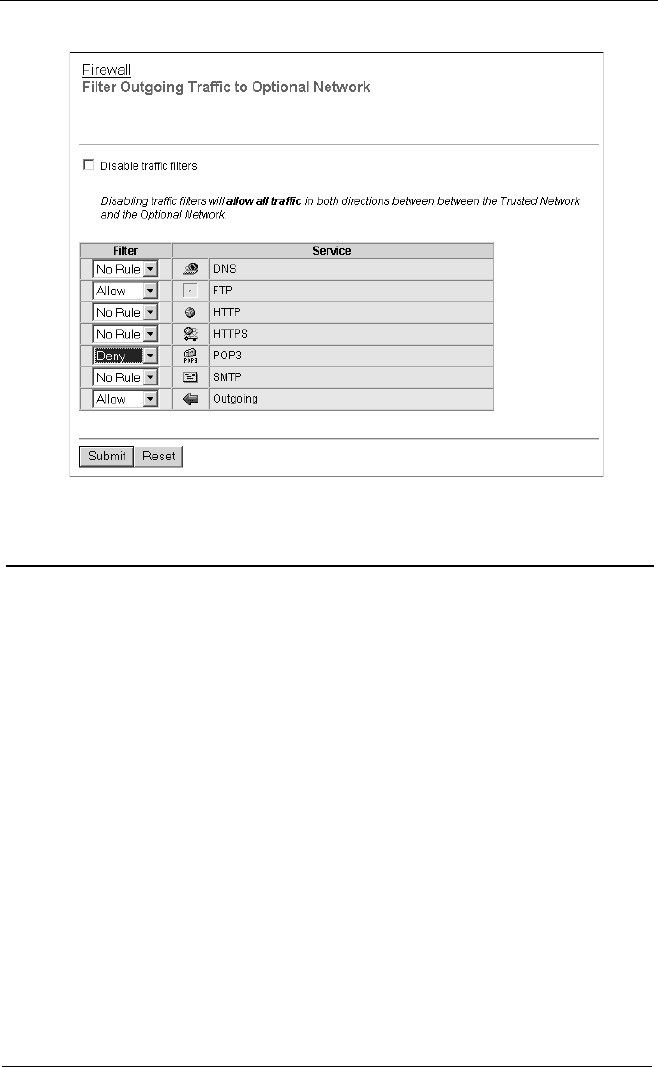
Configuring Firewall Settings
84 WatchGuard Firebox X Edge
Blocking External Sites
The Blocked Sites feature helps prevent unwanted traffic from hos-
tile sites. When you identify a hacker, you can stop all connections
that hacker tries to make. When hackers try to connect to your net-
work, the Edge records data about the hacker. You can examine the
data to identify attacks.
A blocked site is an external IP address that is blocked from con-
necting to computers behind the Edge.
The default configuration of the Firebox X Edge:
• Transmits all packets from the trusted interface to the external
interface
• Does not transmit all packets from the external network to the
trusted network
You can change the configuration to prevent access to specified
Internet locations. To add a location to the Blocked Sites list:
1From the navigation bar, click Firewall > Blocked Sites.
The Blocked Sites page appears.
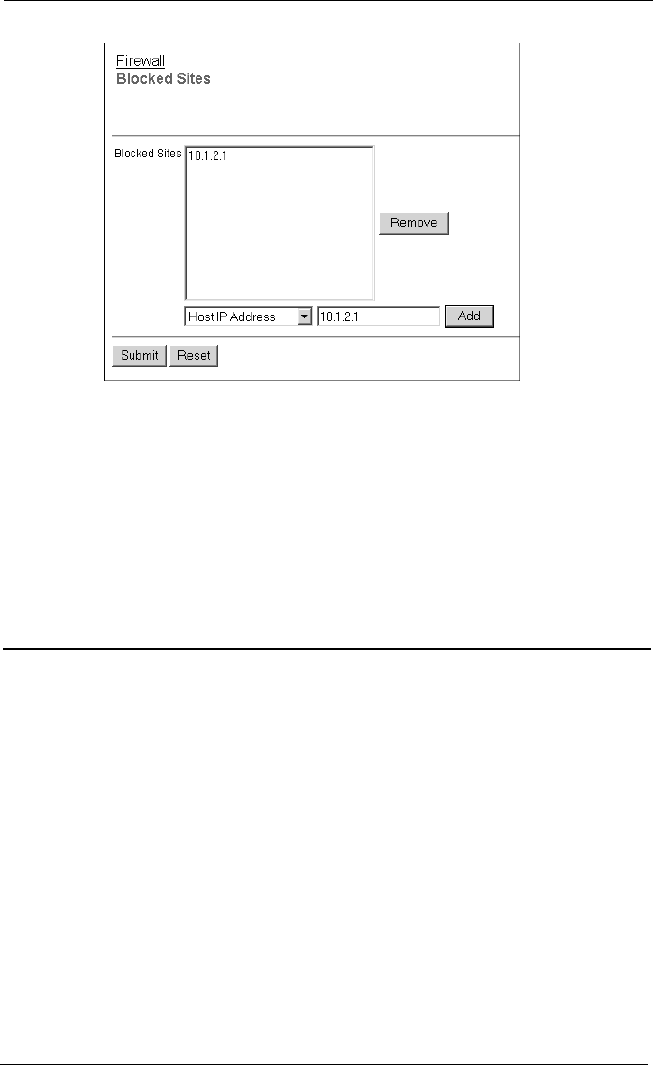
Configuring Firewall Options
User Guide 85
2From the drop-down list, click Host IP Address, Network IP
Address, or Host Range.
3In the text box, type a host IP address, a network IP address, or
a range of host IP addresses.
4Click Add.
The address information appears in the Blocked Sites list.
5Click Submit.
Configuring Firewall Options
The sections before this one tell how to create a policy that allows,
or denies, a specified type of traffic. You use the Firewall Options
page to add non-policy security measures.
1Connect to the System Status page of the Firebox X Edge.
The default IP address is: https://192.168.111.1
2From the navigation bar, click Firewall > Options.
The Firewall Options page appears.
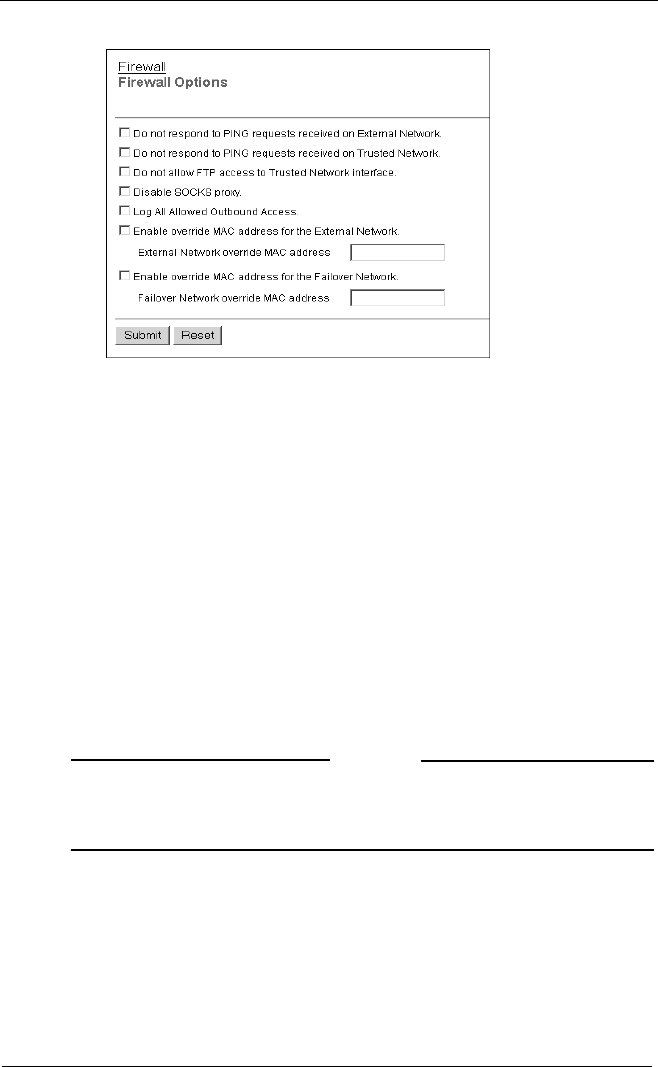
Configuring Firewall Settings
86 WatchGuard Firebox X Edge
Responding to ping requests
You can configure the Firebox X Edge to deny pings.
1Select the Do not respond to PING requests received on
External Network checkbox or the Do not respond to PING
requests received on Trusted Network checkbox.
2Click Submit.
Denying FTP access to the trusted network interface
You can configure the Firebox X Edge to stop FTP traffic from the
trusted interface or external interface.
1Select the Do not allow FTP access to Trusted Network
checkbox.
2Click Submit.
NOTE
You must clear the Do not allow FTP access to Trusted Network
checkbox or the Software Update Installer cannot move firmware
files to the Firebox X Edge.
SOCKS implementation for the Firebox X Edge
The Firebox X Edge can operate as a SOCKS network proxy server.
Software that uses more than one socket connection and uses the
SOCKS version 5 protocol can send traffic through the Edge. SOCKS
gives you secure, two-way communication between a computer on
the external network and a computer on the trusted network. To use

Configuring Firewall Options
User Guide 87
a SOCKS-compatible program, configure the program with the nec-
essary information about the Firebox X Edge.
The Firebox X Edge uses SOCKS version 5. The Firebox X Edge users
do not authenticate before using the Edge configuration pages.
Your Firebox X Edge does not speak with software that finds only
DNS (domain name server) names. Configure the SOCKS-compatible
software to connect to IP addresses and not connect to domain
names.
Software that uses SOCKS and can operate with Firebox X Edge
includes ICQ, IRC, and AOL Messenger.
NOTE
If software that uses SOCKS operates on a computer put on the
trusted network, then all users on the trusted network can use the
SOCKS proxy. To kill this risk, disable the SOCKS proxy on your
Firebox X Edge.
C
onfiguring your SOCKS application
Configure the software using SOCKS on computers put on the
trusted network to speak with a computer on the external network.
When you configure that software, use the recommended properties
from that software documentation.
NOTE
The Firebox X Edge uses port 1080 to speak to computers with
software using SOCKS. Make sure that port 1080 is open and not
used by other software on the computer.
1If you get to identify a version, select SOCKS version 5.
2Select port 1080.
3Set the SOCKS proxy to the URL (uniform resorce locator) or IP
address of the Firebox X Edge. The default IP address is: https://
192.168.111.1.
Disabling SOCKS on the Edge
When the software using SOCKS stops, port 1080 stays open. To kill
this security risk, close the port when the software stops.
1On the Firewall Options page, select the Disable SOCKS proxy
checkbox.
The SOCKS Proxy is disabled.
2Click Submit.

Configuring Firewall Settings
88 WatchGuard Firebox X Edge
To use the SOCKS-compatible application:
1Clear the Disable SOCKS proxy checkbox.
The SOCKS proxy is enabled.
2Click Submit.
Logging all allowed outbound traffic
If you use the standard property settings, the Firebox X Edge records
only unusual events. When traffic is denied, the Edge records the
information in the log file. You can configure the Edge to record
information about all the outgoing traffic in the log file.
NOTE
Recording all outgoing traffic creates a large number of log
records. WatchGuard recommends that you record all the
outgoing traffic only as a problem-solving aid.
To record all outgoing traffic:
1Select the Log All Allowed Outbound Access checkbox.
2Click Submit.
Stop using the current MAC address
Your ISP can register the MAC address of your computer and accept
attempts to connect only from that MAC address. You can change
this property to use the MAC address that connected to the ISP on
this line in the past. The MAC address must obey these conditions:
• The MAC address must use 12 hexadecimal characters
(hhhhhhhhhhhh) with a value between 0 and 9 or between “a”
and “f”.
• The MAC address must operate with:
- One or more addresses on the external network
- The MAC address of the trusted network for the Firebox X Edge
- The MAC address of the optional network for the The Firebox X
Edge
• The MAC address cannot be set to 000000000000
• The MAC address cannot be set to ffffffffffff (0012340ABCDE)

Configuring Firewall Options
User Guide 89
To stop using the current MAC address:
1Select the Enable override MAC address for the External
Network checkbox, or select the Enable override MAC address
for the Failover Network checkbox.
You can select the checkboxes together.
2In the External network override AC address or Failover
network override AC address text box, type the new MAC
address for the Firebox X Edge external or failover network.
3Click Submit.
NOTE
If the MAC address for the external network field is cleared and
the Firebox X Edge is restarted, the Firebox X Edge uses the
standard MAC address for the external network.
To stop MAC address problems, the Firebox X Edge finds the current
MAC address at regular intervals. If the Edge finds a device using the
same MAC address, the Firebox changes to the standard MAC
address for the external network. Then the Edge restarts.
Type the IP address of the trusted network in your browser window
to connect to the System Status page of the Firebox X Edge.

Configuring Firewall Settings
90 WatchGuard Firebox X Edge

User Guide 91
CHAPTER 7 Configuring Logging
A log file is a record of all the events that occur on the Firebox® X
Edge. An
event
is any single activity, such as the denial of a packet
entering the Firebox.
Logging
records and saves information about
these events.
Log records give a list of possible security problems. An event log is an
important part of a network security policy. A sequence of denied
packets can show a pattern of inappropriate network activity.
N
OTE
N
OTE
The Firebox X Edge log is cleared if the power supply is disconnected
or rebooted from the Edge. The information is not cleared if an
external Syslog or WSEP logging host is configured.
Viewing Log Messages
The Firebox X Edge records a maximum of 150 log messages. New
information appears at top of the file. When new information enters a
full message file, it erases the oldest log message.
The log messages include the time synchronizations between the Fire-
box X Edge and the WatchGuard Time Server. Packets are cleared
because of a packet handling violation, duplicate messages, return
error messages, and IPSec messages.
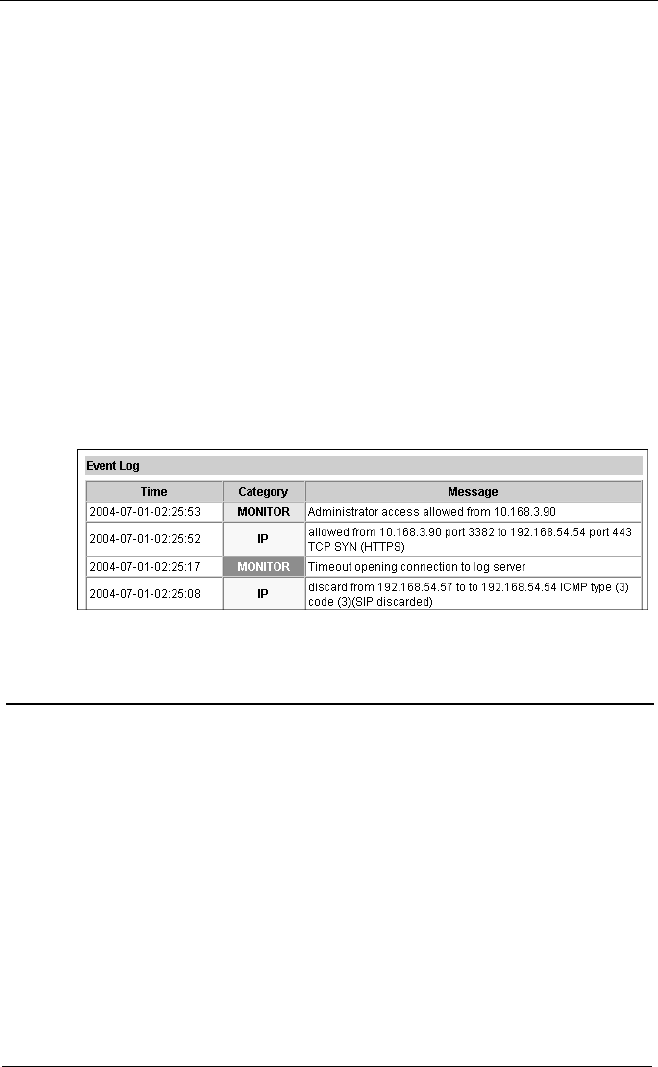
Configuring Logging
92 WatchGuard Firebox X Edge
Each log message contains this information:
Time
The time of the event that created the log message.
Category
The category of the message. For example, whether the message
came from an IP address or from a configuration file.
Message
The text of the message
This procedure shows how to view the event log:
1Type the IP address of the trusted network in your browser
window to connect to the System Status page of the Firebox X
Edge.
The default IP address: https://192.168.111.1
2From the navigation bar, select Logging.
The Logging page appears with the Event Log at the bottom of the page.
Logging to a WatchGuard Security Event
Processor Log Host
The WatchGuard Security Event Processor (WSEP) is a program that
is available with the WatchGuard System Manager. If you have a
Firebox® III or Firebox X, configure the WSEP to accept the log mes-
sages from your Firebox X Edge. For instructions on how to config-
ure the WSEP to accept the log messages, see the
WatchGuard
System Manager User Guide
. Then follow these instructions to send
your event logs to the WSEP.
1Type the IP address of the trusted network in your browser
window.
The default IP address: https://192.168.111.1
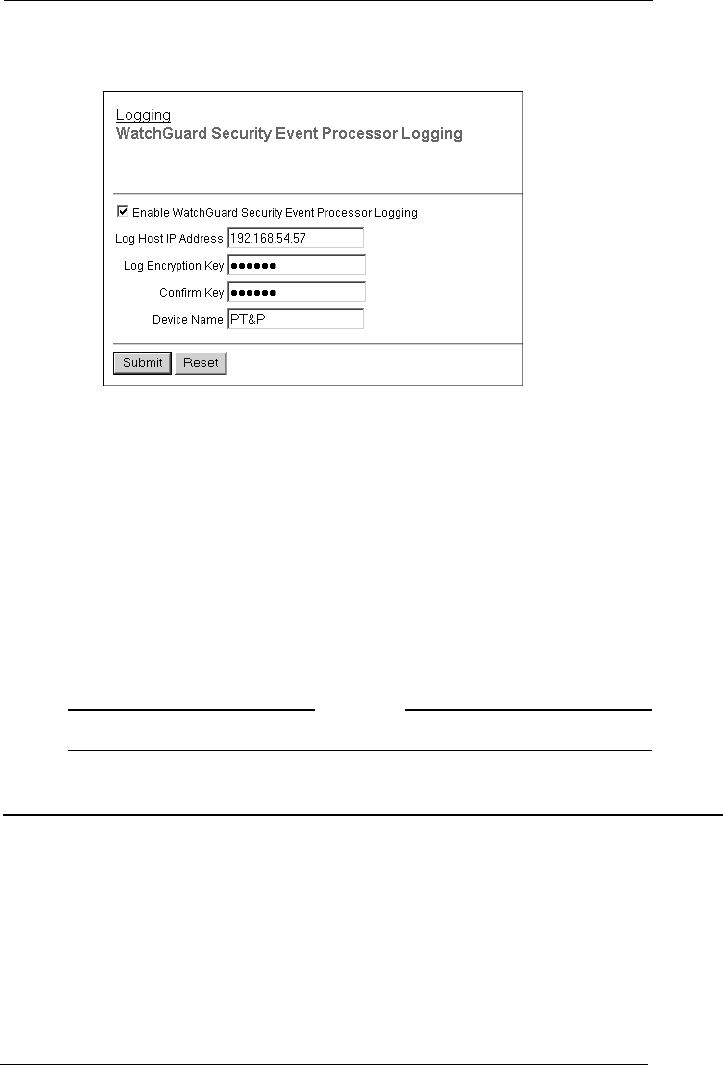
Logging to a Syslog Host
User Guide 93
2From the navigation bar, select Logging > WSEP Logging.
The WatchGuard Security Event Processor Logging page appears.
3The Enable WatchGuard Security Event Processor Logging checkbox
should contain a checkmark. If it does not, select it.
4In the Log Host IP Address field, type the IP address of the WSEP server
that is your log host.
5Type a passphrase in the Log Encryption Key field and confirm the
passphrase in the Confirm Key field.
6In the Device Name field, type a name for the Firebox X Edge.
This identifier lets the WSEP log host distinguish between different devices
logging to it. If this field is empty, the Firebox X Edge is identified to the WSEP log
host by the IP address of the Firebox’s external interface.
7Click Submit.
N
OTE
N
OTE
Use the same log encryption key used by the WSEP application.
Logging to a Syslog Host
Syslog is a logging interface, developed for UNIX also used by a number of
computer systems. This option sends the Firebox® X Edge log messages to a
Syslog host. If you already maintain a Syslog host, set the Edge to send log
messages to that host.
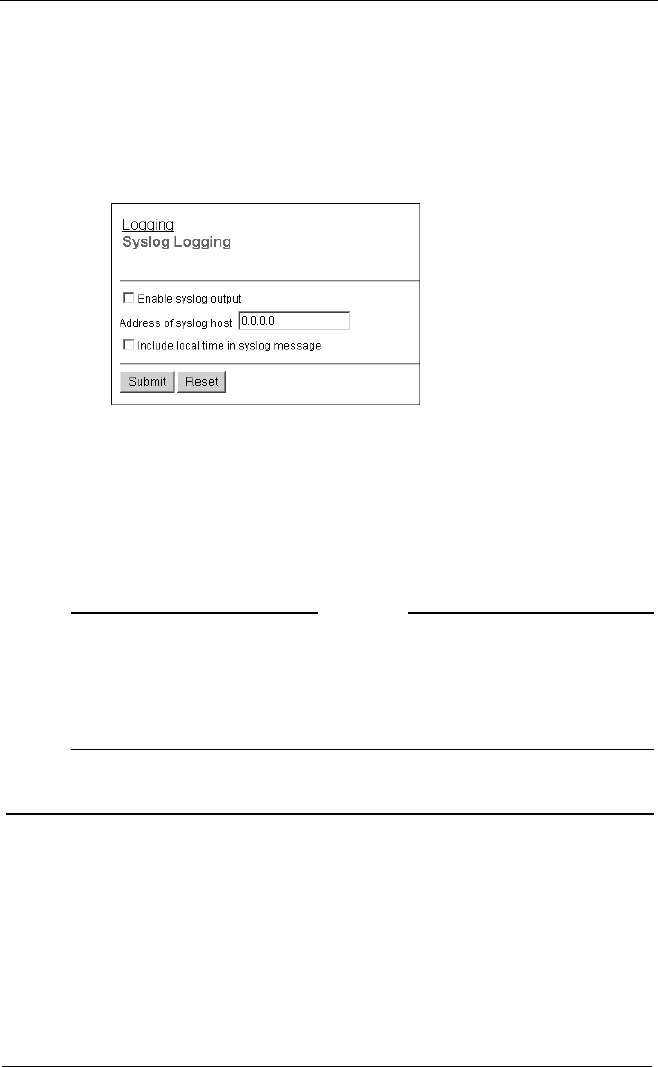
Configuring Logging
94 WatchGuard Firebox X Edge
Configure a Syslog host:
1Type the IP address of the trusted network in your browser
window.
The default IP address: https://192.168.111.1
2From the navigation bar, select Logging > Syslog Logging.
The Syslog Logging page appears.
3Select the Enable Syslog output checkbox.
4Next to Address of Syslog host, type the IP address of the
computer running Syslog.
5(Optional) Select the Include local time in syslog message
checkbox to include the local time in the Syslog messages.
6Click Submit.
N
OTE
N
OTE
Because Syslog traffic is not encrypted, Syslog messages that are
sent through the Internet decrease the security of the trusted
network. Use a VPN tunnel to increase the security of Syslog
message traffic. If the Syslog messages travel through a VPN
tunnel, the data is encrypted with IPSec technology.
Setting the System Time
For each log record, the Firebox® X Edge records the time from its
system clock.
You set the time one of two ways. You synchronize your system
using Network TIme Protocol (NTP) or you can set the date and time
manually.
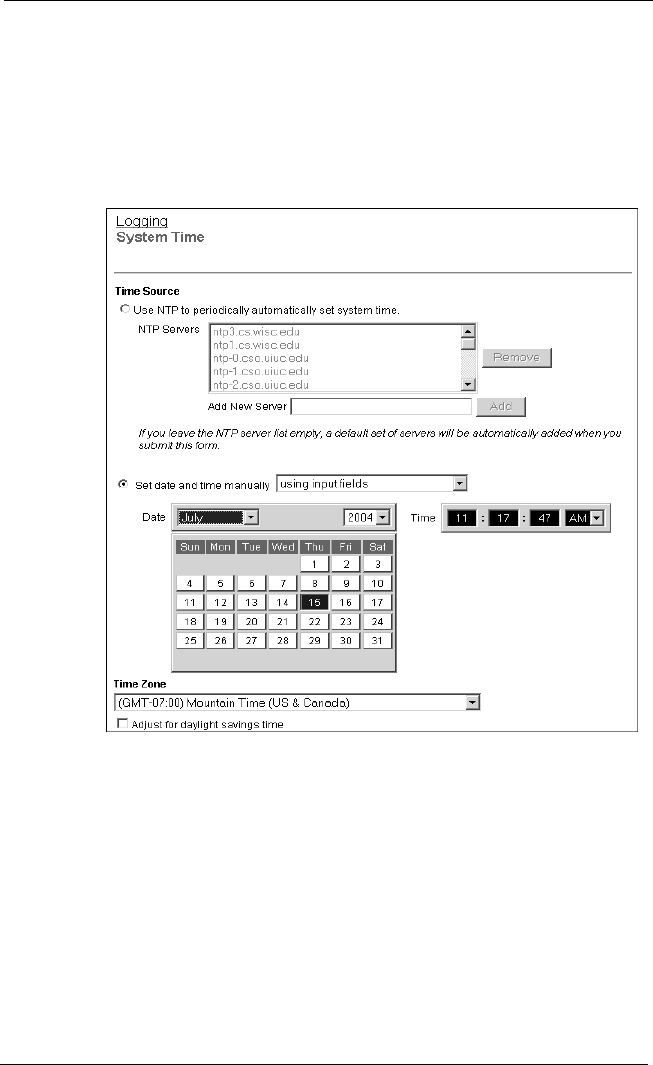
Setting the System Time
User Guide 95
Set the system time:
1Type the IP address of the trusted network in your browser
window.
The default IP address: https://192.168.111.1
2From the navigation bar, select Logging > System Time.
The System Time page appears.
3Select a time zone from the drop-down list.
4(Optional) Select Adjust for daylight savings time.
5Select the method to set system time.
6Click
Submit.

Configuring Logging
96 WatchGuard Firebox X Edge
Setting time using NTP
Network Time Protocol (NTP) synchronizes the clocks of computers
on a network. For more information on NTP, see http://
www.ntp.org.
1From the System Time page, select Use NTP to periodically
automatically set system time.
2Select an NTP server from the list. Or, type the name of a new
server and click Add. You can add a maximum of 16 NTP
servers.
Setting time manually
1From the System Time page, select Set date and time manually.
2From the drop-down list, specify set the date using input fields
or synchonize time with the browser.
3If you chose to set time using input fields, set the date and time
using the calendar and fields provided.
If you chose to set time by synchronizing, click Synchronize
Now when you are ready to synchronize.

User Guide 97
CHAPTER 8 Configuring
WebBlocker
Security is one of the most important reasons to purchase and install a
firewall. The Firebox X Edge, when used with the WebBlocker feature,
is one of the most secure firewalls available.
All companies face web content threats such as:
Productivity
Recreational Web surfing decreases overall productivity.
Legal Concerns
Employees can sue if they do not have a work environment free of
gender and minority harassment. You must take reasonable care to
stop offensive Internet content.
Network Threats
An employee can crash your network by logging into the incorrect
Web site. Other activity such as recreational surfing and
downloading MP3 files divert valuable bandwidth from critical
business needs.
Security
Many viruses enter networks through web-based e-mail accounts
or through other files downloaded from the Web.
WebBlocker is an option for the WatchGuard® Firebox® X Edge that
gives you control over which Web sites are available.

Configuring WebBlocker
98 WatchGuard Firebox X Edge
N
OTE
N
OTE
You must purchase the WebBlocker upgrade to use this feature.
For information on activating upgrade options, see “Activating
Upgrade Options” on page 161.
How WebBlocker Works
WebBlocker uses a database of Web site addresses maintained by
SurfControl®.
When a user on your network tries to open a Web site, the Firebox®
queries the database. If the Web site is not in the WatchGuard Web-
Blocker database or not blocked the page opens. If the site is
blocked a notification appears.
Configuring Global WebBlocker Settings
The first WebBlocker page in the Firebox® X Edge Web pages is the
WebBlocker Settings page. Use this page to:
• Activate WebBlocker
• Set the full access password
• Set the inactivity timeout
• Make sure that your Web users authenticate
To configure WebBlocker:
1Type the IP address of the trusted network in your browser
window.
The default IP address: https://192.168.111.1
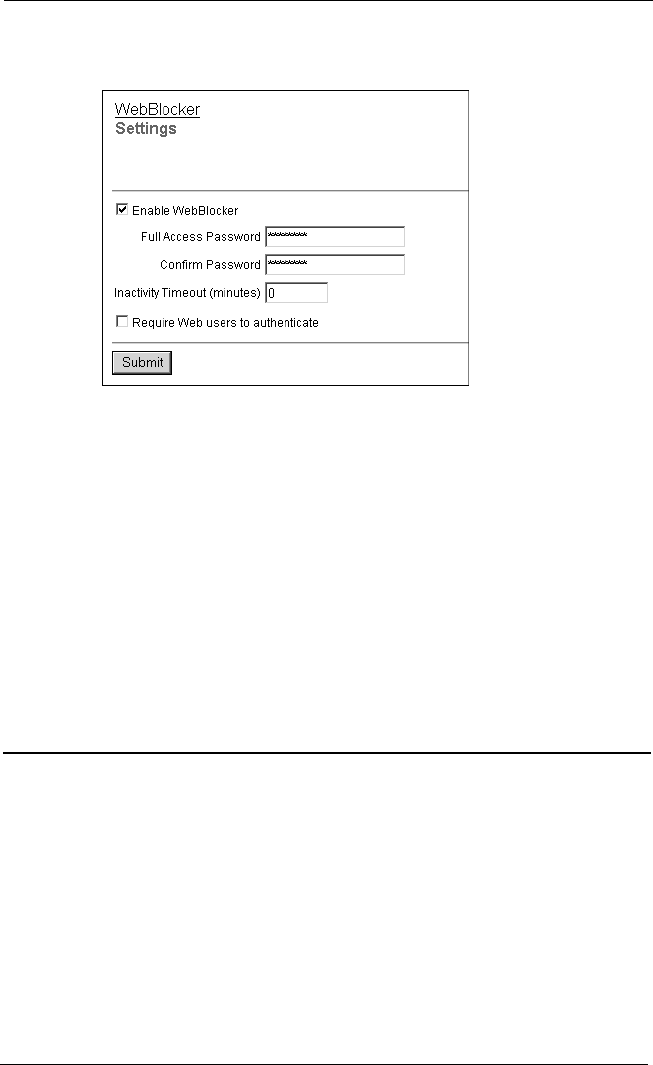
Creating WebBlocker Profiles
User Guide 99
2From the navigation bar, select WebBlocker > Settings.
The WebBlocker Settings page appears.
3Select the Enable WebBlocker check box.
4Type a password in the Full Access Password field.
The full access password gives access all Web sites until the password
expires or the browser is closed.
5Type the same password again in the Confirm Password field.
6Type a number, in minutes, in the Inactivity Timeout field.
The inactivity timeout breaks Internet connections that are inactive for
the set number of minutes.
7To make users authenticate for Internet access, select Require
Web users to authenticate.
8Click Submit.
Creating WebBlocker Profiles
A WebBlocker profile is a set of restrictions you apply to users on
your network. You can create a profile that contains a restriction
that limits use for new employees with less than 90 days tenure.
Then create a less restrictive profile for users when the initial proba-
tionary period is complete.
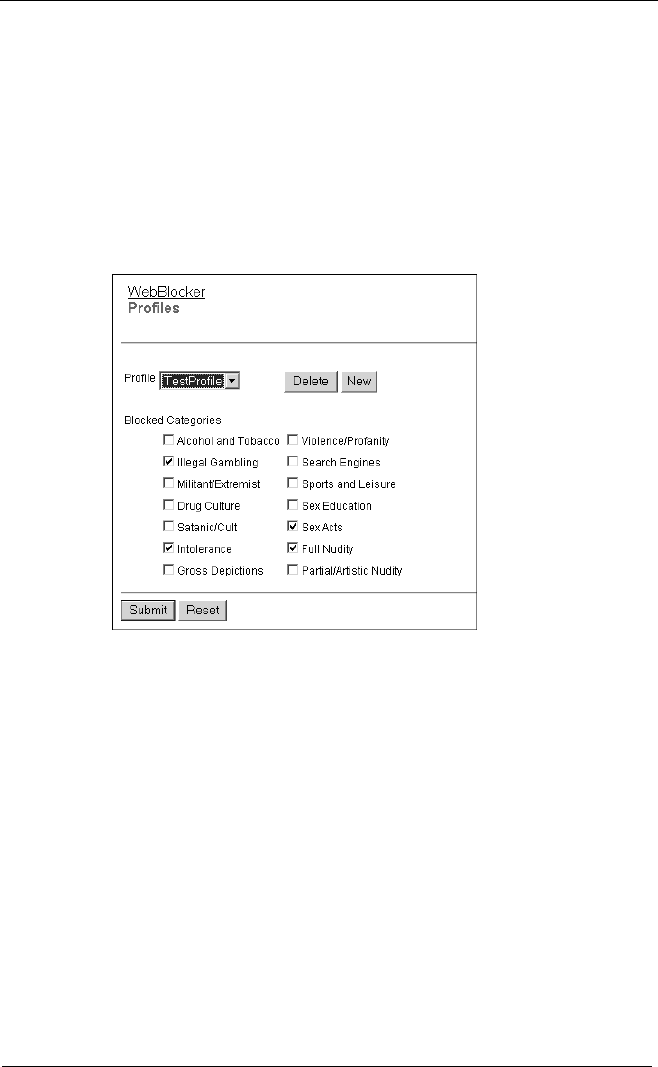
Configuring WebBlocker
100 WatchGuard Firebox X Edge
After you define profiles, you can apply them when you set up
accounts. This procedure appears in Chapter 10, “Managing the
Firebox X Edge.”
1Type the IP address of the trusted network in your browser
window to connect to the System Status page of the Firebox® X
Edge.
The default IP address: https://192.168.111.1
2From the navigation bar, select WebBlocker > Profiles.
The Profiles page appears.
3Click New.
The New Profile page appears.
4In the Profile Name field, type a familiar name.
You use this name to identify the profile during later configuration. For
example, give the name “90day” to an employee at your company for
less than 90 days.
5In Blocked Categories, click the categories of Web sites you do
not want your employees to see.
For more information on categories, see the next section.
6Click Submit.
To delete a profile, from the WebBlocker Profiles page, select the
profile from the Profile drop-down list. Click Delete.

WebBlocker Categories
User Guide 101
WebBlocker Categories
The WebBlocker database contains 14 categories.
A Web site is added to a category when the contents of the Web site
meet the correct criteria. Web sites that give opinion or educational
material about the subject matter of the category are not included.
For example, the drugs/drug culture category denies sites that tell
how to grow and use marijuana. They do not deny sites with infor-
mation about the historical use of marijuana.
The categories:
Alcohol/tobacco
Pictures or text that advocate the sale, consumption or
production of alcoholic beverages and tobacco products.
Illegal Gambling
Pictures or text advocating materials or activities that may be
illegal in any or all jurisdictions. Some examples are illegal
business schemes, chain letters, copyright infringement,
computer hacking, phreaking (using phone lines without
permission), and piracy. Also includes text advocating gambling
relating to lotteries, casinos, betting, numbers games, online
sports or financial betting, including non-monetary dares.
Militant/extremist
Pictures or text advocating extremely aggressive or combative
behavior or advocacy of unlawful political measures. Topic
includes groups that advocate violence as a means to achieve
their goals. It also includes pages devoted to “how to”
information on the making of weapons (for both lawful and
unlawful reasons), ammunition, and pyrotechnics.
Drug Culture
Pictures or text advocating the illegal use of drugs for
entertainment. This category includes substances that are used
for other than their primary purpose to alter the individual’s
state of mind. This does not include currently illegal drugs
legally prescribed for medicinal purposes (such as drugs used to
treat glaucoma or cancer).

Configuring WebBlocker
102 WatchGuard Firebox X Edge
Satanic/cult
Pictures or text advocating devil worship, an affinity for evil,
wickedness, or the advocacy to join a cult. A cult is a closed
society that is headed by an individual, loyalty is demanded and
leaving is forbidden.
Intolerance
Pictures or text advocating prejudice or discrimination against
any race, color, national origin, religion, disability or handicap,
gender, or sexual orientation. Any picture or text that elevates
one group over another. Also includes intolerant jokes or slurs.
Gross Depictions
Pictures or text describing anyone or anything that is either
crudely vulgar, grossly deficient in civility or behavior, or shows
scatological impropriety. Topic includes depictions of maiming,
bloody figures, and indecent depiction of bodily functions.
Violence/profanity
Pictures or text exposing extreme cruelty or profanity. Cruelty is
physical or emotional acts against any animal or person that are
primarily intended to hurt or inflict pain. This includes obscene
words, phrases, and profanity in audio, text, or pictures.
Search Engines
Search engine sites such as Google.
Sports and Leisure
Pictures or text describing sporting events, sports figures or other
entertainment activities.
Sex Education
Pictures or text advocating the proper use of contraceptives.
Topic includes sites devoted to the explanation and description
of condoms, oral contraceptives, intrauterine appliances, and
other types of contraceptives. It also includes discussion sites
devoted to conversations with partners about sexually
transmitted diseases, pregnancy, and sexual boundaries. Not
included in this category are commercial sites selling sexual
paraphernalia (topics included under
Sexual Acts
).
Sexual Acts
Pictures or text exposing anyone or anything involved in explicit
sexual acts and/or lewd and lascivious behavior. Topic includes

Allowing Certain Sites to Bypass WebBlocker
User Guide 103
masturbation, copulation, pedophilia, as well as intimacy
involving nude or partially nude people in heterosexual, bisexual,
lesbian, or homosexual encounters. It also includes phone sex
advertisements, dating services, adult personals, and sites
devoted to selling pornographic CD-ROMs and videos.
Full Nudity
Pictures exposing any or all portions of human genitalia. Topic
does
not
include sites categorized as Partial/Artistic Nudity
containing partial nudity of a wholesome nature. It does not
include Web sites for publications such as
National Geographic
or
Smithsoni
a
n
magazine or sites hosted by museums such as the
Guggenheim, the Louvre or the Museum of Modern Art.
Partial/artistic Nudity
Pictures exposing the female breast or full exposure of either
male or female buttocks except when exposing genitalia that is
handled in the Full Nudity category. Topic does not include
swimsuits, including thongs.
For information on how to see whether specific sites are included in
the SurfControl database, and for more information on WebBlocker
categories, see
https://www.watchguard.com/support/AdvancedFaqs/web_main.asp
- How can I see a list of blocked sites?
- How do different sites map into WebBlocker’s 14 categories?
Allowing Certain Sites to Bypass WebBlocker
Some si
tes are useful even when they are denied by WebBlocker.
You can allow these sites regardless of other WebBlocker settings.
For example, employees in your company might need to see Web
sites that contain medical information. Some of these sites are for-
bidden by WebBlocker because they fall into the category of sex
education. You override the WebBlocker setting by adding the site
to the Allowed Sites list.
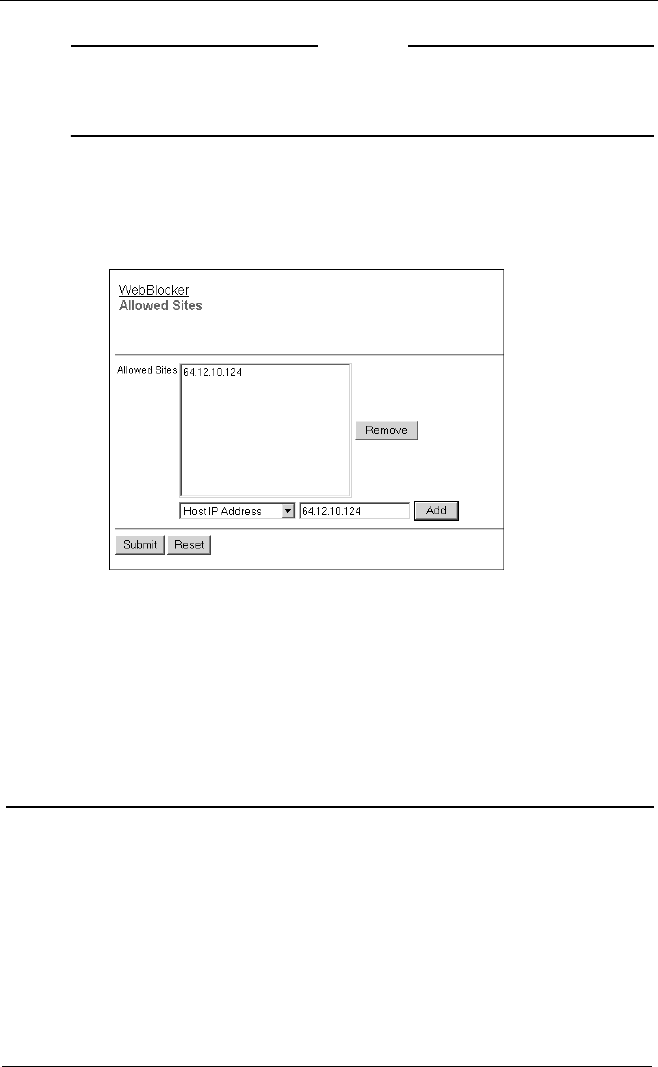
Configuring WebBlocker
104 WatchGuard Firebox X Edge
N
OTE
N
OTE
This WebBlocker feature is applicable only for outbound Web
accesss. You cannot use WebBlocker exceptions to not include an
internal host in WebBlocker rules.
1From the navigation bar, select WebBlocker > Allowed Sites.
The WebBlocker Allowed Sites page appears.
2From the drop-down list, specify a host IP address, network IP
address or host range.
3Type the host or network IP address of the allowed site. If it is a
range, type the start and end point of the range. Click Add.
4Do step 3 again for other allowed sites. When have no more
sites to add, click Submit.
To remove an item from the list, select the address. Click Remove.
Blocking Additional Web Sites
You might not want your users to see certain sites even if Web-
Blocker allows them. For example, you may receive a LiveSecurity®
Service alert warning that a certain commonly used Web site is dan-
gerous. Using the Denied Sites feature to make sure your employees
do not look at this site.
1From the navigation bar, select WebBlocker > Denied Sites.
The WebBlocker Denied Sites page appears.
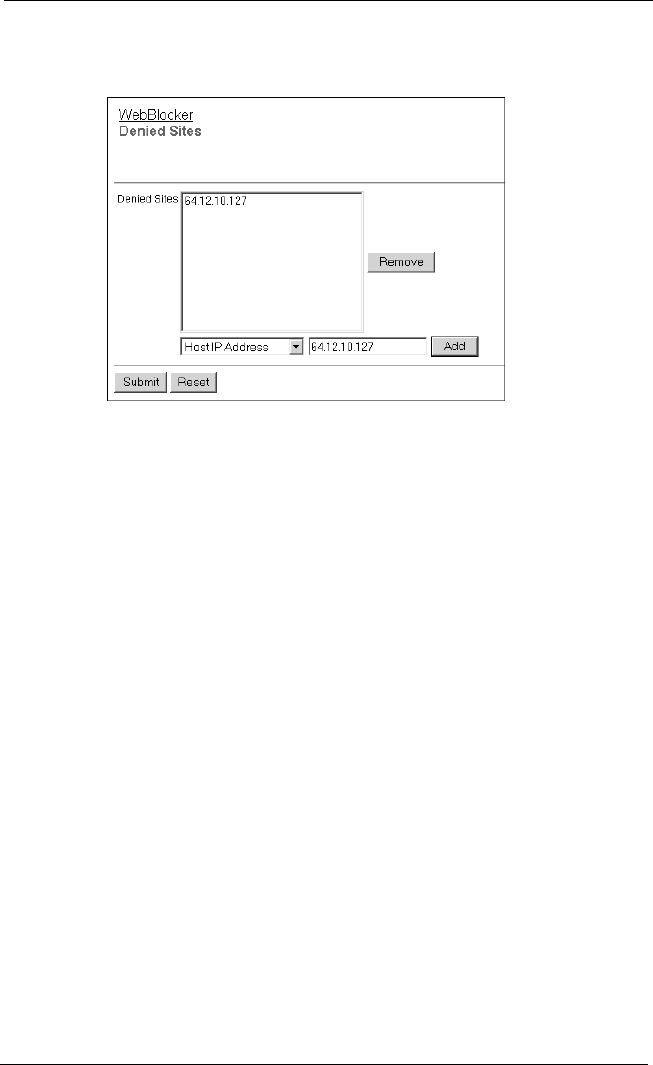
Blocking Additional Web Sites
User Guide 105
2From the drop-down list, specify a host IP address, network IP
address or host range.
3Type the host or network IP address of the denied site. If it is a
range, type the start and end point of the range. Click Add.
4Do step 3 for other denied sites. When you have no more sites
to add, click Submit.
To subtract an item from the list, select the address. Click Remove.
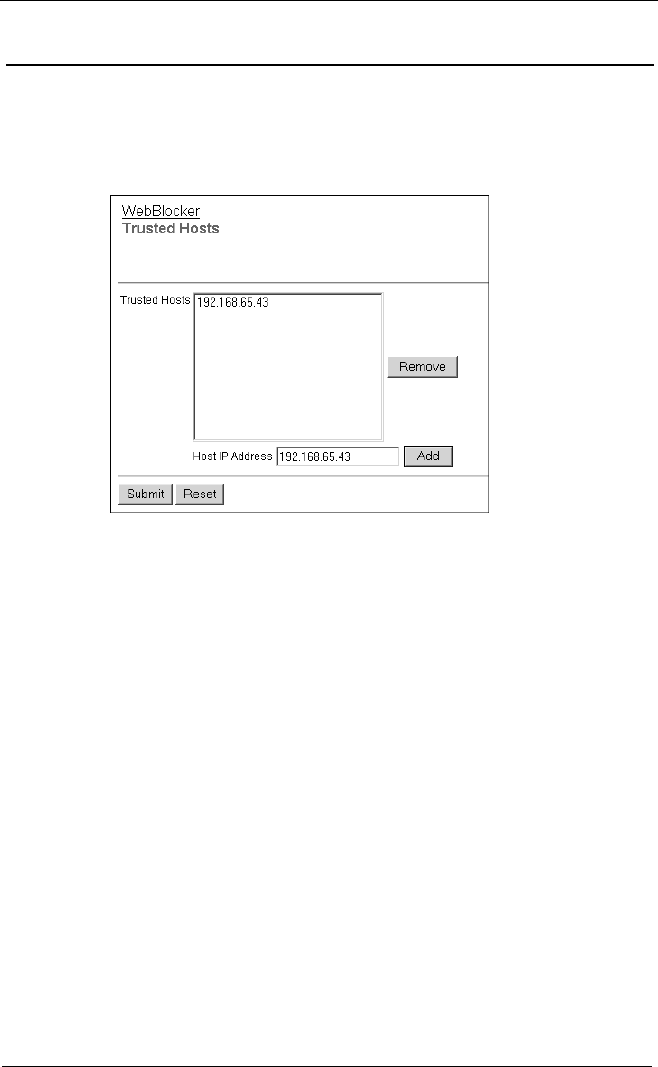
Configuring WebBlocker
106 WatchGuard Firebox X Edge
Allowing Internal Hosts to Bypass WebBlocker
You can make a list of internal hosts that bypass WebBlocker set-
tings:
1From the navigation bar, select WebBlocker > Trusted Hosts.
The WebBlocker Trusted Hosts page appears.
2In the text box at the bottom of the page, type the host IP
address of the site to allow. Click Add.
3Do step 3 again for other allowed hosts. When you have no
more hosts to add, click Submit.
To subtract an item from the list, select the address. Click Remove.

User Guide 107
CHAPTER 9 Configuring Virtual
Private Networks
You use a virtual private networ
k
(VPN) to create secure connections
between computers or networks in different locations. The networks
and hosts on a VPN can be corporate headquarters, branch offices,
remote users, and telecommuters. VPN tunnels are secured, and the
identity of the sender and the receiver are authenticated. Data on the
tunnel is encrypted. Only the sender and the receiver of the message
can read it.
What You Need to Create a VPN
• Two Firebox X Edge devices or one Firebox X Edge and a second
device that uses IPSec standards. An example of such a device is a
Firebox X. You must enable the VPN option on each device.
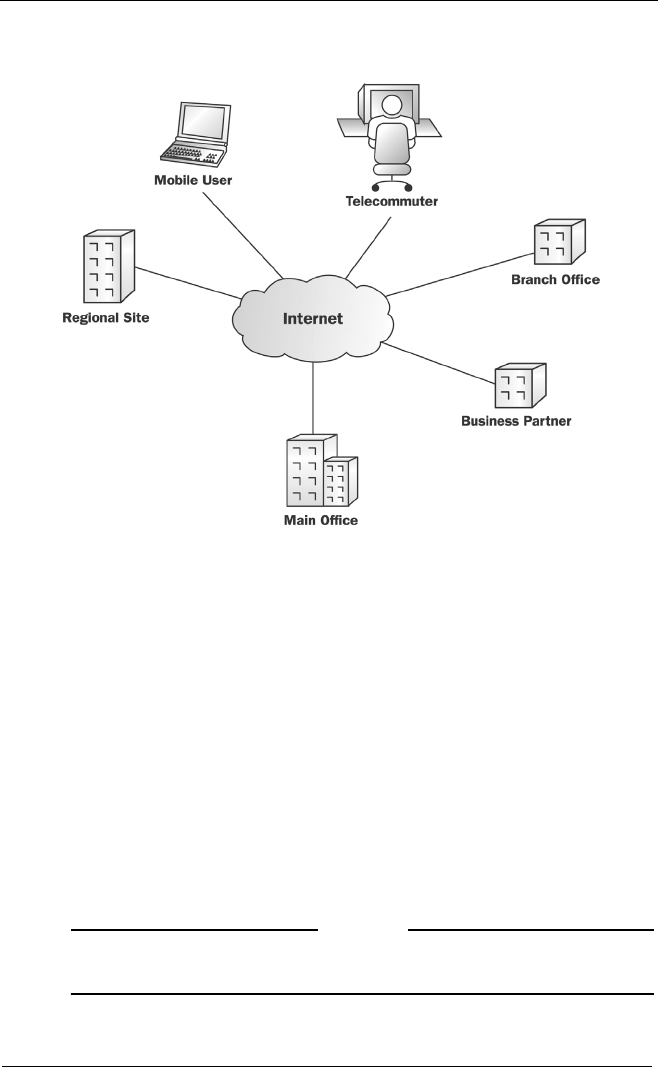
Configuring Virtual Private Networks
108 WatchGuard Firebox X Edge
• The static IP address of each Firebox X Edge external interface.
• The network address of the private (trusted) network located
behind each Firebox X Edge (the networks that will
communicate through the), and their subnet masks. The base
trusted IP address of each Firebox X Edge must be static and
unique.
• The DNS and WINS server IP addresses, if used.
• The shared key (passphrase) for the tunnel. The same shared key
must be used by both devices.
• The same encryption method for each end of the tunnel (DES or
3DES).
• The same authentication method for each end of the tunnel
(MD5 or SHA1).
N
OTE
N
OTE
The trusted networks at each end of the VPN tunnel must have
different network addresses..

What You Need to Create a VPN
User Guide 109
VPN requirements
Before you configure your WatchGuard Firebox X Edge VPN net-
work:
• You can connect a maximum of 10 Firebox X Edge devices
together in a star configuration. To configure more VPN
tunnels, a WatchGuard Firebox III or Firebox X and WatchGuard
VPN Manager is necessary.
• WatchGuard recommends that each VPN device has a static IP
address. Configuring a VPN tunnel between devices that use
dynamic IP addresses can cause problems. See “Network
addressing” on page 5 for more information about dynamic IP
addresses. Dynamic IP address problems can be resolved with
Dynamic DNS. For Dynamic DNS configuration information,
see “Registering with the Dynamic DNS Service” on page 62.
• VPN devices must use the same encryption method, DES or
3DES.
• If you connect two Microsoft Windows NT networks, they must
be in the same Microsoft Windows domain, or they must be
trusted domains. This is a Microsoft Networking issue, and not a
limitation of the Firebox X Edge.
We recommend that you record your Firebox X Edge configuration.
Use the Sample VPN Address Information table on the next page to
write down this information.

Configuring Virtual Private Networks
110 WatchGuard Firebox X Edge
Sample
VPN Address Information Table
Item Description Assigned
By
External IP
Address
The IP address that identifies the IPSec-
compatible device on the Internet.
ISP
Site A: 207.168.55.2
Site B: 68.130.44.15
External
Subnet Mask
The bitmask that shows which part of the IP
address identifies the local network. For
example, a class C address includes 256
addresses and has a netmask of
255.255.255.0.(Only 254 of the IP addresses in
that subnet can be assigned to computers.)
ISP
Site A: 255.255.255.0
Site B: 255.255.255.0
Local Network
Address
An address used to identify a local network. A
local network address cannot be used as an
external IP address. WatchGuard recommends
that you use an address from one of the
reserved ranges:
10.0.0.0/8—255.0.0.0
172.16.0.0/12—255.240.0.0
192.168.0.0/16—255.255.0.0
The numbers after the slashes indicate the
subnet masks. /24 means that the subnet mask
for the trusted network is 255.255.255.0. For
more information on entering IP addresses in
slash notation, see the FAQ:
https://www.watchguard.com/support/
advancedfaqs/general_slash.asp
You
Site A: 192.168.111.0/24
Site B: 192.168.222.0/24
Shared Secret The shared secret is a passphrase used by two
IPSec-compatible devices to encrypt and decrypt
the data that goes through the VPN tunnel. The
two devices use the same passphrase. If the
devices do not have the same passphrase, they
cannot encrypt and decrypt the data correctly.
Use a passphrase that contains numbers,
symbols, lowercase letters, and uppercase
letters for better security. For example,
“Gu4c4mo!3” is better than “guacamole”.
You
Site A: OurSharedSecret
Site B: OurSharedSecret

Using a DVCP server to create your VPN tunnels
User Guide 111
Using a DVCP server to create your VPN tunnels
Dynamic VPN Configuration Protocol (DVCP) is the WatchGuard
protocol that creates IPSec tunnels. The VPN tunnel configurations
are saved on the DVCP server. This decreases the work for the
administrator.
You can only use a Firebox III or Firebox X model as a DVCP server.
You can easily create tunnels on the Firebox X Edge by configuring
it as a DVCP client.
There are two kinds of DVCP servers:
• Basic DVCP - All Firebox III and Firebox X models
• VPN Manager - Firebox III 1000 or above, Firebox X700 or
above
For more information, see the FAQ:
https://www.watchguard.com/support/advancedFAQs/
basicdvcp_whatis.asp
Setting up management for a dynamic Edge device
Use this procedure for a Firebox X Edge device with a dynamic IP
address for the external interface.
1Type the IP address of the trusted network in your browser
window to connect to the System Status page of the Firebox X
Edge.
The default IP address is: https://192.168.111.1.
Item Description Assigned
By
Encryption
Method
DES uses 56-bit encryption. 3DES uses 168-bit
encryption. The 3DES encryption method is more
secure, but slower. The two devices must use
the same encryption method.
You
Site A: 3DES
Site B: 3DES
Authentication The two devices must use the same
authentication method.
You
Site A: MD5 (or SHA1)
Site B: MD5 (or SHA1)
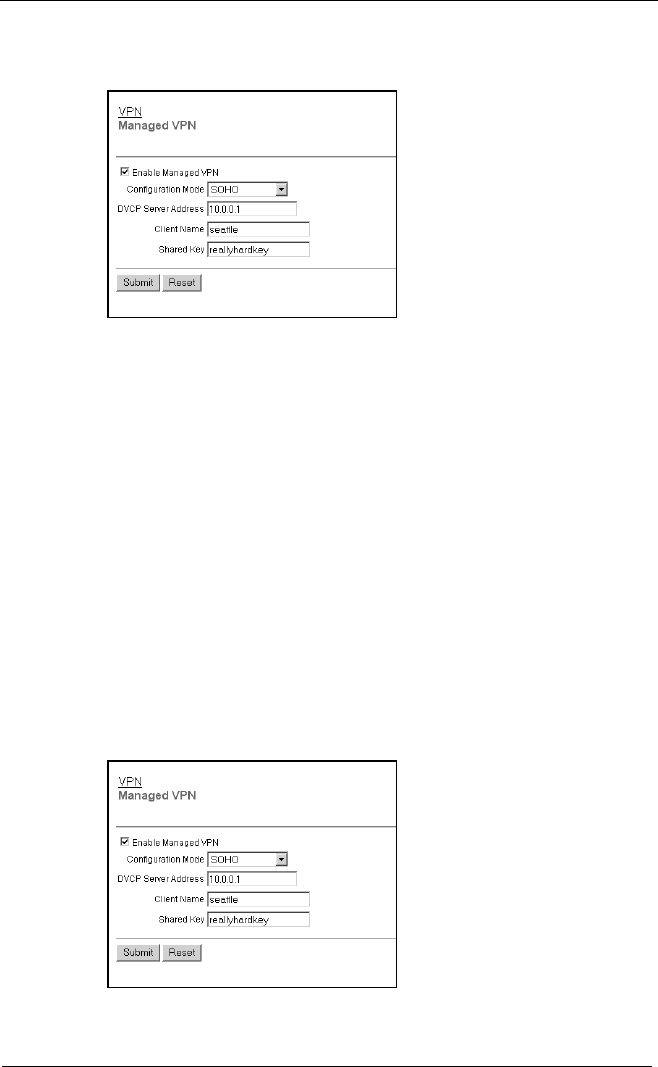
Configuring Virtual Private Networks
112 WatchGuard Firebox X Edge
2From the navigation bar, select VPN > Managed VPN.
The Managed VPN page appears.
3Select the Enable Managed VPN checkbox.
4Type the IP address of the DVCP server.
5Type the client name and the shared key. If you have a Basic
DVCP server, use the client name. If you have a VPN Manager
DVCP server, use the host name.
6Click Submit.
Setting up management for a static Edge device
If you use a Basic DVCP server and the Firebox X Edge has a static IP
address, use this procedure:
1Type the IP address of the trusted network in your browser
window to connect to the System Status page of the Firebox X
Edge.
The default IP address is: https://192.168.111.1.
2From the navigation bar, select VPN > Managed VPN.
The Managed VPN page appears.
3Select the Enable Managed VPN checkbox.

Setting Up Manual VPN Tunnels
User Guide 113
4Type the IP address of the DVCP server.
5Type the client name and the shared key. Use the Client Name
you entered on the Basic DVCP server.
6Click Submit.
Setting Up Manual VPN Tunnels
You can configure a maximum of 10 tunnels from the Firebox X
Edge to other Firebox X Edge devices. The VPN Manager software
can configure a larger number of Firebox X Edge to Firebox X Edge
tunnels.
To define VPN tunnels to other Firebox X Edge devices:
1Type the IP address of the trusted network in your browser
window to connect to the System Status page of the Firebox X
Edge.
The default IP address is: https://192.168.111.1.
2From the navigation bar, select VPN > Manual VPN.
The Manual VPN page appears.
3Click Add.
The Add Gateway page appears.
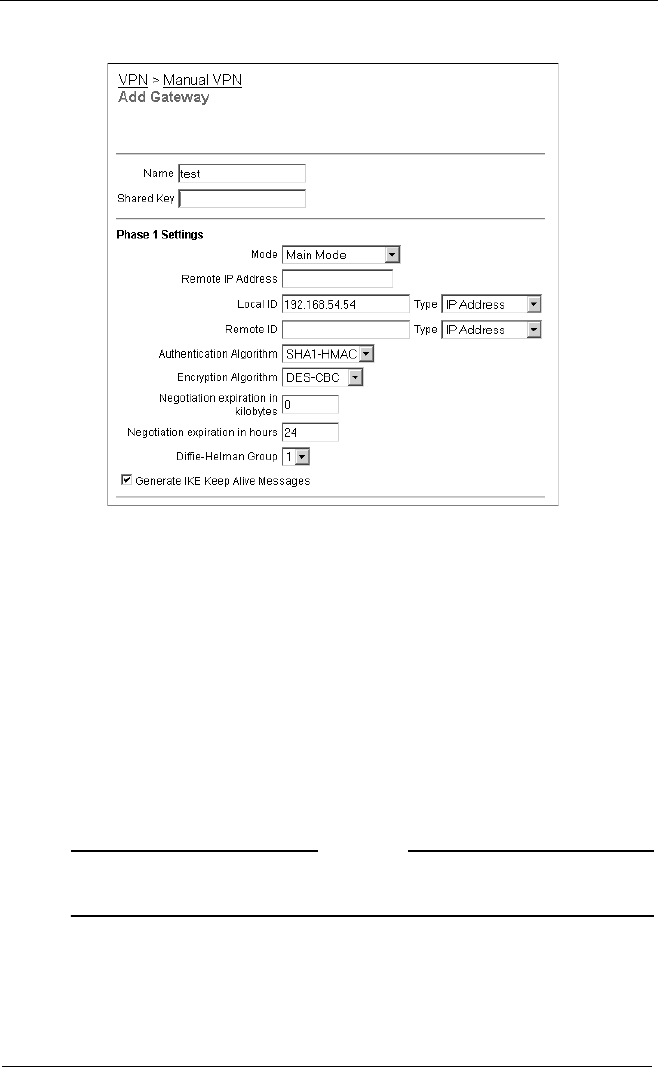
Configuring Virtual Private Networks
114 WatchGuard Firebox X Edge
4Type the Name and Shared Key for the VPN tunnel.
The shared key is a passphrase that the devices use to encrypt and
decrypt the data on the VPN tunnel. The two devices use the same
passphrase. If the devices do not have the same passphrase, they cannot
encrypt and decrypt the data correctly.
Phase 1 settings
Internet Key Exchange (IKE) is a protocol used with VPNs to manage
keys automatically. IKE negotiates keys and changes keys. Phase 1
authenticates the parties and creates a key management security
association to protect tunnel data.
The default settings for Phase 1 are the same for all Firebox X
devices. Many users keep these settings in their default values.
N
OTE
N
OTE
Make sure that the Phase 1 configuration is the same on both
devices.

Setting Up Manual VPN Tunnels
User Guide 115
To change Phase 1 configuration:
1Select the negotiation mode for Phase 1 from the drop-down
list.
You can use main mode only when both devices have static IP addresses.
If one VPN or both devices have IP addresses that are dynamically
assigned, you must use aggressive mode.
2Enter the local ID and remote ID. Select the ID types—IP
Address or Domain Name—from the drop-down lists. Make sure
this configuration is the same as the configuration on the
remote device.
-If you select Main Mode and the remote ID type is IP Address,
this must be the remote gateway’s IP address.
-If you select Aggressive Mode and the remote gateway is
static, set the remote ID type to IP Address. If the local
gateway is static, set the local ID type to IP Address.
If the remote gateway is dynamic, set the local ID type to
Domain Name. If the remote gateway is dynamic and uses
dynamic DNS, set the remote ID type to Domain Name and the
remote ID to the DNS name.
3Select the type of authentication from the Authentication
Algorithm drop-down list.
The options are MD5-HMAC (128-bit authentication) or SHA1-HMAC
(160-bit authentication).
4From the Encryption Algorithm drop-down list, select the type
of encryption.
The options are DES-CBC or 3DES-CBC.
5Type the number of kilobytes and the number of hours until the
IKE negotiation expires.
6Select the group numbr from the Diffie-Hellman Group drop-
down list. WatchGuard supports group 1 and group 2.
Diffie-Hellman groups securely negotiate secret keys through a public
network. Group 2 is more secure than group 1, but requires more
processing power and more time.
7Select the Generate IKE Keep Alive Messages checkbox to help
detect when the tunnel is down.
Select this checkbox to send short packets across the tunnel at regular
intervals. This helps the two devices to determine that the tunnel still
works securely. If the Keep Alive packets get no response after three
attempts, the Firebox X Edge does a rekey to start the tunnel again.

Configuring Virtual Private Networks
116 WatchGuard Firebox X Edge
N
OTE
N
OTE
The IKE Keep Alive feature is different from the VPN Keep Alive
feature described in“VPN Keep Alive,” on page 117.
Phase 2 settings
Phase 2 negotiates the data management security association for
the tunnel. The tunnel uses this phase to create IPSec tunnels
and encapsulate and decapsulate data packets.
You can use the default Phase 2 settings to simplify configuration.
N
OTE
N
OTE
Make sure that the Phase 2 configuration is the same on both
devices.
To change the Phase 2 settings:
1Select the authentication method from the Authentication
Algorithm drop-down list.
2Select the encryption algorithm from the Encryption Algorithm
drop-down list.
3If you are using Perfect Forward Secrecy, select the Enable
Perfect Forward Secrecy checkbox.
This option makes sure that each new key is derived from a new Diffie-
Hellman exchange. This option makes the negotiation more secure, but
requires more time.
4Type the number of kilobytes and the number of hours until the
IKE negotiation expires.
5Type the IP address of the local network and the remote
network that must use Phase 2 negotiation.
Network addresses must be entered in “slash” notation (also known as
Classless Inter Domain Routing or CIDR notation). For more information
on entering IP addresses in slash notation, see the following FAQ: http:/
/www.watchguard.com/support/advancedfaqs/general_slash.asp.
6Click Add.
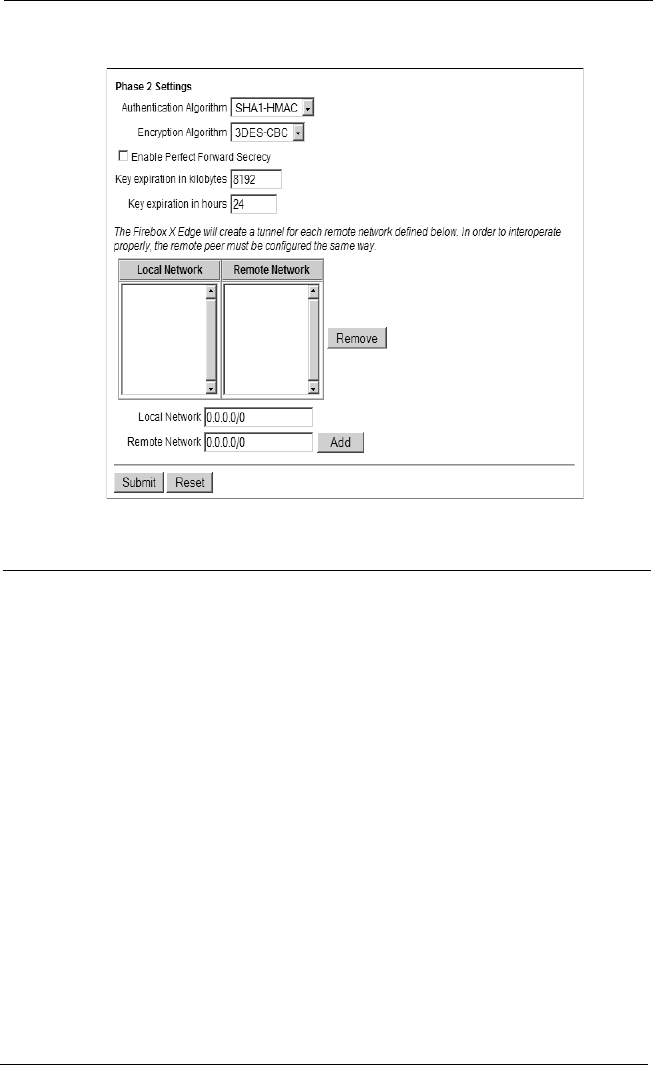
VPN Keep Alive
User Guide 117
7Click Submit.
VPN Keep Alive
To keep the VPN tunnel open when there is no communication
across it, you can use the IP address of a computer at the other end
of the tunnel. The Firebox® X Edge will send a ping once a minute
to the specified host. Use the IP address of a host that is always up,
and that responds to ping messages. You can enter the trusted
interface IP address of the Firebox X Edge, or the trusted interface IP
address of a Firebox III or Firebox X that is at the other end of the
tunnel. You can use multiple IP addresses so the Firebox X Edge can
ping multiple hosts across different tunnels.
1Type the IP address of the trusted network in your browser
window to connect to the System Status page of the Firebox X
Edge.
The default IP address is: https://192.168.111.1
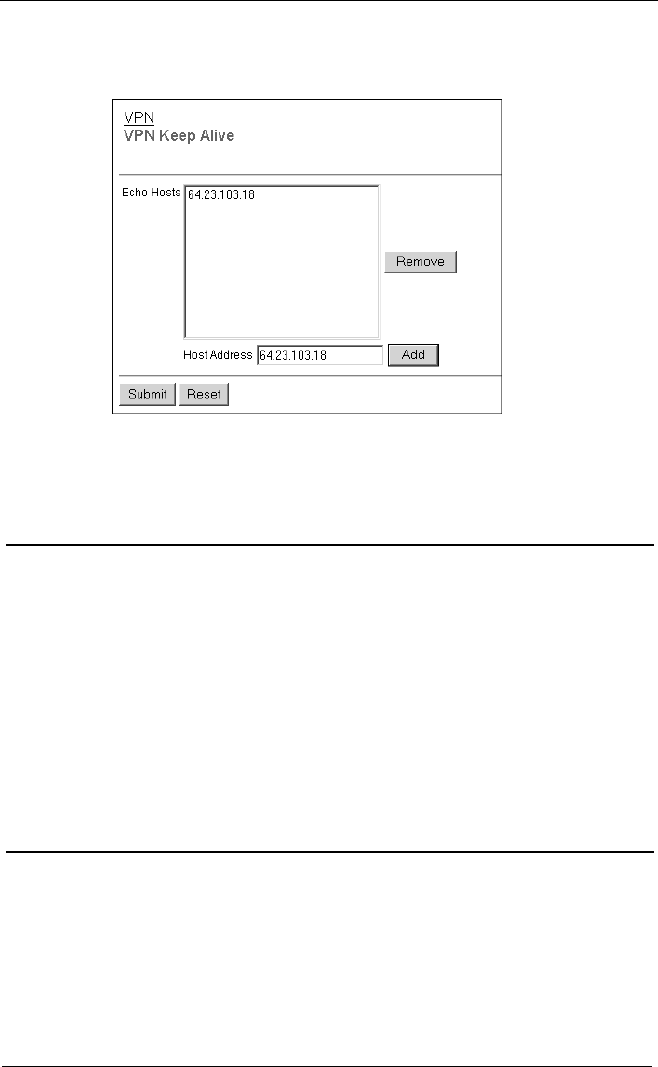
Configuring Virtual Private Networks
118 WatchGuard Firebox X Edge
2From the navigation bar, select VPN > Keep Alive.
The VPN Keep Alive page appears.
3Type the IP address of an echo host. Click Add.
4Click Submit.
Viewing VPN Statistics
You can monitor VPN traffic and troubleshoot the VPN configura-
tion. with the VPN Statistics page.
To view the VPN Statistics page:
1Type the IP address of the trusted network in your browser
window to connect to the System Status page of the Firebox X
Edge.
The default IP address is: https://192.168.111.1
2From the navigation bar, select VPN > VPN Statistics.
The VPN Statistics page appears.
Frequently Asked Questions
Why do I need a static external address?
To make a VPN connection, each device must know the IP address
of the other device. If the address for a device is dynamic, the IP
address can change. if the IP address changes, connections between
the devices cannot be made.

Frequently Asked Questions
User Guide 119
This issue can be resolved with Dynamic DNS. For information, see
“Registering with the Dynamic DNS Service” on page 62.
How do I get a static external IP address?
You get the external IP address for your computer or network from
your ISP or an administrator. Many ISPs use dynamic IP addresses to
make their networks easier to configure and easier to use with many
users. Most ISPs can give you a static IP address as an option.
How do I troubleshoot the connection?
If you can ping the trusted interface of the remote Firebox X Edge
and the computers on the remote network, the VPN tunnel is up.
The configuration of the network software or the applications are
possible causes of other problems.
Why is ping not working?
If you cannot ping the local interface address of the remote Firebox
X Edge, follow these steps:
1Ping the external address of the remote Firebox X Edge.
For example, at Site A, ping 68.130.44.15 (Site B). If the ping packet does
not come back, make sure the external network settings of Site B are
correct. (Site B must be configured to respond to ping requests on that
interface.) If the settings are correct, make sure that the computers at
Site B haveInternet access. If this procedure does not solve the problem,
talk to a service person at your ISP.
2If you can ping the external address of each Firebox X Edge, try
to ping a local address in the remote network.
From Site A, ping 192.168.111.1. If the VPN tunnel is up, the remote
Firebox X Edge sends the ping back. If the ping does not come back,
make sure the local configuration is correct. Make sure that the local
DHCP address ranges for the two networks connected by the VPN tunnel
do not use any of the same IP addresses. The two networks connected by
the tunnel must not use the same IP addresses.
How do I obtain a VPN upgrade license key?
You can purchase a license key for an upgrade from a reseller or
from the WatchGuard Web site:
http://www.watchguard.com/sales/buyonline.asp
Is the Firebox X Edge compabtible with WatchGuard
System Manager?
Yes. The default Firebox X Edge configuration is compatible with
WatchGuard System Manager v7.3. To configure the Edge for use
with WSM v7.0, v7.1, and v7.2, browse to the VPN Manager Access

Configuring Virtual Private Networks
120 WatchGuard Firebox X Edge
page. Select the checkbox Compatible with pre WFS v.3 VPN Man-
ager.

User Guide 121
CHAPTER 10 Configuring the
MUVPN Client
The MUVPN client is a software application that is installed on a
remote computer. The client makes a secure connection from the
remote computer to your protected network on an unsecured network.
The MUVPN client uses Internet Protocol Security (IPSec) to secure the
connection.
This example shows how the MUVPN client is used.
• The MUVPN client is installed on a remote computer.
• The user connects to the Internet with the remote computer. The
user starts the MUVPN client.
• The MUVPN client creates an encrypted tunnel to the Firebox X
Edge.
• The Firebox X Edge connects the remote computer to the trusted
network. The employee has secure remote access to the internal
network.
The MUVPN client includes ZoneAlarm®, a software firewall.
ZoneAlarm gives remote computers more security. The use of
ZoneAlarm is optional.
This chapter shows how to install and configure the MUVPN client on
a remote computer. This chapter also includes information about the
features of the ZoneAlarm personal firewall.

Configuring the MUVPN Client
122 WatchGuard Firebox X Edge
Preparing Remote Computers to Use the MUVPN
Client
Install the MUVPN client only on computers that have these mini-
mum requirements.
System requirements
• A computer with a Pentium processor (or equivalent)
• Compatible operating systems and minimum RAM:
- Microsoft Windows 98: 32 MB
- Microsoft Windows ME: 64 MB
- Microsoft Windows NT 4.0 Workstation: 32 MB
- Microsoft Windows 2000 Professional: 64 MB
- Microsoft Windows XP: 64 MB
• We recommend that you install the newest Service Packs for
each operating system
• 10 MB hard disk space
• Native Microsoft TCP/IP communications protocol
• Microsoft Internet Explorer 5.0 or later
• An Internet service provider account
• A dial-up or broadband (DSL or cable modem) connection
To use Windows file and print sharing on a MUVPN tunnel, the
remote computer must contact the WINS and DNS servers. These
servers are on the Firebox X Edge trusted network. To contact these
servers, the Windows components must be configured on the
remote computer.
Wi
ndows 98/ME setup
Use this section to install and configure the network components
for the Windows 98/ME operating system. You must install these
components before the MUVPN client can function correctly on a
Windows 98/ME computer.
Configuring network names
From the Windows desktop:
1Select Start > Settings > Control Panel.

Preparing Remote Computers to Use the MUVPN Client
User Guide 123
2Double-click the Network icon.
The Network window appears.
3Make sure the Client for Microsoft Networks is installed.
Install the Client for Microsoft Networks before you use this procedure
to configure network names. See “Installing the Client for Microsoft
Networks” on page 123 for more information.
4Click the Identification tab.
5Type a name for the remote computer.
This name must be unique on the remote network.
6Type the domain name for this connection.
7Type a description for the remote computer.
This step is optional.
8Click OK to close the Network window.
Click Cancel to discard your changes.
9Restart the computer.
Installing the Client for Microsoft Networks
To install the Client for Microsoft Networks, from the Network win-
dow:
1Click the Configuration tab and click Add.
The Select Network Component Type window appears.
2Select Client and click Add.
The Select Network Client window appears.
3Select Microsoft from the list. Select Client for Microsoft
Networks from the list and click OK.
4Select Client for Microsoft Networks and click Properties.
5Select the Log on to Windows NT domain checkbox.
6Type the domain name in the Windows NT Domain field.
Examples of typical domain names are “sales”, “office”, and “warehouse”.
7Select the Logon and Restore Network Connections checkbox.
Installing Dial-Up Networking
You must install Dial-Up Networking before the Mobile User VPN
Adapter is installed. If Dial-up Networking is not installed, use this
procedure.
From the Windows desktop:
1Select Start > Settings > Control Panel.

Configuring the MUVPN Client
124 WatchGuard Firebox X Edge
2Double-click the Add/Remove Programs icon.
The Add/Remove Properties window appears.
3Click the Windows Setup tab.
The Windows Setup dialog box appears. Windows looks for installed
components.
4Select the Communications checkbox and then click OK.
The Copying Files dialog box appears. The operating system copies the
necessary files.
5The Dial-Up Networking Setup window appears. Click OK to
restart the computer.
The computer reboots.
The Dial-up Networking 1.4 version patch must be installed if you
use Windows 98. Get this update from the Microsoft Web site.
Configuring the WINS and DNS settings
The remote computer must be able to contact the WINS and DNS
servers. These servers are on the trusted network of the Firebox X
Edge.
From the Windows desktop:
1Select Start > Settings > Control Panel.
2Double-click the Network icon.
The Network window appears.
3Select TCP/IP > Dial-Up Adapter and then click Properties.
The TCP/IP Properties Information window appears.
4Click OK.
5Click the DNS Configuration tab and select the Enable DNS
checkbox.
6Type the IP address of the DNS server in the DNS Server Search
Order text field. Click Add.
If you have more than one remote DNS server, repeat steps 5 and 6 for
each server.
NOTE
The DNS server on the private network of the Firebox X Edge must
be the first server in the list.
7Click the WINS Configuration tab and select the Enable WINS
Resolution checkbox.

Preparing Remote Computers to Use the MUVPN Client
User Guide 125
8Type the IP address of the WINS server in the WINS Server
Search Order text field and click Add.
If you have more than one remote WINS server, repeat steps 7 and 8 for
each server.
9Click OK to close the TCP/IP Properties window. Click OK to
close the Network window.
The System Settings Change dialog box appears.
10 Click Yes to restart the computer.
The computer restarts.
Windows NT setup
Use this section to install and configure the network components
for the Windows NT operating system. These components must be
installed before you can use the MUVPN client on a Windows NT
computer.
Installing Remote Access Services on Windows NT
You must install Remote Access Services (RAS) before you install the
Mobile User VPN Adapter. To install RAS, use this procedure.
1Follow the Windows desktop, select Start > Settings > Control
Panel.
2Double-click the Network icon.
The Network window appears.
3Click the Services tab and click Add.
4Select Remote Access Services and click OK.
5Type the path to the Windows NT installation files, or put your
system installation CD in the computer and click OK.
The Remote Access Setup window appears.
6Click Yes to add a RAS device, for example, a modem, and then
click Add.
7Complete the Install New Modem wizard.
NOTE
If there is no modem installed, select the Don't detect my
modem; I will select it from a list checkbox. Select the
standard 28800 modem. If a modem is not available, you can
select a serial cable between two computers.
8Select the modem from the Add RAS Device window.
9Click OK, click Continue and click Close.

Configuring the MUVPN Client
126 WatchGuard Firebox X Edge
10 Restart the computer.
Configuring the WINS and DNS settings
The remote computer must be able to contact the WINS servers and
the DNS servers. These servers are located on the trusted network
that is protected by the Firebox X Edge.
From the Windows desktop:
1Select Start > Settings > Control Panel.
2Double-click the Network icon.
The Network window appears.
3Click the Protocols tab and select the TCP/IP protocol.
4Click Properties.
The Microsoft TCP/IP Properties window appears.
5Click the DNS tab and click Add.
6Type the IP address of your DNS server.
To add more DNS servers, repeat steps 5 and 6 for each server.
NOTE
The DNS server on the private network of the Firebox X Edge must
be the first server in the list.
7Click the WINS Address tab, type the IP address of your WINS
server in the applicable field, and then click OK.
To add more WINS servers, repeat this step.
8Click Close to close the Network window.
The Network Settings Change dialog box appears.
9Click Yes to restart the computer.
The computer restarts.
Windows 2000 setup
Use this section to install and configure the network components
for the Windows 2000 operating system. These components must be
installed before you can use the MUVPN client on a Windows 2000
computer.
From the Windows desktop:
1Select Start > Settings > Network and Dial-up Connections.
2Select the dial-up connection you use to get Internet access.
The connection window appears.
3Click Properties and click the Networking tab.

Preparing Remote Computers to Use the MUVPN Client
User Guide 127
4Make sure the following components are installed and enabled:
- Internet Protocol (TCP/IP)
- File and Printer Sharing for Microsoft Networks
- Client for Microsoft Networks
Installing the Internet Protocol (TCP/IP) network
component
From the connection window Networking tab:
1Click Install.
The Select Network Component Type window appears.
2Double-click the Protocol network component.
The Select Network Protocol window appears.
3Select the Internet Protocol (TCP/IP) network protocol. Click
OK.
Installing the File and Printer Sharing for Microsoft
Networks
From the connection window Networking tab:
1Click Install.
The Select Network Component Type window appears.
2Double-click the Services network component.
The Select Network Service window appears.
3Select the File and Printer Sharing for Microsoft Networks
network service and click OK.
Installing the Client for Microsoft Networks
From the connection window Networking tab:
1Click Install.
The Select Network Component Type window appears.
2Double-click the Client network component.
The Select Network Protocol window appears.
3Select the Client for Microsoft Networks network client and
click OK.
Configuring the WINS and DNS settings
The remote computer must be able to contact the WINS and DNS
servers. These servers are on the trusted network of the Firebox X
Edge.

Configuring the MUVPN Client
128 WatchGuard Firebox X Edge
From the connection window Networking tab:
1Select the Internet Protocol (TCP/IP) component and click
Properties.
The Internet Protocol (TCP/IP) Properties window appears.
2Click Advanced.
The Advanced TCP/IP Settings window appears.
3Click the DNS tab and from the section labeled DNS server
addresses, in order of use, click Add.
The TCP/IP DNS Server window appears.
4Type the IP address of the DNS server and click Add.
To add more DNS servers, repeat steps 3 and 4.
NOTE
The DNS server on the private network of the Firebox X Edge must
be the first server in the list.
5Select the Append these DNS suffixes (in order) checkbox and
click Add.
The TCP/IP Domain Suffix window appears.
6Type the domain suffix in the applicable field.
To add additional DNS suffixes, go back to step 5.
7Click the WINS tab and then from the section WINS addresses,
in order of use, click Add.
The TCP/IP WINS Server window appears.
8Type the IP address of the WINS server in the applicable field.
Click Add.
To add more WINS servers, repeat steps 7 and 8.
9Click OK to close the Advanced TCP/IP Settings window. Click
OK to close the Internet Protocol (TCP/IP) Properties window.
10 Click OK.
11 Click Cancel to close the connection window.
Windows XP setup
Use this section to install and configure the network components
for the Windows XP operating system. You must install these com-
ponents if you use the MUVPN Client on a Windows XP computer.
From the Windows desktop:
1Select Start > Control Panel
The Control Panel window appears.

Preparing Remote Computers to Use the MUVPN Client
User Guide 129
2Double-click the Network Connections icon.
3Double-click the connection you use to get Internet access.
The connection window appears.
4Click Properties and then click the Networking tab.
5Make sure the following components are installed and enabled:
- Internet Protocol (TCP/IP)
- File and Printer Sharing for Microsoft Networks
- Client for Microsoft Networks
Installing the Internet Protocol (TCP/IP) Network
Component
From the connection window Networking tab:
1Click Install.
The Select Network Component Type window appears.
2Double-click the Protocol network component.
The Select Network Protocol window appears.
3Select the Internet Protocol (TCP/IP) network protocol. Click
OK.
Installing the File and Printer Sharing for Microsoft
Networks
From the connection window, Networking tab:
1Click Install.
The Select Network Component Type window appears.
2Double-click the Services network component.
The Select Network Service window appears.
3Select the File and Printer Sharing for Microsoft Networks
network service. Click OK.
Installing the Client for Microsoft Networks
From the connection window Networking tab:
1Click Install.
The Select Network Component Type window appears.
2Double-click the Client network component.
The Select Network Protocol window appears.
3Select the Client for Microsoft Networks network client. Click
OK.

Configuring the MUVPN Client
130 WatchGuard Firebox X Edge
Configuring the WINS and DNS settings
The remote computer must be able to contact the WINS and DNS
servers. These servers are on the trusted network of the Firebox X
Edge.
From the connection window, Networking tab:
1Select the Internet Protocol (TCP/IP) component.
2Click Properties.
The Internet Protocol (TCP/IP) Properties window appears.
3Click Advanced.
The Advanced TCP/IP Settings window appears.
4Click the DNS tab and then, from the section labeled DNS
server addresses, in order of use, click Add.
The TCP/IP DNS Server window appears.
5Type the IP address of the DNS server in the applicable field.
Click Add.
To addmore DNS servers, repeat steps 4 and 5.
NOTE
The DNS server on the private network of the Firebox X Edge must
be the first server in the list.
6Select the Append these DNS suffixes (in order) checkbox.
Click Add.
The TCP/IP Domain Suffix window appears.
7Enter the domain suffix in the applicable field.
To add more DNS suffixes, repeat step 6.
8Click the WINS tab and in the section labeled WINS addresses,
in order of use, click Add.
The TCP/IP WINS Server window appears.
9Type the IP address of the WINS server in the applicable field.
Click Add.
To add more WINS servers, repeat steps 8 and 9.
10 Click OK to close the Advanced TCP/IP Settings window. Click
OK to close the Internet Protocol (TCP/IP) Properties window,
and then click OK.
11 Click Cancel to close the connection window.

Installing and Configuring the MUVPN Client
User Guide 131
Installing and Configuring the MUVPN Client
Get the MUVPN installation files from the WatchGuard Web site:
http://www.watchguard.com/support
NOTE
To install and configure the MUVPN client, you must have local
administrator rights on the remote computer.
Installing the MUVPN client
To install the MUVPN client:
1Copy the MUVPN installation file to the remote computer.
2Double-click the MUVPN installation file to start the
InstallShield wizard.
3Click Next.
If the InstallShield stops because of a read-only files error, click Yes to
continue the installation.
4A welcome message appears. Click Next.
The Software License Agreement appears.
5Click Yes to accept the License Agreement.
The Setup Type window appears.
6Select the type of installation. WatchGuard recommends that
you use the Typical installation. Click Next.
7On a Windows 2000 computer, the InstallShield looks for the
Windows 2000 L2TP component. If the component is installed,
the InstallShield does not install it again. Click OK to continue.
The Select Components window appears.
8Do not change the default selections. Click Next.
The Start Copying Files window appears.
9Click Next to install the files.
When the dni_vapmp file is installed, a command prompt window
appears. This is normal. After the file is installed, the command window
closes and the installation is continued.
10 After the installation is complete, click Finish.
11 The InstallShield wizard looks for a user profile. Click Next to
skip this step. You do not need to have an installed user profile.
An information dialog box appears.
12 Click OK to continue the installation.
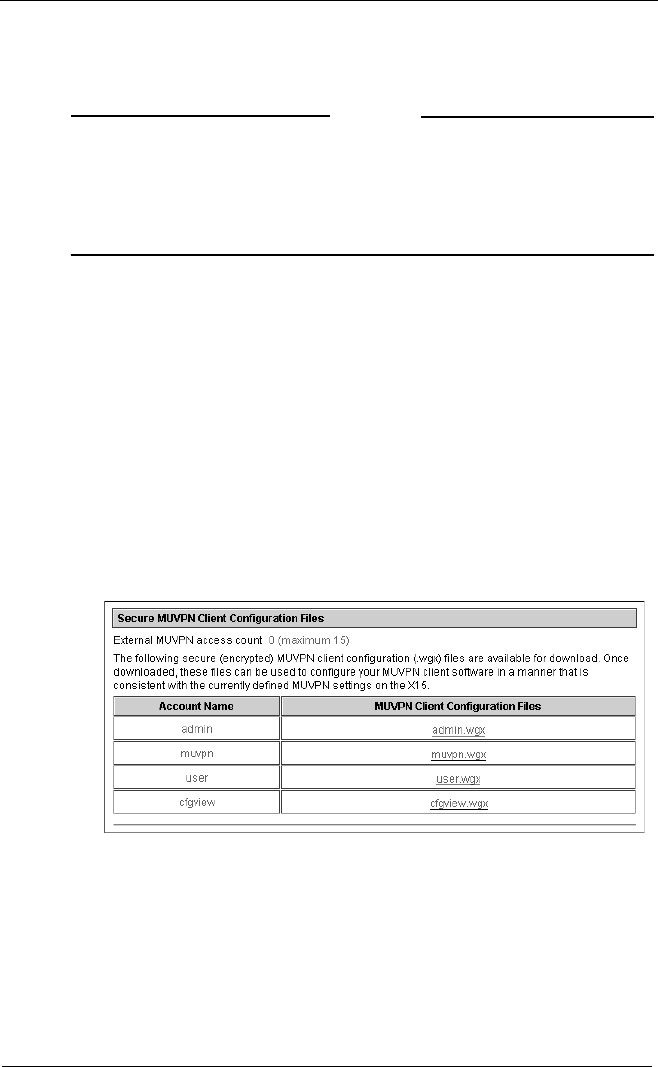
Configuring the MUVPN Client
132 WatchGuard Firebox X Edge
13 The MUVPN client is installed. Make sure the option Yes, I want
to restart my computer now is selected. Click Finish.
The computer restarts.
NOTE
The ZoneAlarm personal firewall may prevent you from
conencting to the network after the computer restarts. If this
occurs, log on to the computer locally the first time after
installation. For more information, see “The ZoneAlarm Personal
Firewall” on page 140.
Importing the .wgx file
The Firebox X Edge has encrypted MUVPN client configuration
(.wgx) files available for download.
1To connect to the System Status page, type the IP address of
the trusted network in the browser.
The default IP address is: https://192.168.111.1
2From the navigation bar, select Firebox Users and scroll to the
bottom of the page.
3Under MUVPN Client Configuration Files, select the .wgx file
you want to download and follow the instructions on the
screen.
Uninstalling the MUVPN client
Use this procedure to uninstall the MUVPN client. WatchGuard rec-
ommends that you use the Windows Add/Remove Programs tool.

Enabling MUVPN for Edge Users
User Guide 133
Disconnect all existing tunnels and dial-up connections. Reboot the
remote computer. From the Windows desktop:
1Select Start > Settings > Control Panel.
The Control Panel window appears.
2Double-click the Add/Remove Programs icon.
The Add/Remove Programs window appears.
3Select Mobile User VPN and click Change/Remove.
The InstallShield wizard appears.
4Select Remove. Click Next.
The Confirm File Deletion dialog box appears.
5Click OK to remove all of the components.
When the dni_vapmp file is removed, a command prompt window
appears. This is normal. After the file is removed, the command prompt
window closes and the procedure continues.
The Uninstall Security Policy dialog box appears.
6Click Yes to delete the Security Policy Personal Certificates and
the Private/Public Keys.
The InstallShield Wizard window appears.
7Select the Yes, I want to restart my computer now. Click the
Finish option.
The computer reboots.
NOTE
The ZoneAlarm personal firewall settings are stored in the
following directories by default.
Windows 98: c:\windows\internet logs\
Windows NT and 2000: c:\winnt\internet logs\
Windows XP: c:\windows\internet logs
To remove these settings, delete the contents of the appropriate
directory.
8When the computer has restarted, select Start > Programs.
9Right-click Mobile User VPN and select Delete to remove this
selection from your Start menu.
Enabling MUVPN for Edge Users
After you have configured the MUVPN client, you can configure
MUVPN client and user settings on the Firebox X Edge.

Configuring the MUVPN Client
134 WatchGuard Firebox X Edge
Configuring MUVPN client settings
The MUVPN client settings apply to all of the Edge’s MUVPN con-
nections. For information on these settings, see “Configuring
MUVPN client settings” on page 151.
Enabling MUVPN access for an Edge user account
1Type the IP address of the trusted network in your browser
window to connect to the System Status page of the Firebox X
Edge.
The default trusted IP address is https://192.168.111.1.
2Add a new user or edit an existing user, as described in “Adding
or Editing a User Account” on page 152.
3Click the MUVPN tab.
4Select the Enable MUVPN for this account checkbox.
5Type a shared key in the applicable field.
6Type the virtual IP address in the applicable field.
The virual IP address must be an address on the Firebox X Edge trusted
network that is not used. This address is used by the remote computer to
connect to the Firebox X Edge.
7From the Authentication Algorithm drop-down list, select the
type of authentication.
The options are MD5-HMAC and SHA1-HMAC.
8From the Encryption Algorithm drop-down list, select the type
of encryption.
The options are DES-CBC and 3DES-CBC.
9Set MUVPN key expiration in kilobytes or hours. The default
values are 8192 KB and 24 hours, respectively.
10 Select Mobile User from the VPN Client Type drop-down list.
11 Select the All traffic uses tunnel (0.0.0.0/0 IP Subnet)
checkbox if the remote client will send all its traffic (including
normal Web traffic) over the VPN to the Firebox X Edge. This
can also let the MUVPN client communicate with other
networks that the Firebox X Edge connects. If this checkbox is
selected, the MUVPN client software must be configured with
the subnet and mask fields set to 0.0.0.0.
12 Click Submit.
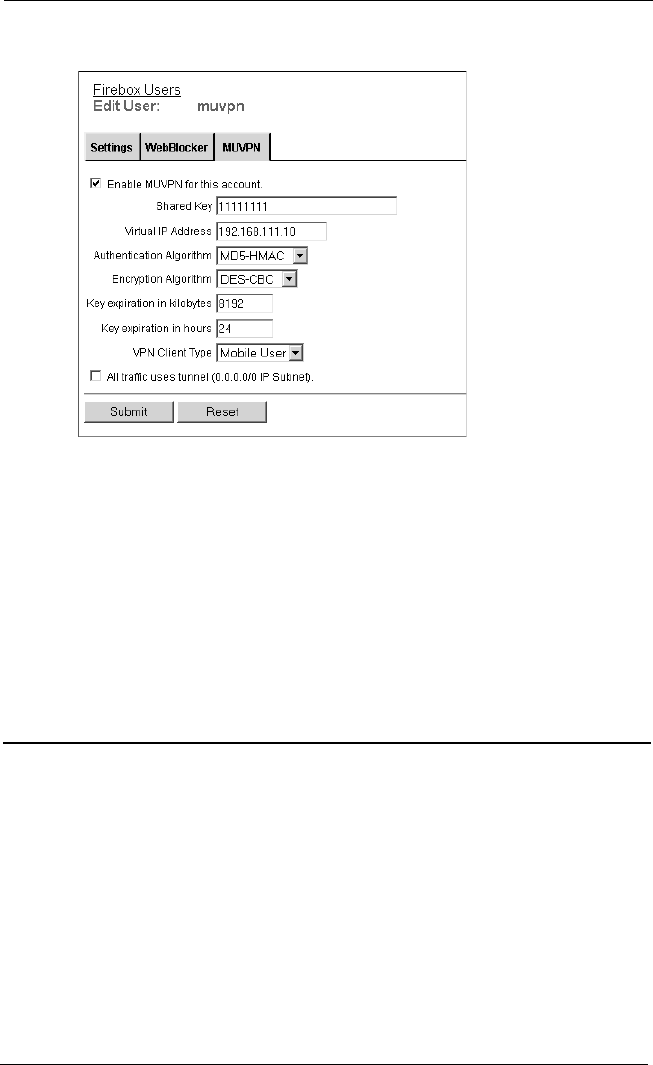
Connecting and Disconnecting the MUVPN Client
User Guide 135
Configuring the Firebox for MUVPN Clients Using
Pocket PC
To create a MUVPN tunnel between the Firebox X Edge and your
Pocket PC, you must configure the MUVPN Clients feature on the
Firebox. Follow the previous procedure, except select Pocket PC
from the VPN Client Type drop-down list.
For additional information about configuring your Pocket PC to
serve as an MUVPN client, go to the WatchGuard Web site:
https://www.watchguard.com/support/sohoresources/soinstallhelp.asp
Connecting and Disconnecting the MUVPN Client
The MUVPN client software makes a secure connection from a
remote computer to your protected network on the Internet. To
start this connection, you must connect to the Internet and use the
MUVPN client to connect to the protected network.
Connecting the MUVPN client
1Start your connection to the Internet through a Dial-Up
Networking connection, a LAN connection, or a WAN
connection.
From the Windows desktop system tray:

Configuring the MUVPN Client
136 WatchGuard Firebox X Edge
2If the MUVPN client is not active, right-click the icon and select
Activate Security Policy.
For information about the MUVPN icon, see “The MUVPN client icon” on
page 136.
From the Windows desktop:
3Select Start > Programs > Mobile User VPN > Connect.
The WatchGuard Mobile User Connect window appears.
4Click Yes.
The MUVPN client icon
The MUVPN icon appears in the Windows desktop system tray. The
icon image provides information about the status of the connection.
Deactivated
The MUVPN Security Policy is not active. This icon can appear if
the Windows operating system did not start a required MUVPN
service. If this occurs, the remote computer must be restarted. If
the problem continues, reinstall the MUVPN client.
Activated
The MUVPN client can make a secure MUVPN tunnel
connection.
Activated and Transmitting Unsecured Data
The MUVPN client can make a secure MUVPN tunnel
connection. The red bar on the right of the icon tells you that
the client is sending data that is not secure.
Activated and Connected
The MUVPN client is connected with one or more secure MUVPN
tunnels, but it is not sending data.
Activated, Connected and Transmitting Unsecured Data

Connecting and Disconnecting the MUVPN Client
User Guide 137
The MUVPN client started one or more secure MUVPN tunnel
connections. The red bar on the right of the icon tells you that
the client is sending data that is not secure.
Activated, Connected and Transmitting Secured Data
The MUVPN client started one or more secure MUVPN tunnels.
The green bar on the right of the icon tells you that the client is
only sending data that is secure.
Activated, Connected and Transmitting both Secured and
Unsecured Data
The MUVPN client started one or more secure MUVPN tunnels.
The green and red bars on the right of the icon tell you that the
client is sending data that is secure and data that is not secure.
Allowing the MUVPN client through a personal firewall
To create the MUVPN tunnel, you must allow these programs
through the personal firewall:
• MuvpnConnect.exe
•IreIKE.exe
The personal firewall detects when these programs attempt to access
the Internet. A New Program alert window appears to request access
for the MuvpnConnect.exe program.
From the New Program alert window:
1Select the Remember this answer the next time I use this
program checkbox, then click Yes.
This option lets the ZoneAlarm personal firewall allow Internet access for
this program each time you start a MUVPN connection.
The New Program alert window appears to request access for the
IreIKE.exe program.

Configuring the MUVPN Client
138 WatchGuard Firebox X Edge
2Set the Remember this answer the next time I use this
program check box and then click Yes.
This option lets the ZoneAlarm personal firewall allow Internet access for
this program each time you start a MUVPN connection.
Disconnecting the MUVPN client
From the Windows desktop system tray:
1Right-click the MUVPN client icon and select Deactivate
Security Policy.
The MUVPN client icon with a red bar is displayed.
If the ZoneAlarm personal firewall is active, deactivate it now.
From the Windows desktop system tray:
1Right-click the ZoneAlarm icon shown at right.
2Select Shutdown ZoneAlarm.
The ZoneAlarm window appears.
3Click Yes.
Monitoring the MUVPN Client Connection
The Log Viewer and the Connection Monitor are installed with the
MUVPN client. These tools let you monitor the MUVPN connection
and troubleshoot problems.
Using Log Viewer
Use Log Viewer to display the communications log. This log shows
the events that occurr when the MUVPN tunnel is started.
From the Windows desktop system tray:
1Right-click the Mobile User VPN client icon.
2Select Log Viewer.
The Log Viewer window appears.
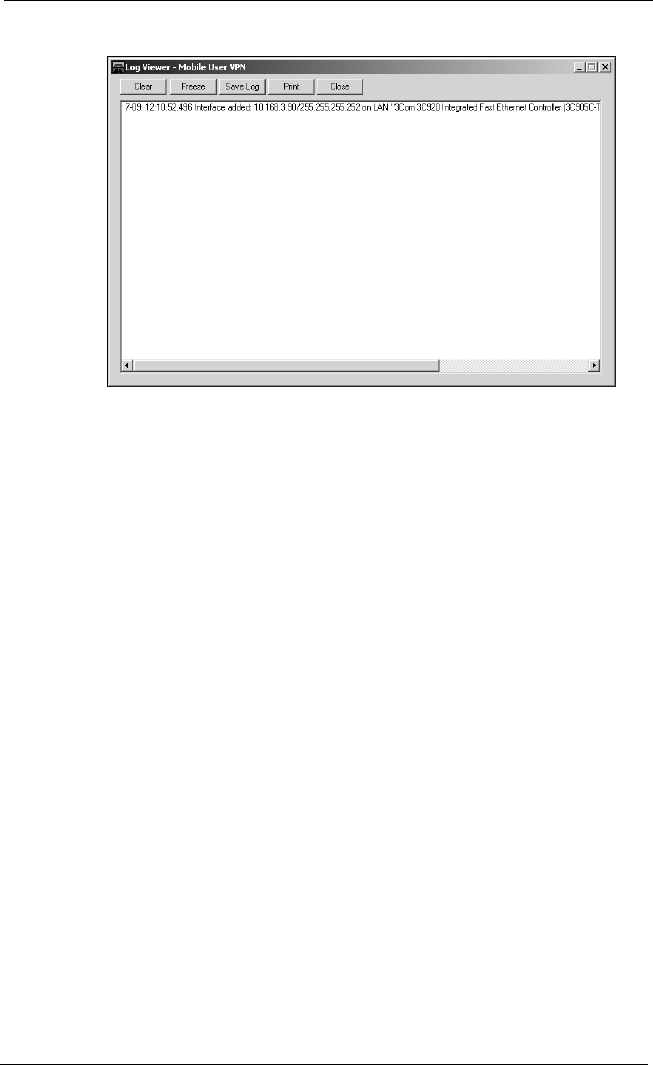
Monitoring the MUVPN Client Connection
User Guide 139
Using Connection Monitor
The Connection Monitor shows statistical and diagnostic informa-
tion for connections in the security policy. This window shows the
security policy settings and the security association (SA) informa-
tion. The monitor records the information that appears in this win-
dow during the phase 1 IKE negotiations and the phase 2 IPSec
negotiations.
From the Windows desktop system tray:
1Right-click the Mobile User VPN client icon.
2Select Connection Monitor.
The Connection Monitor window appears.
An icon appears to the left of the connection name:
• SA tells you that the connection only has a phase 1 SA. A phase
1 SA is assigned in the following situations:
- for a connection to a secure gateway tunnel
- when a phase 2 SA connection has not yet been made
- when a phase 2 SA connection cannot be made
• A key tells you that the connection has a phase 2 SA. This
connection may also have a phase 1 SA.
• An animated black line underneath a key tells you that the
client is processing secure IP traffic.

Configuring the MUVPN Client
140 WatchGuard Firebox X Edge
• A single SA icon with several key icons above it indicates a
single phase 1 SA to a gateway that protects multiple phase 2
SAs.
The ZoneAlarm Personal Firewall
ZoneAlarm Personal firewall protects your computer and network by
following a simple rule: Block all incoming and outgoing traffic
unless you explicitly allow that traffic for trusted programs.
When you use ZoneAlarm you often see New Program alert win-
dows. This alert appears when an application tries to get Internet or
local network access. This alert stops data from your computer with-
out your authorization.
The ZoneAlarm personal firewall includes a tutorial after the
MUVPN client is installed. Read the tutorial to learn how to use this
application.
For more information about the features and configuration of
ZoneAlarm, use the ZoneAlarm help system. To access the help sys-
tem, select Start > Programs > Zone Labs > ZoneAlarm Help.
Allowing traffic through ZoneAlarm
When an application tries to get access through the ZoneAlarm per-
sonal firewall, a New Program alert appears. This alert tells the user
the name of the application. This can cause confusion for users.
To let a program get access to the Internet each time the application
is started, select the Remember the answer each time I use this
program check box.
Here is a list of some programs that need to pass through the
ZoneAlarm personal firewall when you use their associated applica-
tions.
Programs That Must Be Allowed
MUVPN client IreIKE.exe
MuvpnConnect.exe
MUVPN Connection Monitor CmonApp.exe
MUVPN Log Viewer ViewLog.exe
Programs That Can be Allowed
MS Outlook OUTLOOK.exe

The ZoneAlarm Personal Firewall
User Guide 141
Shutting down ZoneAlarm
From the Windows desktop system tray:
1Right-click the ZoneAlarm icon shown at right.
2Select Shutdown ZoneAlarm.
The ZoneAlarm window appears.
3Click Yes.
Uninstalling ZoneAlarm
From the Windows desktop:
1Select Start > Programs > Zone Labs > Uninstall ZoneAlarm.
The Confirm Uninstall dialog box appears.
2Click Yes.
The ZoneLabs TrueVector service dialog box appears.
3Click Yes.
The Select Uninstall Method window appears.
4Make sure Automatic is selected and then click Next.
5Click Finish.
NOTE
The Remove Shared Component window can appear. During the
initial installation of ZoneAlarm, some files were installed that
could be shared by other programs on the system. Click Yes to All
to completely remove all of these files.
6The Install window appears and prompts you to restart the
computer. Click OK to restart.
MS Internet Explorer IEXPLORE.exe
Netscape 6.1 netscp6.exe
Opera Web browser Opera.exe
Standard Windows network applications lsass.exe
services.exe
svchost.exe
winlogon.exe

Configuring the MUVPN Client
142 WatchGuard Firebox X Edge
Troubleshooting Tips
Get additional information about the MUVPN client from the
WatchGuard Web site:
www.watchguard.com/support
The answers to several frequently asked questions about the MUVPN
client are answered below.
My computer hangs immediately after installing the
MUVPN client...
This problem can be caused by one of the following two problems:
• The ZoneAlarm personal firewall application is stopping normal
traffic on the local network.
• The MUVPN client is active and is unsuccessfully attempting to
create VPN tunnels.
When the MUVPN client is not in use, ZoneAlarm and the MUVPN
client should be deactivated.
From the Windows desktop system tray:
1Reboot your computer.
1Right-click the MUVPN client icon and select Deactivate
Security Policy.
The MUVPN client icon with a red bar appears to indicate that the
Security Policy has been deactivated.
1Right-click the ZoneAlarm icon shown at right.
2Select Shutdown ZoneAlarm.
The ZoneAlarm dialog box appears.
3Click Yes.
I have to enter my network login information even
when I’m not connected to the network...
When you start your computer, you must type your Windows net-
work user name, password, and domain. It is very important that
you type this information correctly. Windows keeps this information
for use by network adapters and network applications. When you
connect through the MUVPN client, your computer uses this infor-
mation to connect to the company network.

Troubleshooting Tips
User Guide 143
I am not prompted for my user name and password
when I turn my computer on...
The ZoneAlarm personal firewall application can cause this problem.
This program is very good at what it does. ZoneAlarm keeps your
computer secure from unauthorized incoming and outgoing traffic.
Unfortunately, it can prevent your computer from broadcasting its
network information. This prevents your computer from sending the
login information. Make sure you deactivate ZoneAlarm each time
you disconnect the MUVPN connection.
Is the MUVPN tunnel working?
The MUVPN client icon appears in the Windows desktop system tray
when the application is launched. The MUVPN client displays a key
in the icon when the client is connected.
To test the connection, ping a computer on your company network.
• Select Start > Run and then type ping and the IP address of a
computer on your company network.
My mapped drives have a red X through them...
Windows 98/ME, NT, and 2000 verify and map network drives auto-
matically when the computer starts. Because you cannot establish a
remote session with the company network before the computer
starts, this process fails. This causes a red X to appear on the drive
icons. To correct this problem, start a MUVPN tunnel and open the
network drive. The red X for that drive should disappear.
How do I map a network drive?
Due to a Windows operating system limitation, mapped network
drives must be remapped when you work remotely. To remap a net-
work drive from the Windows desktop:
1Right-click Network Neighborhood.
2Select Map Network Drive.
The Map Network Drive window appears.
3Use the drop-down list to select a drive letter.
Select a drive from the drop-down list or type a network drive path.
4Click OK.
The mapped drive appears in the My Computer window. Even if you
select the Reconnect at Logon checkbox, the mapped drive will only
appear the next time you start your computer if the computer is
directly connected to the network.

Configuring the MUVPN Client
144 WatchGuard Firebox X Edge
I am sometimes prompted for a password when I am
browsing the company network...
Due to a Windows networking limitation, remote user virtual private
networking products can allow access only to a single network
domain. If your company has multiple networks connected together,
you will only be able to browse your own domain. If you try to con-
nect to other domains, a password prompt will appear. Unfortu-
nately, even providing the correct information will not allow you to
access these additional networks.
It takes a
very
long time to shut down the computer
after using the MUVPN client...
If you access a mapped network drive during an MUVPN session, the
Windows operating system will wait for a signal from the network
before the shutdown is complete.
I lost the connection to my ISP, and now I can’t use
the company network...
If your Internet connection is interrupted, the connection to the
MUVPN tunnel may be lost. Follow the procedure to close the tun-
nel. Reconnect to the Internet. Restart the MUVPN client.

User Guide 145
CHAPTER 11 Managing the
Firebox® X Edge
The Firebox® X Edge includes tools to help you manage your network
and your users. You can:
• Examine current users and properties
• Configure user profiles and customize user accounts
• Upgrade the Edge and activate new features
• Examine the current configuration file in a text format
Viewing Current Sessions and Users
A
session
is a connection between a computer on the trusted or
optional network and a computer on the external network. For exam-
ple when a user on your trusted network opens a browser to connect
to a Web site on the Internet, a session starts on the Firebox® X Edge.
On the Firebox Users page, you can see information in the Active Ses-
sions section. You can also see information on the users that you con-
figured for this Edge.
1To connect to the System Status page, type the IP address of the
trusted network in the browser.
The default IP address is: https://192.168.111.1
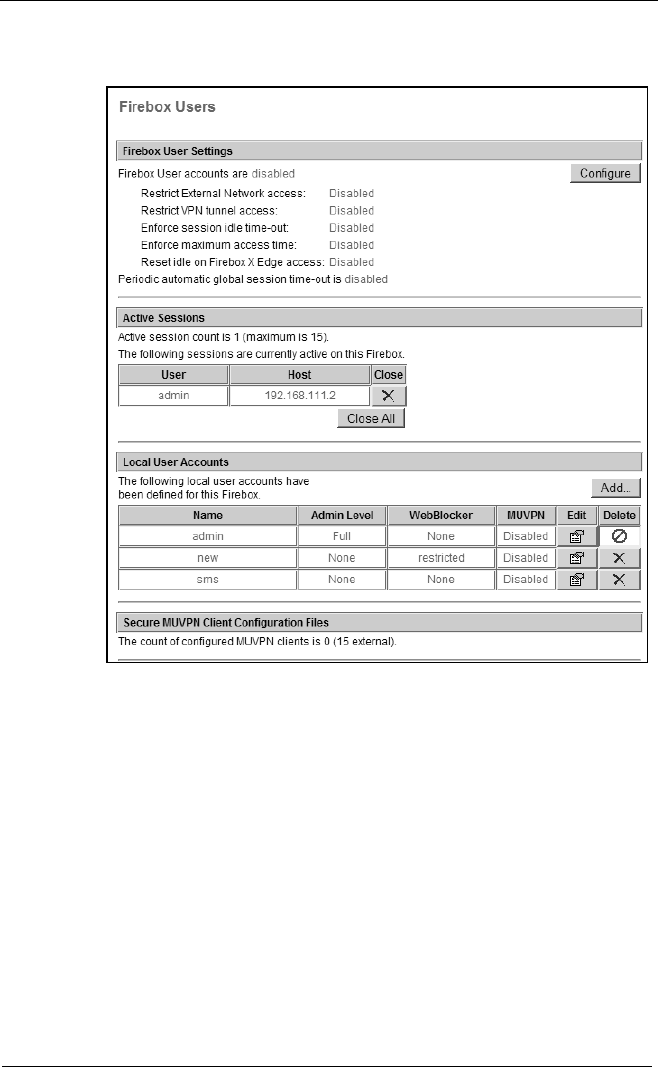
Managing the Firebox® X Edge
146 WatchGuard Firebox X Edge
2From the navigation bar, select Firebox Users.
The Firebox Users page appears.
Firebox User Settings
Below Firebox User Settings, you can see the current values for all
global user and session settings. Click the Configure button to open
the Settings page. For more information, see “Changing authentica-
tion options for all users” on page 149 and “Configuring MUVPN
client settings” on page 151.
Active Sessions
An active session is a connection from the trusted or optional net-
work through the Firebox to the external network. The Firebox uses
one seat license for each active session. Below Active Sessions, the
page shows information for all current sessions:
• The name of the user who started the session
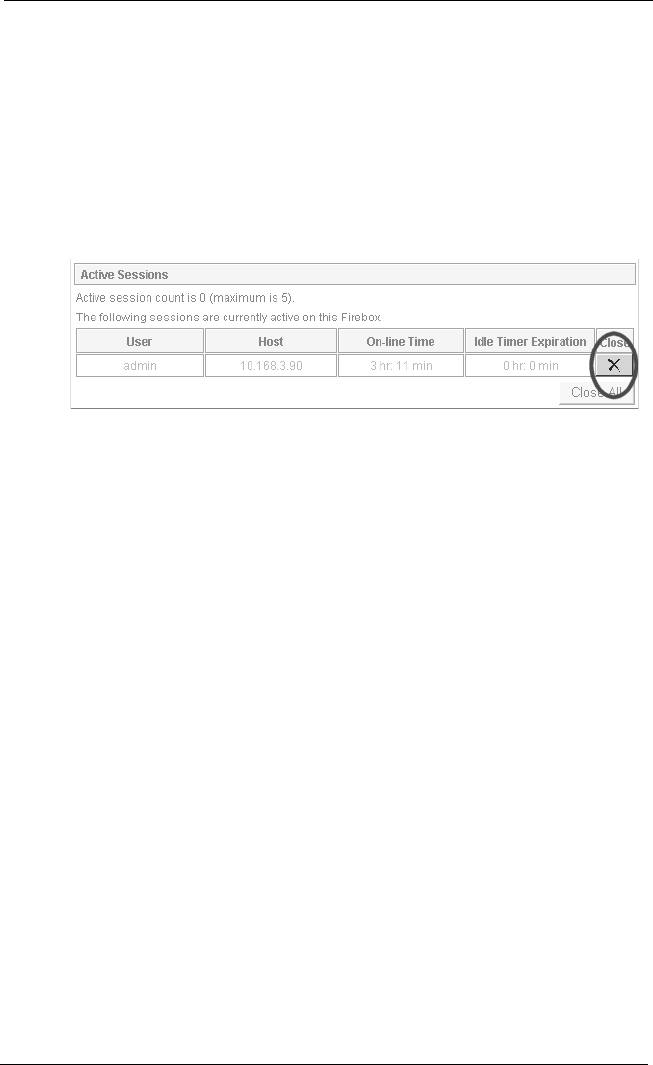
Viewing Current Sessions and Users
User Guide 147
• The total length of time of the session
• The time between the last packet and the session expiration.
This is known as the idle time. If you set the idle time to 0 hours
and 0 minutes, the Firebox does not disconnect the session.
Closing a session
To disconnect an active session, click the X for the session. A dialog
box appears. Click Yes to disconnect the session. To disconnect all
active sessions, click Close All.
• The user can log out manually by clicking the Logout button on
[page]. If the user clicks this button, the Login Status box closes,
and a warning dialog bog appears. The logout process is not
complete until the user closes all open browsers.
When a session closes, the seat license is available again for another
user. For more information on seat licenses, see “About Seat
Licenses” on page 156.
Local User Accounts
Below Local User Accounts, you can see information on the users
you configured to use this Edge:
• Name -- The administrator account appears first in the list.
Other users appear in alphanumeric sequence.
• Admin Level -- You can set the user permissions to Full, None,
or Read-only. For more information, see “Adding or Editing a
User Account,” on page 152.
• Options -- You can configure a user to use WebBlocker or
MUVPN. For more information, see “Setting a WebBlocker
profile for a user,” on page 154 and “Enabling MUVPN for a
user,” on page 154.
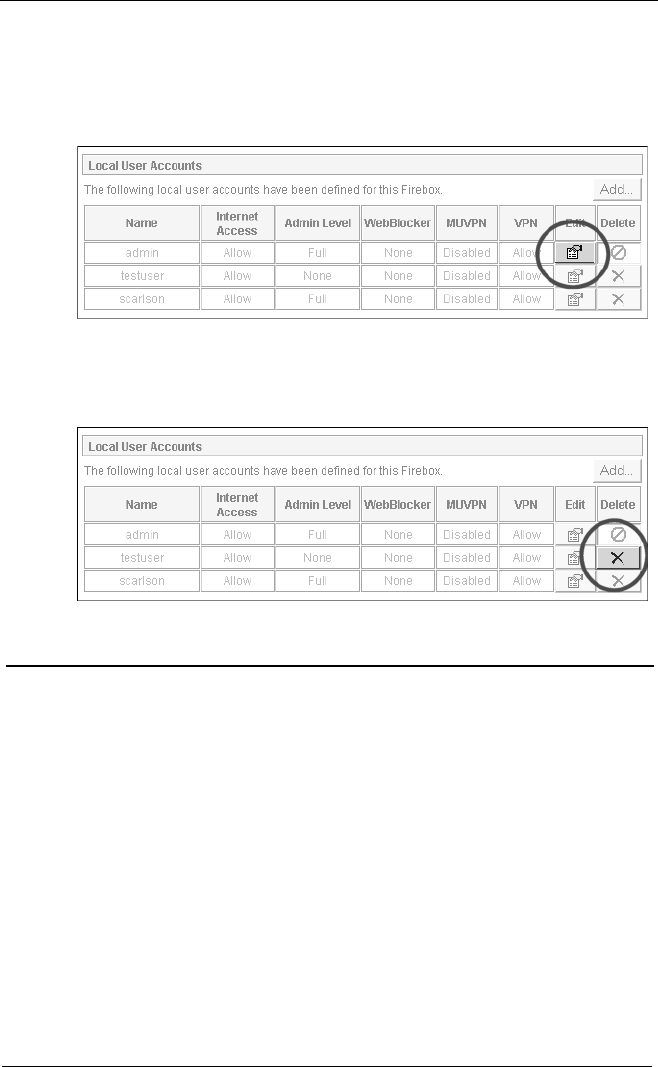
Managing the Firebox® X Edge
148 WatchGuard Firebox X Edge
Editing a user account
To edit a user account, click its Edit icon. For descriptions of the
fields you can configure, see “Adding or Editing a User Account,” on
page 152.
Deleting a user account
To remove a user account, click the X for the account. A dialog box
appears. Click Yes to remove the account.
About User Authentication
The Firebox® X Edge uses advanced authentication options to
increase network security. There are options to prevent connections
to some resources and to help decrease the number of seat licenses
necessary. This section gives information on how a user can authen-
ticate to the Edge, how your users and administrators can close an
active session, and which options are available to customize authen-
tication.
There are three levels of Administrative Access available for the
Edge:
•None -- Use to connect to resources on the external network. A
user with this access level can not see or change the Edge
configuration pages.

About User Authentication
User Guide 149
•Read-Only -- Use to see Edge configuration properties and
status. A user with this access level can not change the
configuration file.
•Full -- Use to see and to change Edge configuration properties.
You can also activate options, disconnect active sessions, restart
the Edge, and add or edit user accounts. A user with this access
level can change the passphrase for all user accounts.
Authenticating to the Firebox
When you authenticate to the Edge, it automatically identifies your
Administrative Access Level. The authentication procedure is the
same for all users.
1Open a Web browser.
You can use Netscape Navigator or Microsoft Internet Explorer. The Edge
may be compatible with other Web browsers, but we do not support
them.
2Type the Firebox X Edge trusted IP address in the address bar.
The factory default trusted IP address address is:
https://192.168.111.1.
3A security dialog box appears. You must accept the warning
before you can continue.
When you authenticate to the Edge, one of two screens appears. A
user with Read-Only or Full Administrative Access sees the Firebox X
Edge System Status page. A user with Administrative Access set to
None sees a dialog box with an authentication status message.
When you authenticate to the Edge, your user name appears in the
Active Sessions section of the Firebox Users page.
Changing authentication options for all users
There are some authentication settings which apply to all users. To
change authentication options:
1Type the IP address of the trusted network in your browser
window to connect to the System Status page of the Firebox.
The default IP address is: https://192.168.111.1
2From the navigation bar, select Firebox > Settings.
The Settings page appears.
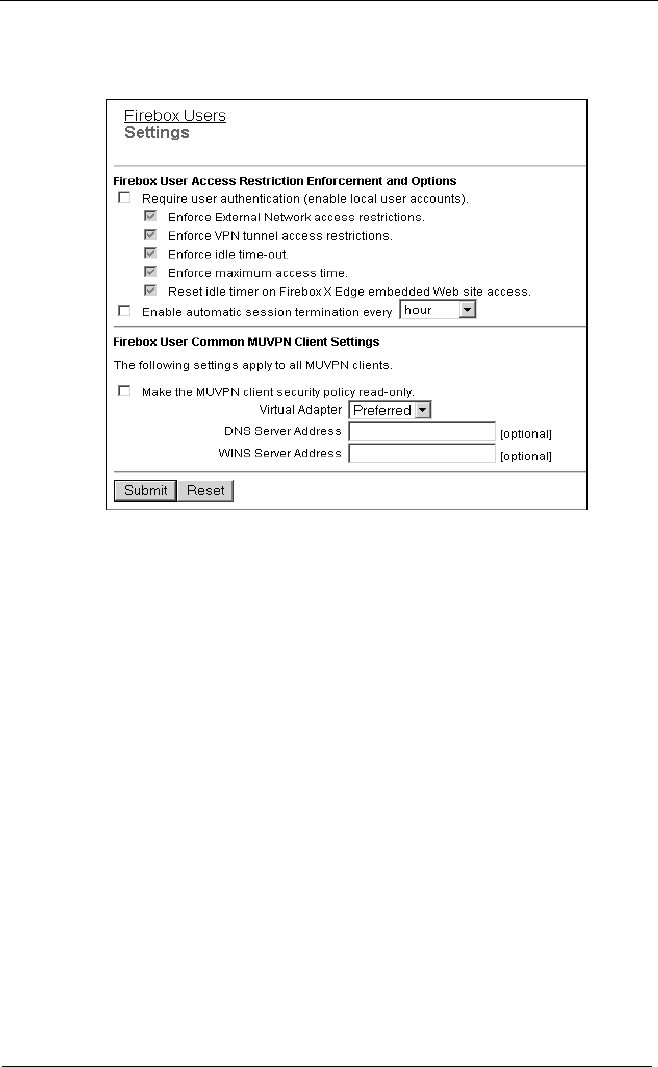
Managing the Firebox® X Edge
150 WatchGuard Firebox X Edge
3Use the definitions below to help you change your settings.
Click Submit.
•Require User Authentication – You must select this check box
to use the authentication options.
•External Network Access Restrictions – Enable this check box
if it is necessary for your users to authenticate before they
connect to computers on the external network. The external
network is frequently the Internet.
•VPN Tunnel Access Restrictions – Enable this check box if it is
necessary for your users to authenticate before they can connect
to computers on different network through a branch office
VPN.
•Idle Time-Out – When the user does not send traffic to the
external network for the length of the idle time-out, the Edge
closes the session.
•Maximum Access Time – You can configure the Edge to close a
session after a specified interval. Customers frequently use this
option to prevent their users from browsing the Internet for
extended periods of time. When a user authenticates to the

About User Authentication
User Guide 151
Edge, the clock starts on the session. After the specified interval,
the user must authenticate again or the Edge closes the session.
•Reset Idle Timer on Embedded Web Site Access – The Edge
will not disconnect a session when an idle time-out occurs if the
Login Status dialog box is on the desktop. Disable this check
box to override the Login Status dialog box.
•Automatic Session Termination – This is a global property
which applies to all sessions and which overrides all other
authentication options. It lets you clear the list of seat licenses
in use and make them available again. Enable this check box to
disconnect all sessions at the specified time in the drop-down
list.
Configuring MUVPN client settings
The MUVPN client settings apply to all MUVPN connections to the
Edge. To configure MUVPN client settings:
1Use your browser to connect to the System Status page. From
the navigation bar, select Firebox Users > Settings.
The Settings page appears.
2If necessary, use the scroll bar to scroll to the Firebox User
Common MUVPN Client Settings section.
3You can lock the MUVPN client security policy (.wgx file) to
prevent a change to it. Select the Make the MUVPN client
security policy read-only check box.
4The remote MUVPN computers can use a virtual adapter to get
network settings, an IP address, and WINS and DNS. You can set
the virtual adapter rule for your mobile users to:
Disabled
The mobile user does not use a virtual adapter to connect with
the MUVPN client.
Preferred
If the virtual adapter is in use or it is not available, the mobile
user does not use a virtual adapter to connect with the MUVPN
client. This is the default value.
Required
The mobile user must use a virtual adapter to connect with the
MUVPN client.
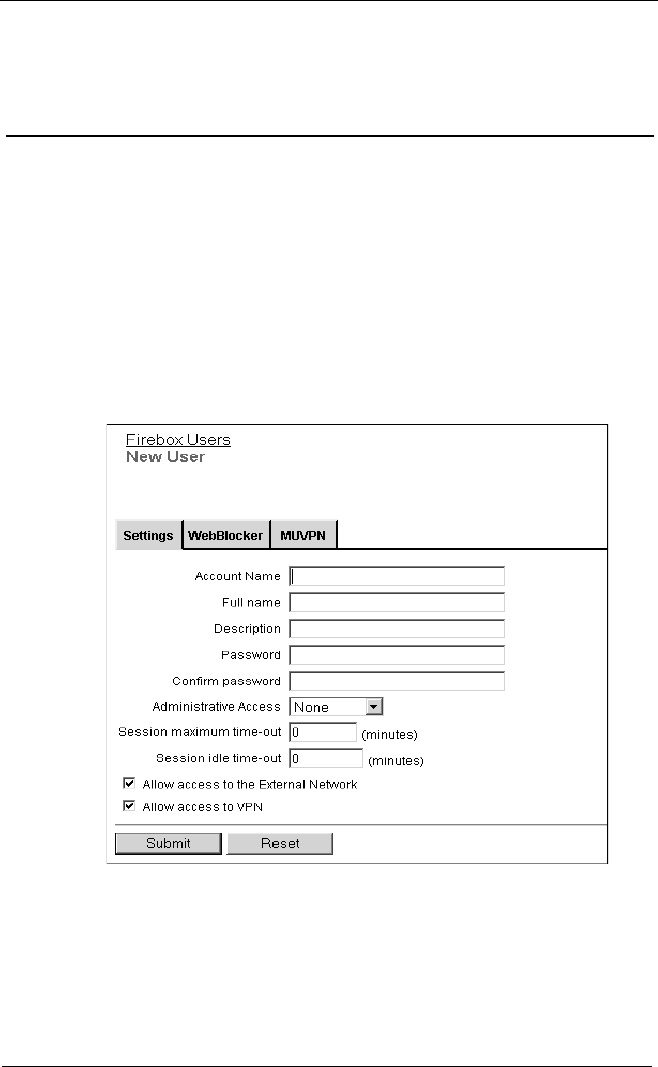
Managing the Firebox® X Edge
152 WatchGuard Firebox X Edge
5You can also enter a WINS Server Address and DNS Server
Address. Type the server IP addresses in the related field.
Adding or Editing a User Account
Firebox X Edge users When you create a user for the Firebox X Edge,
you select the Administrative Access Level for that user. You can also
configure a WebBlocker account and MUVPN restrictions.
1Type the IP address of the trusted network in your browser
window to connect to the System Status page of the Firebox.
The default IP address is: https://192.168.111.1
2From the navigation bar, select Firebox Users.
The Firebox Users page appears.
3Under Local User Accounts, click Add.
The New User page appears. It shows the Settings tab.
4In the Account Name field, enter a name for the account. The
user enters this name when authenticating.
The account name is case-sensitive.
5In the Full Name field, enter the first and last name of the user.
This is for your information only. A user does not use this name during
authenticating.

Adding or Editing a User Account
User Guide 153
6In the Description field, enter a description for the user.
This is for your information only.
7In the Password field, enter a password with a maxium of eight
characters.
Mix eight letters, numbers, and symbols. Do not use a word you could
find in a dictionary. For increased security use a minimum of one special
symbol, a number, and a mixture of uppercase and lowercase letters.
8Enter the password again in the Confirm Password field.
9In the Administrative Access drop-down list, set the level to
which your user can see and change the Edge configuration
properties: None, Read-Only, or Full.
For more information, see “Creating a read only administrative
account,” on page 153.
10 In the Session maximum time-out field, set the maximum
amount of time the user's computer can pass traffic to the
external network or across a Branch Office VPN. A setting of
zero minutes means this user has no time limit on how long his
or her session can last.
You can also apply a global "Maximum session time-out" to all users. The
global setting overrides the individual Firebox User setting. For more
information, see “Changing authentication options for all users” on
page 149.
11 In the Session idle time-out field, set the amount of time the
user's computer can remain authenticated when it is idle (not
passing any traffic to the external network or across the Branch
Office VPN or to the Firebox X Edge itself). A setting of zero
minutes means there is no idle time-out.
12 If you want this user to have Internet access, select the Allow
access to the External Network checkbox.
13 If you want this user to have access to computers on the other
side of a Branch Office VPN tunnel, select the Allow access to
VPN checkbox.
14 Click Submit.
Creating a read only administrative account
You can create a local user account with limited access to view Fire-
box configuration pages. When you log in as a read-only adminis-
trator, you cannot:
•Click the Reboot button on the System Status page.

Managing the Firebox® X Edge
154 WatchGuard Firebox X Edge
• Change the configuration mode on the External page.
•Click the Reset Event Log and Sync Time with Browser Now
buttons on the Logging page.
•Click the Synchronize Now button on the System Time page.
•Click the Regenerate IPSec Keys button on the VPN page.
• Change the configuration mode on the Managed VPN page.
•Click the Launch Wizard button from the Wizard page.
To create a read-only user account, edit the user account. Use the
Administrative Access drop-down list to select Read Only.
Setting a WebBlocker profile for a user
A WebBlocker profile is a unique set of restrictions you can apply to
users on your network. To set a WebBlocker profile for a new user,
click the WebBlocker tab and select a profile from the drop-down
list. For more information on WebBlocker profiles, see “Creating
WebBlocker Profiles” on page 99.
Enabling MUVPN for a user
To enable MUVPN for a new user, see “Enabling MUVPN for Edge
Users” on page 133.
The Administrator account
The Firebox X Edge has a built-in administrator account that cannot
be deleted. You can, however, change some of the administrator
account’s settings. On the Firebox Users page, click the icon in the
Edit column of the administrator account.
For descriptions of the fields, see the previous section, “Adding a
New User.”
Make sure you record the administrator name and password in a safe
location. These are required to access the configuration pages. If the
system administrator name and password are unknown or you have
forgotten them, you must reset the Firebox to the factory default
settings. For more information, see “Resetting the Firebox to the
factory default settings” on page 42.
We recommend that you change the administrator password every
month. Select a combination of eight letters, numbers, and symbols.
Do not use an English or foreign word. Use at least one special sym-

Adding or Editing a User Account
User Guide 155
bol, a number, and a mixture of upper case and lower case letters
for increased security.
Terminating a session
A Firebox uses a session when it makes a connection between a
computer on the trusted interface and a computer on the external
interface. The Firebox releases the session when:
• the session reaches the idle timeout limit;
• the session reaches the maximum time limit;
• the Firebox administrator uses the Firebox Users page to end the
session
• the user ends the session by closing all browser windows; or
• the Firebox restarts.
To end a session manually:
1Type the IP address of the trusted network in your browser
window to connect to the System Status page of the Firebox.
The default IP address is: https://192.168.111.1
2From the navigation bar, select Firebox Users.
The Firebox Users page appears.
3Find the session in Active Sessions list. Click the close button. To
end all sessions, click the Close All button.
Changing a user account name or password
You can change either an account name or account password. You
cannot change then both. If you change the account name, you
must provide the account password.
1Type the IP address of the trusted network in your browser
window to connect to the System Status page of the Firebox.
The default IP address is: https://192.168.111.1
2From the navigation bar, select Firebox Users.
The Firebox Users page appears.
3Under Local User Accounts, click Edit for the account whose
password you want to change.
The Edit User page appears with the Settings tab visible.
4Click Change Identification.
5Type the old password and a new password. Confirm the new
password.
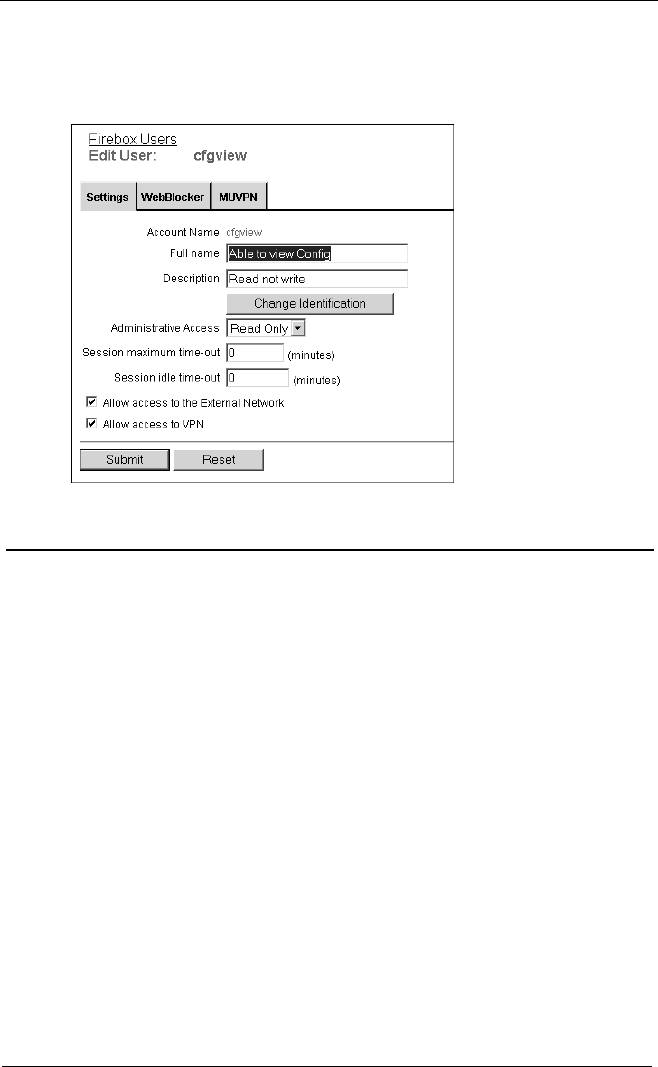
Managing the Firebox® X Edge
156 WatchGuard Firebox X Edge
6Click Submit.
About Seat Licenses
The Firebox X Edge is enabled with a set number, or "pool,” of seat
licenses. The number of seat licenses limits how many users can get
out to the Internet at one time. The total number of available seat
licenses in the pool is determined by the Edge model you have and
any upgrade licenses you apply.
The main Firebox Users page (under Active Sessions) shows how
many seat licenses are in use when you require users to authenticate
before accessing resources. This page also shows the maximum
number of seat licenses currently allowed.
A seat license is used when the Edge allows traffic to be passed from
a computer on the trusted or optional network to the external net-
work (typically the Internet). Forcing users to authenticate before
accessing the external network ensures that no seat licenses are used
by machines that are not authorized to access the external network.
If a user or computer tries to access the external network without
authenticating, and authentication is required, the Edge does not
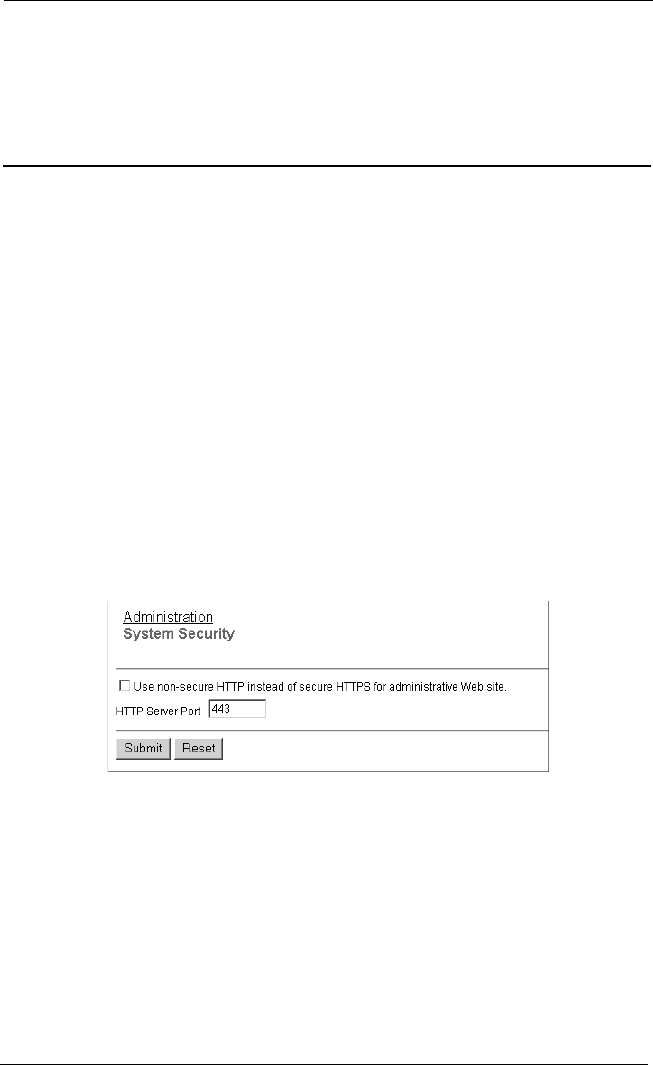
Selecting HTTP or HTTPS for Firebox Management
User Guide 157
allow the traffic to pass. A seat license is consumed only when traf-
fic is allowed to pass from behind the Edge to the external network.
Selecting HTTP or HTTPS for Firebox
Management
HTTP (Hypertext Transfer Protocol) is the “language” used for trans-
ferring files (text, graphic images, and multimedia files) on the
Internet. HTTPS (Hypertext Transfer Protocol over Secure Socket
Layer) is similar except that it enhances computer security by
encrypting and decrypting the names of Web pages you type into
your browser. For greater security, the Firebox® X Edge uses HTTPS
by default.
Follow these instructions to use the less secure HTTP instead of
HTTPS:
1Type the IP address of the trusted network in your browser
window to connect to the System Status page of the Firebox.
The default IP address is: https://192.168.111.1
2From the navigation bar, select
Administration > System Security.
The System Security page appears.
3Select the Use non-secure HTTP instead of secure HTTPS for
administrative Web site checkbox.
4Click Submit.
If you select this checkbox, you must use http:// in the browser's
address bar to bring up configuration pages instead of the default
https://.

Managing the Firebox® X Edge
158 WatchGuard Firebox X Edge
Changing the HTTP Server Port
To connect to the Firebox X Edge to view its configuration pages, or
for a user to authenticate to the Edge, the browser's connection
must use the same port as the Edge’s HTTP server port. Because
HTTPS uses TCP port 443 (HTTP uses TCP port 80), the default
HTTP server port for the Edge is 443.
To change the port over which you communicate with the Firebox X
Edge, type a new value in the HTTP Server Port field, as shown in
the previous figure.
Setting up VPN Manager Access
Use the VPN Manager Access page to allow your Firebox X Edge to
be remotely managed by WatchGuard VPN Manager.
VPN Manager does not run directly on your Firebox X Edge; it is
separate software that runs on a WatchGuard Firebox III or Firebox
X. It configures and manages VPN tunnels.
For more information about VPN Manager, see the WatchGuard
Web site:
https://www.watchguard.com/products/vpnmanager.asp
Follow these instructions to configure VPN Manager access:
1Type the IP address of the trusted network in your browser
window to connect to the System Status page of the Firebox X
Edge.
The default IP address is: https://192.168.111.1
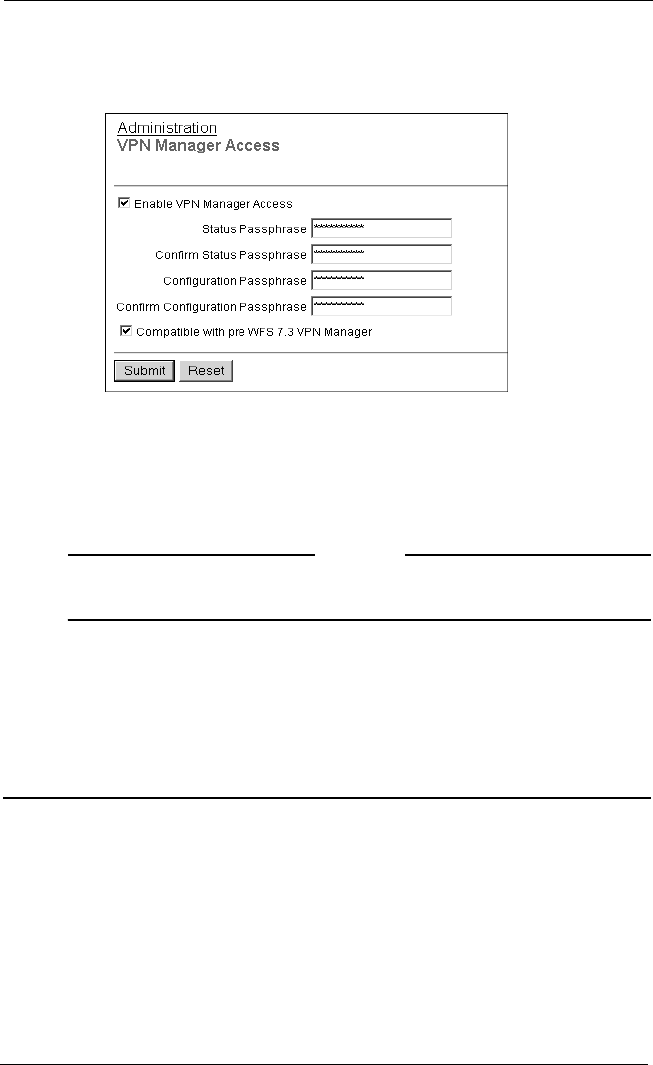
Updating the Firmware
User Guide 159
2From the navigation bar, select
Administration > VPN Manager Access.
The VPN Manager Access page appears.
3Select the Enable VPN Manager Access checkbox.
4Type the status passphrase and then type it again to confirm in
the applicable fields.
5Type the configuration passphrase and then type it again to
confirm in the applicable fields.
N
OTE
N
OTE
These passphrases must match the passphrases used in the VPN
Manager software or the connection will fail.
6Select the Compatible with pre WFS 7.3 VPN Manager button
if you want to use WatchGuard System Manager 7.0, 7.1, or 7.2
to manage your Edge.
7Click Submit.
Updating the Firmware
Check regularly for Firebox® X Edge updates on the WatchGuard
Web site:
https://www.watchguard.com/support/sohoresources
Two different methods exist for updating the firmware. One method
uses a slightly larger download and automatically updates the firm-
ware on the Firebox X Edge when run from any computer running
Windows. The other method uses a smaller download and allows

Managing the Firebox® X Edge
160 WatchGuard Firebox X Edge
you to update the firmware through the Firebox X Edge Web pages.
If you configure your Firebox X Edge from a computer that does not
use the Windows operating system, such as Macintosh or Linux, you
must update your firmware with the second procedure because
those operating systems cannot run Windows executable files.
Method 1
The first method uses an auto-executable file and is the preferred
method for updating the Firebox X Edge firmware from a Windows
computer. Download the Software Update Installer to use this
method. To use the Software Update Installer:
1Launch the installer on a computer running Windows that is on
the trusted side of the Firebox X Edge.
2The installer prompts for an IP address and a user name and
password. Enter the Firebox X Edge’s trusted interface IP
address.
By default this is 192.168.111.1
3Enter the administrator name and password. Click OK.
The installer updates the firmware on the Firebox X Edge. As part of the
update process, the Firebox X Edge will reboot once or twice— this is
normal.
4When the Finish button appears, click it.
N
OTE
N
OTE
Because the Installer uses FTP to transfer files, make sure your
Firebox X Edge is not configured to deny FTP access, as described
in “Denying FTP access to the trusted network interface” on
page 86.
Method 2
The second method uses the Firebox X Edge Web pages. You can use
this method regardless of the operating system your computer is
running. You must first download the Software Update file, a small
Zip file.
1Extract the “wgrd” file from the Zip file you downloaded using
an archiving utility such as Winzip (for Windows computers),
Stuffit (for Macintosh), or Linux’s archive capabilities.

Activating Upgrade Options
User Guide 161
2Type the IP address of the trusted network in your browser
window to connect to the System Status page of the Firebox X
Edge.
The default IP address is: https://192.168.111.1
3From the navigation bar, select
Administration > Update.
The Administration Page appears with the End User License Agreement
(EULA).
4Read the text of the EULA. If you agree, select the I accept the
above license agreement checkbox.
5Type the name of the file containing the new Firebox X Edge
software in the Select file box. Or click Browse to locate the file
on the network.
6Click Update and folloow the instructions.
Activating Upgrade Options
Every Firebox® X Edge includes the software for all upgrade options,
although they are not available for your use until you enter a license
key for them in the configuration of the Firebox. To receive a license
key, purchase and activate an upgrade option at the LiveSecurity
Service Web site or from a WatchGuard-authorized reseller. See
“Registering Your Edge and Activating LiveSecurity Service” on
page 26 for more information.
After you have purchased an upgrade option, follow these steps to
activate it:
1Go to the upgrade page of the WatchGuard Web site:
http://www.watchguard.com/upgrade
2Type your LiveSecurity Service user name and password in the
fields provided.
3Click Log In.
4Follow the instructions provided on the Web site to activate
your license key and to retrieve the feature key.
5Copy the feature key from the LiveSecurity Service Web site.
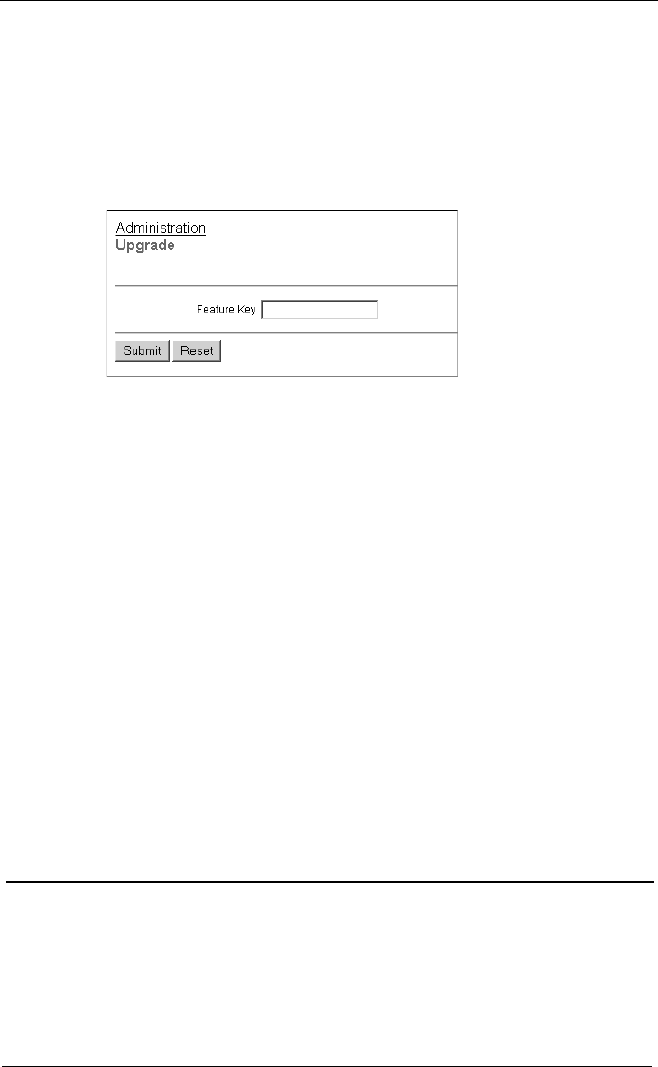
Managing the Firebox® X Edge
162 WatchGuard Firebox X Edge
6Type the IP address of the trusted network in your browser
window to connect to the System Status page of the Firebox X
Edge.
The default IP address is: https://192.168.111.1
7From the navigation bar, select
Administration > Upgrade.
The Upgrade page appears.
8Paste the feature key in the applicable field.
9Click Submit.
Upgrade options
User licenses
A seat license upgrade allows more connections between the
trusted network and the external network. For example, a 10-
seat license allows 10 connections instead of the standard five
connections.
MUVPN Clients
The MUVPN Clients upgrade allows remote users to connect to
the Firebox X Edge through a secure (IPSec) VPN tunnel. These
users have access to trusted network resources.
WebBlocker
The WebBlocker upgrade enables the Web filtering option. For
more information on WebBlocker, see the “Configuring
WebBlocker” chapter.
Enabling the Model Upgrade Option
A model upgrade gives you the same capability you would get if you
purchased the higher model. For example, an upgrade from Firebox
X5 to X50 is like getting a new Firebox X50 right off the shelf. A
model upgrade provides increased speed, greater capacity, more user

Configuring Additional Options
User Guide 163
licenses, more concurrent sessions, and more VPN tunnels. For a
datasheet showing the capabilities of the different Firebox X Edge
models, go to:
http://www.watchguard.com/docs/datasheet/edge_ds.asp
You can upgrade an X5 or an X15 to any higher model.
1Go to the Activation Center on the WatchGuard Web site
(www.watchguard.com/upgrade) and log into your LiveSecurity
Service account.
2In the space provided, enter the license key exactly the way it
appears on your printed certificate or your online store receipt,
including any hyphens. Click Continue and follow the
instructions.
Configuring Additional Options
Other options for your Firebox® X Edge do not require that you pur-
chase them separately. However, they are initially disabled on your
Firebox, and you must configure them. These options are as follows:
Managed VPN
The managed VPN feature allows you to set up VPN tunnels
using DVCP. For more information, see Chapter 8, “Configuring
VPNs.”
Manual VPN
The manual VPN feature allows you to set up VPN tunnels
manually. For more information, see Chapter 8, “Configuring
VPNs.”
WAN Failover
The WAN failover feature adds redundant support for the
external interface. For more information, see “Enabling the WAN
Failover Option” on page 64.
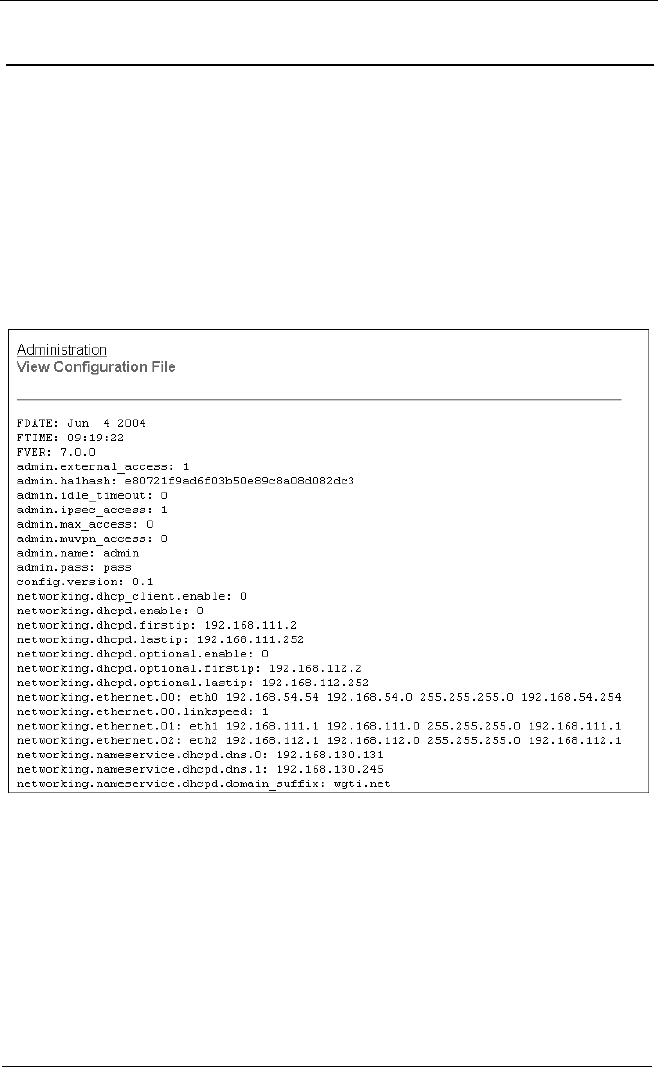
Managing the Firebox® X Edge
164 WatchGuard Firebox X Edge
Viewing the Configuration File
You can view the contents of the Firebox® X Edge configuration file
in text format from the View Configuration page.
1Type the IP address of the trusted network in your browser
window to connect to the System Status page of the Firebox X
Edge.
The default IP address is: https://192.168.111.1
2From the navigation bar on the left side, select
Administration > View Configuration File.
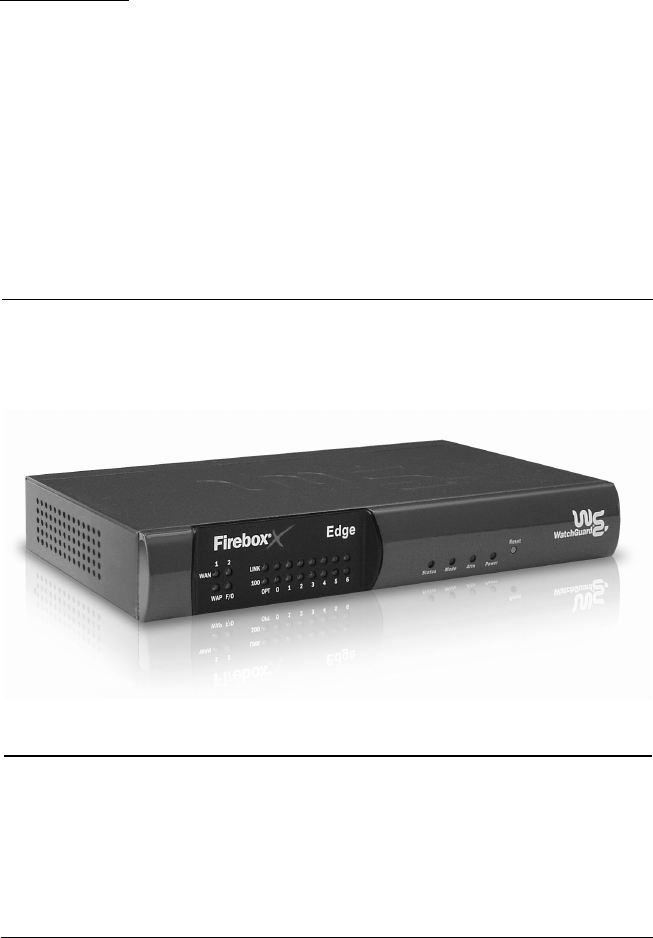
User Guide 165
APPENDIX A Firebox®X Edge
Hardware
The WatchGuard® Firebox® X Edge is a firewall for small organizations
and branch offices. The WatchGuard Firebox X Edge wireless has a
built-in access point for connecting computers with wireless capability.
Package Contents
The Firebox® X Edge package also has:
• The Firebox X Edge
User Guide
• The Firebox X Edge
QuickStart Guide
• A LiveSecurity® Service activation card
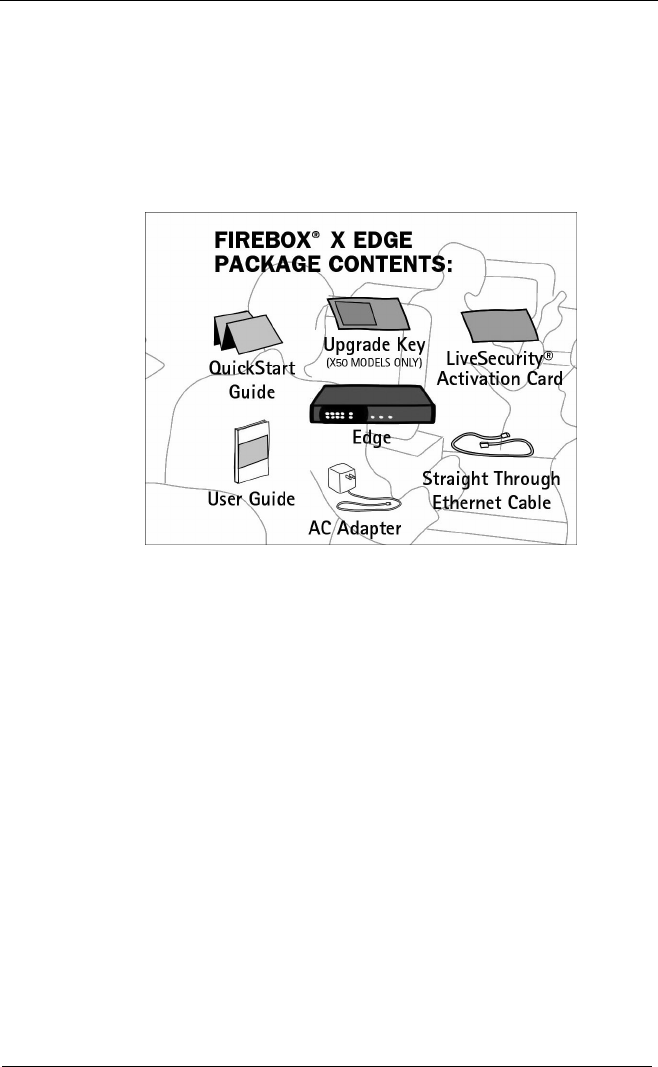
166 WatchGuard Firebox X Edge
• A Hardware Warranty Card
• An AC adapter (12 V)
• Power cable clip, to attach to the cable and connect to the side
of the Edge. This releases tension on the power cable.
• One straight-through cable
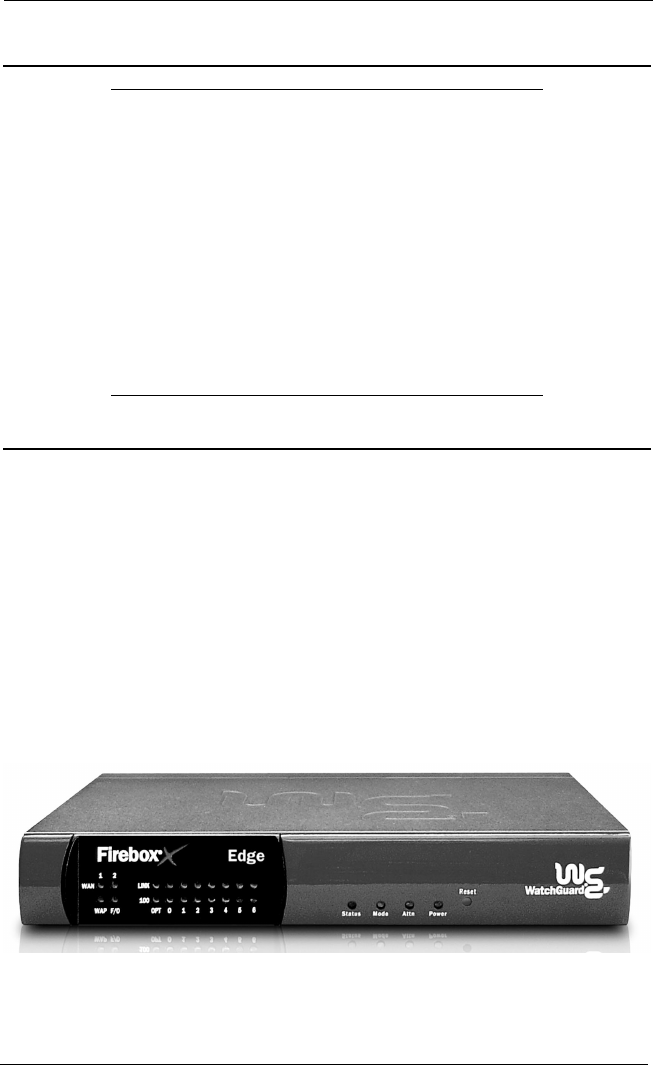
Specifications
User Guide 167
Specifications
Hardware Description
The Firebox X Edge has a simple hardware architecture. All indicator
lights appear on the front panel while all ports and connectors are
on the rear of the device.
Front panel
The front panel of the Firebox X Edge has 24 indicator lights to
show the link status. The top indicator light in each link pair comes
on when a link is established and flashes when traffic goes through
the related interface. The bottom indicator light in each pair comes
on when the link speed is 100 Mbps. If the bottom indicator light
does not come on, the link speed is 10 Mbps.
Processor 64 bit MIPS
Memory - Flash 16 MB
Memory - RAM 64 MB
Ethernet interfaces 10 each 10/100
Serial ports 1 DB9
Power supply 12V DC
Operating Temperature 0 - 40C
Dimensions Depth = 5.75 inches
Width = 8.75 inches
Height = 1.25 inches
Weight 1.9 U.S. pounds

168 WatchGuard Firebox X Edge
WAN 1, 2
Shows a physical connection to the external Ethernet interfaces.
The indicator light is yellow when traffic goes through the
related interface.
WAP
Shows a wireless connection to the Edge. The indicator light is
green when traffic goes through the wireless interface on a
Firebox X Edge Wireless model.
F/O
Shows a WAN failover. The indicator light is green when there is
a WAN failover from WAN1 to WAN2. The indicator light goes
off when the external interface connection goes back to WAN1.
Link
The link indicator light shows a physical connection to a trusted
Ethernet interface. The trusted interfaces have the numbers 0
through 6. The indicator light comes on when traffic goes
through the related interface.
100
When a trusted network interface operates at 100 Mbps, the
related 100 indicator light comes on. When it operates at 10
Mbps, the indicator light does not come on.
Status
Shows a management connection to the Edge. The indicator
light goes on when you use your browser to connect to the Edge
configuration pages. The indicator light goes off a short time
after you close your browser.
Mode
Shows the status of the external network connection. The
indicator light comes on when the Ethernet cable is correctly
connected to the WAN1 interface. The indicator light is green if
the Edge can connect to the external network and send traffic.
The indicator light flashes if the Edge cannot connect to the
external network and send traffic.
Attn
Reserved for future use.
Power
Shows that the Firebox X Edge is on.
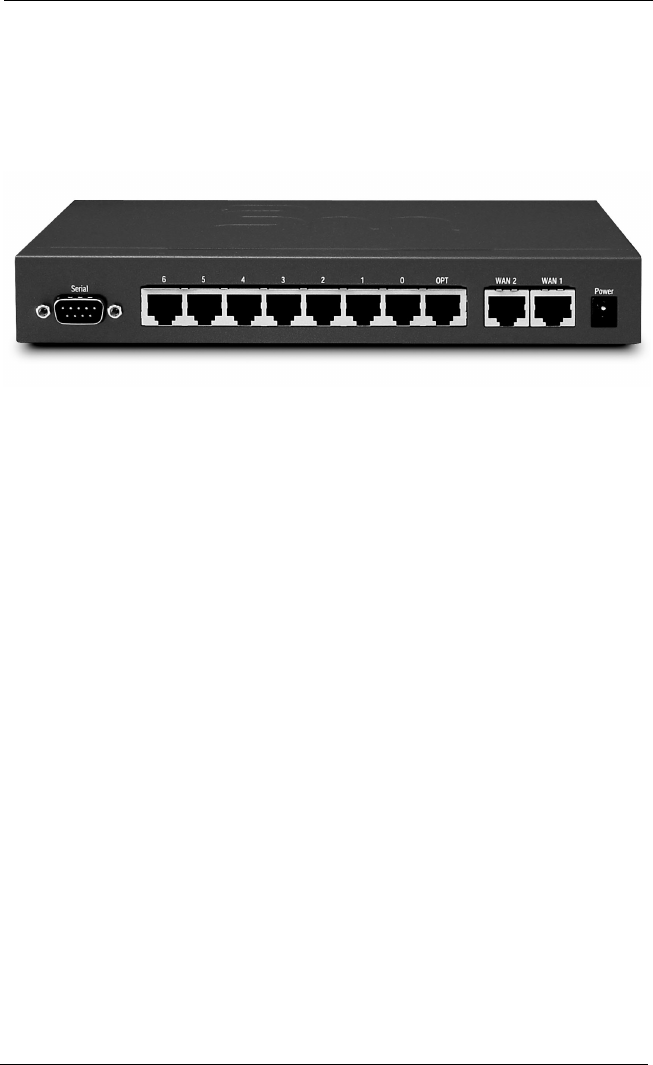
Hardware Description
User Guide 169
RESET button
Push the RESET button to set the Firebox X Edge to the factory
default configuration. For more information, see “Factory
Default Settings” on page 41.
Back view
Serial port (DB9)
Use the serial port to connect an external modem to the Edge.
Ethernet interfaces 0 through 6
The 7 Ethernet interfaces with the marks 0 through 6 are for the
trusted network.
OPT interface
This Ethernet interface is for the optional network.
WAN interfaces 1 and 2
The WAN1 and WAN2 interfaces are for the external network.
Power input
We supply a 12-volt AC adaptor with your Edge. Connect the AC
adapter to the Edge and to a power source. The power supply tip
is plus (+) polarity.
Side panels
Computer Lock Slot
There is a slot for a computer lock on the two side panels of the
Firebox X Edge.
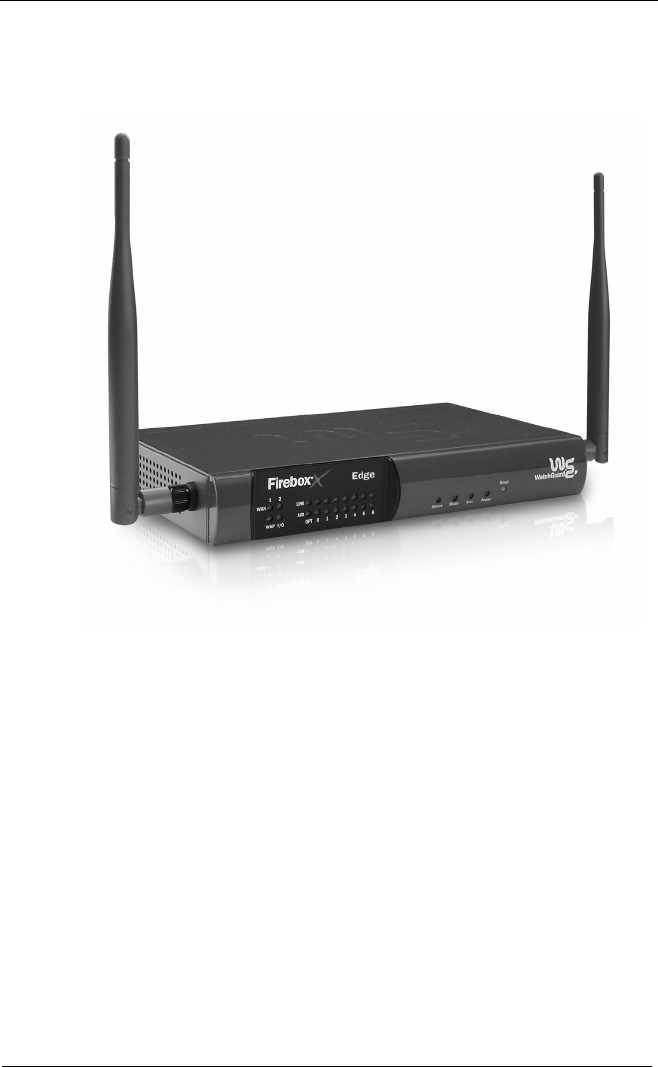
170 WatchGuard Firebox X Edge
Antennae (wireless model only)
There are wireless antennae on the two side panels of the Firebox
X Edge wireless models.

User Guide 171
Index
Symbols
.wgx files 132
A
Add Gateway page 113
Add Route page 61, 78
Administration page 35
administrator account 154
Allowed Hardware Addresses page 77
Allowed Sites pages 104
Automatically restore lost connections
checkbox 26, 49
B
bandwidth, described 3
Blocked Sites page 84
broadband connections 2
C
cable modem 2
cables
included in package 12, 166
cabling
for 0-6 devices 17
for 1 - 4 appliances 70
for 5+ appliances 71
for 7+ devices 18
CIDR notation 116
Classless Inter Domain Routing 116
Client for Microsoft Networks,
installing 123, 127
client, described 2
configuration file, viewing 164
configuration pages
connecting to 20
description 29–39
navigating 29
opening 30
configuration pages. See also pages
Connection Monitor 139
custom incoming services, creating 82
Custom Service page 82

172 WatchGuard Firebox X Edge
D
daylight savings time 95
default factory settings 41–42
Denied Sites page 104
DHCP
described 5, 47
setting the Firebox to use 23
setting your computer to use 20
DHCP address reservations
setting on the optional network 58
setting on the trusted network 53
DHCP Address Reservations page 53, 58
DHCP relay
configuring the optional network 58
configuring the trusted network 53
DHCP relay agent, configuring Firebox
as 54
DHCP relay agent, configuring the
optional network as 59
DHCP server
configuring Firebox as 51, 56
dialog boxes
Internet Protocol (TCP/IP) Properties
21
Dial-Up Networking, installing 123
Diffie-Hellman groups 115
Digital Subscriber Line (DSL) 2
DNS service, dynamic 62
DNS, described 6
Domain Name Service
described 6
DSL 3
DVCP, described 111
Dynamic DNS client page 63
dynamic DNS service, registering with
62–63
Dynamic Host Configuration Protocol.
See DHCP
Dynamic VPN Configuration Protocol,
described 111
E
echo host 118
Enable PPPoE debug trace checkbox 26,
49
encrypted connections on optional
network 60
event, described 91
external interface
configuring 23–26
external network
described 9
if ISP uses DHCP 47
if ISP uses PPPoE 48
if ISP uses static addressing 48
External Network Configuration page
25
F
factory default settings
described 41
resetting to 42
failover network. See WAN failover
feature key
described 26
File and Printer Sharing for Microsoft
Networks
and Windows XP 129
File and Printer Sharing for Microsoft
Networks, installing 127
Filter Traffic page 80, 83
Firebox Users page 34, 152, 155
Firebox X Edge
administrator account 154
cabling 17
configuring as DHCP server 51
described 165
front panel 167
hardware description 167–169
hardware specifications 167
indicator lights 167
installing 11–27
package contents 12, 165
rebooting 42–44

User Guide 173
registering 26
resetting to factory default 42
updating software 40
upgrade options 161
viewing log messages for 91
Web pages. See configuration pages
Firewall Options page 85
Firewall page 36
firewalls, described 8
firmware, updating 159
H
hardware description 167–169
hardware operating specifications 169
hardware specifications 167
HTTP proxy settings, disabling 15
HTTP/HTTPS, using for Firebox
management 157
https
//www.watchguard.com/support/
advancedfaqs/sogen_dyndns.asp
62
//www.watchguard.com/support/
advancedfaqs/
sogen_setupdyndns.asp 62
I
incoming service, creating custom 82
indicator lights 167
installation
cabling 70
described 69
determining TCP/IP settings 13
disabling TCP/IP proxy settings 15
physical connections 70
TCP/IP properties 13
installation requirements 12
installing the Firebox X Edge 11–27
Internet
how information travels on 3
options for connecting to 2
Internet connection, required for
Firebox X Edge 13
Internet Protocol (IP) 3
Internet Protocol (TCP/IP) Network
Component
and Windows XP 129
Internet Protocol (TCP/IP) network
component, installing 127
Internet Protocol (TCP/IP) Properties
dialog box 21
IP addresses
described 5
dynamic 5
giving your computer static 20, 21
setting static 24
static 47
L
LiveSecurity Service
and software updates 40
registering with 26
Local Area Network (LAN)
described 2
log messages
contents of 91, 92
viewing 91
Log Viewer 138
logging
configuring 91–95
described 91
to Syslog host 93
to WSEP lot host 92
logging in for the first time 31
Logging page 37, 92
M
Managed VPN page 112
Manual VPN page 113
MUVPN client
allowing through firewall 137
connecting 135
described 121

174 WatchGuard Firebox X Edge
disconnecting 138
icon for 136–137
installing 131
monitoring 138–140
preparing remote computers for
122–130
troubleshooting 142–144
uninstalling 132
MUVPN Clients upgrade 162
N
navigation bar 31
netmask 13
network address translation (NAT) 14
Network Interface Wizard, see Quick
Setup Wizard
network interfaces, configuring 45–66
Network page 33
network security, described 1
Network Statistics page 62
network statistics, viewing 62
Network Time Protocol 96
networks, types of 2
NTP 96
numbered ports 169
O
optional network
assigning static IP addresses on 59
changing IP address of 55
configuring 55–??
configuring additional computers
on 59
described 9
enabling 55
requiring encrypted connections on
60
setting DHCP address reservations
on 58
using DHCP on 56
using DHCP relay on 58
Optional Network Configuration page
55, 56, 57, 58, 59
options
Managed VPN 163
Manual VPN 163
MUVPN Clients 162
seat license upgrade 162
WAN failover 163
WebBlocker 162
P
package contents 12
packets, described 4
pages
Add Gateway 113
Add Route 61, 78
Administration 35
Allowed Hardware Addresses 77
Allowed Sites 104
Blocked Sites 84
Custom Service 82
Denied Sites 104
DHCP Address Reservations 53, 58
Dynamic DNS client 63
External Network Configuration 25
Filter Traffic 80, 83
Firebox Users 34, 152, 155
Firewall 36
Firewall Options 85
Logging 37, 92
Managed VPN 11 2
Manual VPN 113
Network 33
Network Statistics 62
Optional Network Configuration 55,
56, 57, 58, 59
Routes 61, 78
Settings 149
Syslog Logging 94
System Security 157
System Status 22, 25, 29, 32, 75, 78,
82, 83, 85
System Time 95

User Guide 175
Trusted Hosts 106
Trusted Network Configuration 51,
52, 53, 54, 146
Upgrade 162
VPN 39
VPN Keep Alive 118
VPN Manager Access 158, 159
VPN Statistics 11 8
WAN Failover 65
WatchGuard Security Event
Processor Logging 93
WebBlocker 38
WebBlocker Settings 99, 100
Wireless Network Configuration 73,
75
Wizards 39
passphrases, described 152, 155
Perfect Forward Secrecy 116
Phase 1 settings 114 , 115
Phase 2 settings 116
Pocket PCs, creating tunnels to 135
Point-to-Point Protocol over Ethernet.
See PPPoE
ports
described 7
numbered 169
trusted network 169
used by Edge 20
WAN 169
WAN1 64
WAN2 64
power input 169
PPPoE
described 6, 47
entering settings 24
PPPoE debug trace, activating 26
profiles
creating WebBlocker 99–100
protocols
described 3
IP 3
TCP, UDP 3
TCP/IP 3
proxy, described 15
Q
Quick Setup Wizard 45
R
rebooting 42–44
Remote Access Services, installing 125
RESET button 169
resetting to factory default 42
Routes page 61, 78
routes, configuring static 78
S
seat licenses 71
upgrade 162
seat limitation 18, 71
serial number, viewing 32
server, described 2
services
creating custom 82–83
creating custom incoming 82
described 6
sessions
closing 147
described 145
viewing currently active 146
Settings page 149
shared key 114
shared secret 110
SOCKS
configuring 87
configuring for SOHO 6 86
described 86
disabling 87
software updates 40
SOHO 6
and SOCKS 86
serial number 12
SOHO 6 Wireless
physically connecting to 70

176 WatchGuard Firebox X Edge
static IP addresses
and VPNs 118
obtaining 119
static routes
making 60
removing 61
static routes, configuring 78
SurfControl 98
Syslog Logging page 94
Syslog, described 93
Syslost host, logging to 93
system configuration pages. See
configuration pages
system requirements 122
System Security page 157
System Status page 22, 25, 29, 32, 75,
78, 82, 83, 85
system time
setting 94
setting manually 96
setting using NTP 96
System Time page 95
T
TCP (Transmission Control Protocol) 3
TCP/IP properties 13
TCP/IP settings, determining 13–15
TCP/IP, described 3
time
setting 94
setting manually 96
setting using NTP 96
traffic
logging all outbound 88
Trusted Hosts page 106
trusted network
assigning static IP addresses on 54
changing IP address of 51
configuring 50–55, ??–60
configuring additional computers
on 54
denying FTP access to 86
described 8
Trusted Network Configuration page
51, 52, 53, 54, 146
U
UDP (User Datagram Protocol) 3
Uniform Resource Locator (URL) 6
updating firmware 159
updating software 40
upgrade options, activating 161
Upgrade page 162
user accounts
configuring settings for all 134, 149,
151
creating new 152
deleting 148
editing 148
setting WebBlocker profile for 154
using on the optional network 56
using on the trusted network 51
V
VPN Keep Alive page 11 8
VPN Manager
described 158
setting up access to 158–159
VPN Manager Access page 158, 159
VPN page 39
VPN Statistics page 118
VPN tunnels, setting up multiple 11 3
VPNs
and static IP addresses 118
creating manual 113
creating using VPN Manager 113
described 107
encryption for 109
Keep Alive feature 117
special considerations for 109
troubleshooting connections 11 9
viewing statistics 118
what you need to create 107

User Guide 177
W
WAN Failover
configuring 65
described 64, 163
WAN Failover page 65
WAN ports 169
WAN1 port 64
WAN2 port 64
WatchGuard Security Event Processor
92
WatchGuard Security Event Processor
Logging page 93
Web sites, blocking specific 104
WebBlocker
allowing internal hosts to bypass
106
allowing sites to bypass 103
categories 101–103
creating profiles 99–100
database 98
defining profile 154
described 97
WebBlocker page 38
WebBlocker Settings page 99, 100
Wide Area Network (WAN), described 2
Windows 2000
preparing for MUVPN clients 126
Windows 98/ME, preparing for MUVPN
clients 122
Windows NT
preparing for MUVPN clients 125
Windows XP
installing File and Printer Sharing
for Microsoft Networks on 129
installing Internet Protocol (TCP/IP)
Network Component on 129
preparing for MUVPN clients 128
WINS and DNS settings, configuring
124, 126, 127
wireless access point, setting up 73
wireless card, configuring 73
Wireless Encryption Privacy (WEP) 75
Wireless Network Configuration page
73, 75
wireless networks
described ??–70
security 74
wizards
Quick Setup 45
Wizards page 39
WSEP 92
Z
ZoneAlarm
allowing traffic through 140
described 121, 140
icon for 138
shutting down 141
uninstalling 141

178 WatchGuard Firebox X Edge